



3 October 2019 – 5 January 2020, Daily. Free Entry
The roar of an airplane is a familiar sound for many parts of west London, home to one of the busiest airports in the world and the subject of a new exhibition, Air Matters at Watermans Arts Centre in Brentford, just a few miles away from Heathrow.
Echoing the experience of hearing an aircraft in action, sound itself plays an integral part in the show and leads with The Substitute (2019) by Hermione Spriggs and Laura Cooper. Through overhead speakers outside the main entrance, visitors are greeted by an authoritative voice musing on the fate of local flocks in an airspace strictly controlled by humans and their contraptions, intermittently reciting names of affected birds like a tribute, and ultimately urging listeners to “work with nature” which sets a critical tone.
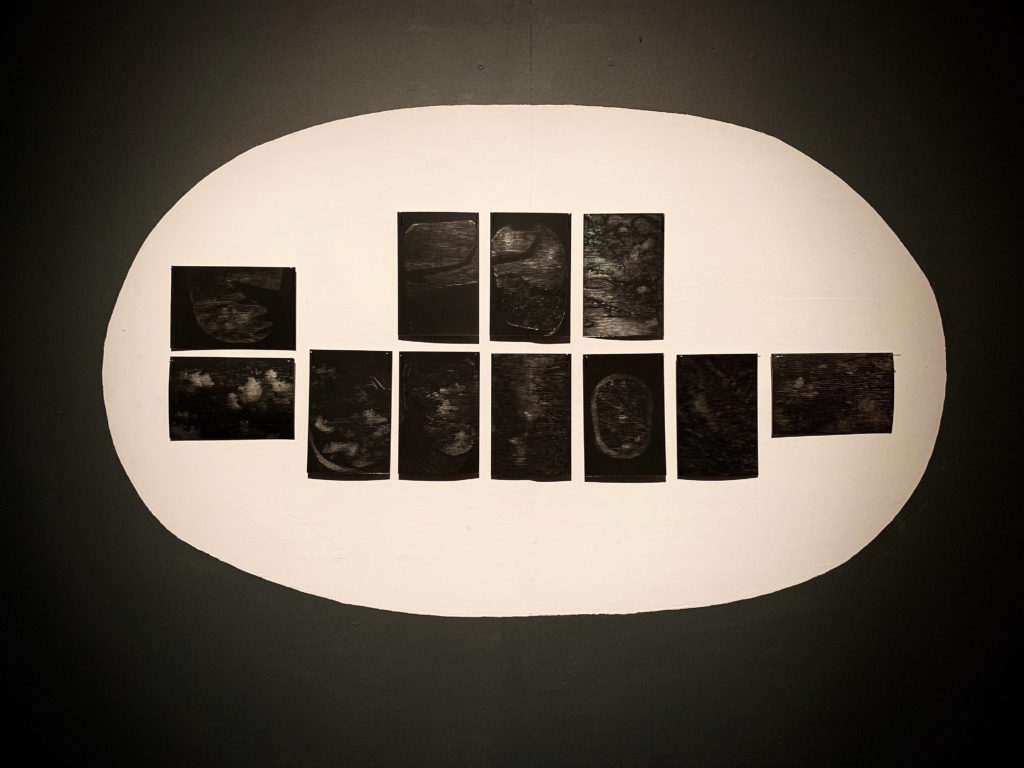
The audio installation is reminiscent of public announcements at airports, a strategy that continues into the foyer with Frequency (2019) by Louise K Wilson. It features intimate anecdotes of air travel through resonance devices on a skylight roof where planes might fly by at any moment. Speaking softly akin to ASMR, one person wonders about the destinations of travellers, while another recalls vivid memories of flights that seem traumatic, bouncing back and forth between excitement and anxiety.
The theme reaches its crescendo inside the gallery, with a mixture of ambient sounds reverberating across the space from Ascending Composition I (For Planes) (2019) by Kate Carr, an atmospheric concoction of incidental noises recorded around Heathrow including birds, markets, and trains on tracks. With pocket-sized media players attached to deconstructed speakers on strings of fabric, the installation documents an intervention that already took place when the work itself flew up on balloons blasting whispers from the ground, a small but meaningful gesture challenging the sonic waves of jumbo jets that dominate the surrounding sky and soundscape.
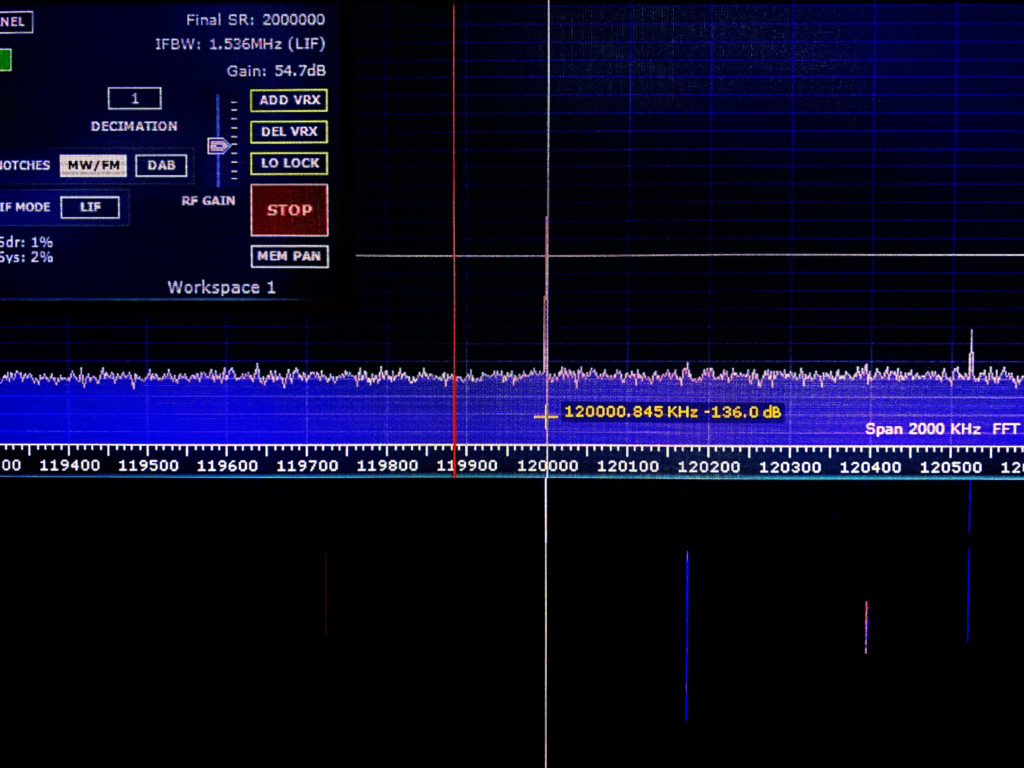
This act of defiance flows into Skyport (2019) by Magz Hall, a mixed media installation with a set of frequency scanners emitting an unsettling static. The title refers to a pirate radio station based along a Heathrow flightpath in the 1970s, illustrated with archival images and texts from an attempt to reclaim airwaves colonised by traffic control and engine noise. The work emulates this spirit with an LCD screen broadcasting airport channels as visual wavelengths, the contents of which are protected as classified information in UK law, consequently questioning ownership, access, and authority over radio frequencies.
The symphony of sounds become unavoidable throughout, and there is a possibility that it might grow vexing for some, perhaps more so for the people that work here who may not have a choice but to hear it again and again. Yet, as irksome as that might be, it is a crucial part of what makes this show effective. The audible pieces collectively transform the spaces into simulations of airport lounges and peripheral towns, simultaneously mimicking and counteracting oppressive noises from airplanes and terminals that have become inevitable in contemporary life, irrespective of its value and/or harm.
Beyond aural tendencies, the exhibition reaches further by considering scale and movement. The sheer volume of Capsule (2019) by Nick Ferguson is an imposing presence in the gallery with a wooden sculpture modelled after the wheel bay of a Boeing 777, floating a few inches off the ground and hovering over visitors. Shown alongside printed images of microscopic substances found in a real plane, it orchestrates a juxtaposition between the enormity of a flying machine and the imperceptible residue it accumulates, revealing traces from the many places it has been including sand, spores, and bacteria.
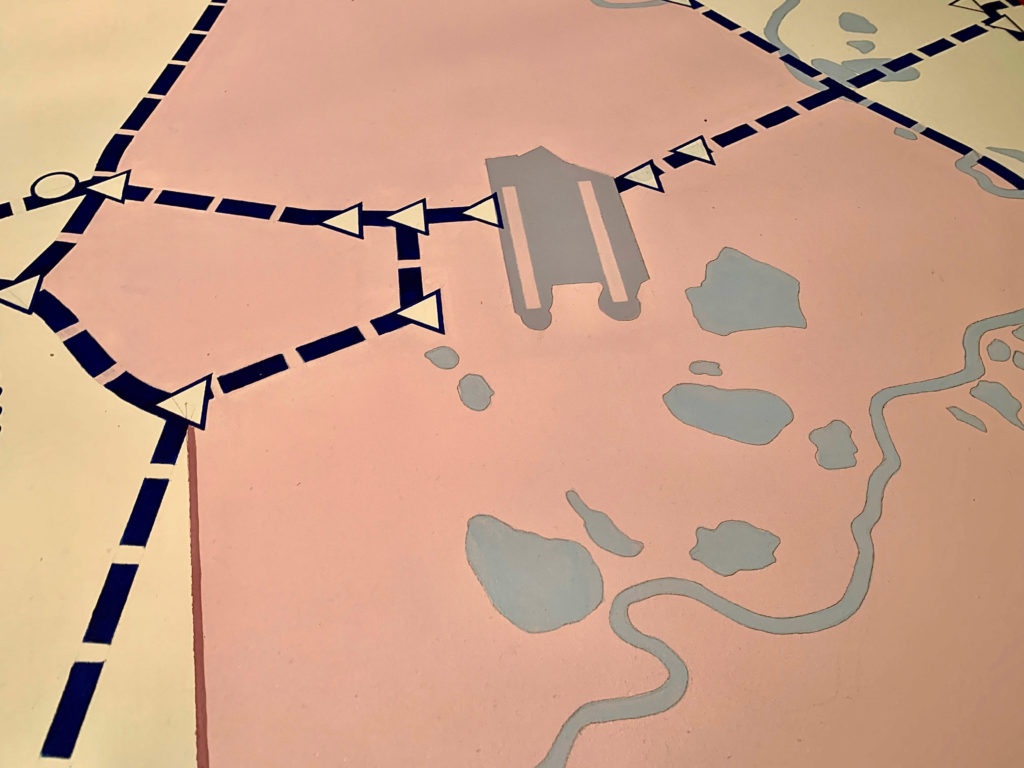
A map nearby, Heathrow (Volumetric Airspace Structures) (2019) by Matthew Flintham, takes the viewer back to west London with a bird’s eye view of the airport complex. Presented on a table that might be used for urban planning, military operation, or board games, it illustrates the topography of the area highlighting a vast infrastructure beneath large sections of controlled airspace, seemingly encroaching on everything else which becomes almost invisible or insignificant.
Navigating the show functions as an exercise of remembrance in many ways, bringing to mind a number of issues that have been at the forefront of public discourse in recent years: from the role of aviation on climate change, to its impact on local communities and ecosystems around airports. And it comes, as if on cue, at a period of heightened environmental concern, propelled most prominently by the Extinction Rebellion movement and climate activist Greta Thunberg, ringing the alarm on the perils of flying.
The controversial Heathrow Airport Expansion also comes through in this context, caught between government plans for future economic growth, and the ongoing resistance from neighbouring residents with campaigns like Stop Heathrow Expansion, No Third Runway Coalition, and Heathrow Association for the Control of Aircraft Noise.
It conjures up conflicting perspectives that unpack a classic dilemma for a society in flux. On one hand, the flight industry is evidently harmful because of its pollution to the planet and the unfair toll on local hosts. Yet, on the other, it is part of a system that facilitates international trade, freedom of movement, and cultural exchanges, each one increasingly more accessible to broader people beyond a privileged few who will always have it. And while it has serious problems that must be addressed, some of which are rightly pointed out here, a world without it entirely is at risk of descent into tribalism and isolationism.
With so much at stake at this particular time and place, the exhibition feels important for its worthwhile attempt in raising these pertinent questions through art, successfully using Heathrow as a case study for matters that undoubtedly have wider implications.
Like the rumble of a plane and many works in this show, the politics of flying will become inescapable as air travel is projected to almost double in size by 2036, despite recent backlash from flight shaming, the rise of staycation, and a spotlight on frequent flyers. The solutions to its unintended consequences are not as straightforward as it might seem, and will likely require a nuanced approach combining systemic changes, paradigm shifts, technological developments, and personal adjustments, all of which cannot come soon enough.
Air Matters: Learning From Heathrow is at Watermans Arts Centre until 5 January 2020. Curated by Nicholas Ferguson in collaboration with Klio Krajewska. Supported by Arts Council England, Forma, London Borough of Hounslow, Kingston School of Art, and Richmond University.
Featured main image: Kate Carr. Image 11. NF. Ascending Composition 1 (For planes). Mixed media, 2019. Included in Air Matters: Learning from Heathrow. 3 October – 5 January 2019.
A list of recommendations, reflecting the dynamic culture we are part of, straddling the fields of art, technology and social change.
Events, Exhibitions, Festivals and Conferences
Playmode | Exhibition at MAAT Lisbon, Sep 2019 – feb 2020 | Curated by Filipe Pais and Patricia Gouveia | It is said that play has saved entire peoples, who, in order not to succumb to hunger, resorted to playing games for hours at a time. While the Lydians, that distant people from Anatolia, invented games as a mode of surviving, play from the beginning has been an invention linked to a vital need — to stay alive and withstand the darkness, immobility and extinction.
The artists understood early on the transformative power of play and began integrating it into their works for various purposes – escaping reality, social construction and transformation, subversion or as a criticism of game and play mechanisms themselves – https://www.filipepais.com/playmode
The Long Term You Cannot Afford. On The Distribution of The Toxic | At SAVVY-Contemporary, Berlin, Germany | 19 Oct 2019 – 1 Dec 2019 | This mixed exhibition unpacks the kaleidoscopic meanings of the toxic, both as matter and as metaphor: In his paintings, Boris Anje captures the essence of the excessive and toxic consumerism of a small minority of the world’s population | The toxic trade-off inherent in exploitative and abusive processes of extraction, production, and disposal lie at the heart of the changing nature of the ecosystems to which we now belong – with millions of metric tons of synthetic materials, pesticides, heavy metals, and chemicals released and circulated every year. Structural inequalities on a global scale permit for some lives to remain relatively untouched by toxic proliferation through systems of “externalisation” [2] whilst many reside in high concentrations and lethal exposure on a daily basis out of mere necessity of survival. The new age of toxicity is “a condition that is shared, but unevenly so, and which divides us as much as it binds us.” – http://tiny.cc/y8ryez
Soft Power 04: an exhibition in a spreadsheet | Hosted by Micheál O’Connell, Andrea Slater and Daniella Norton | Thursday, 31 October 2019 | A fourth exhibition by the Soft Power people, this time in a spreadsheet. Look at it at home, or on your device, or wherever. Drink some wine and chat to friends about what you witness. The link will be supplied with those ‘GOING’ on the date (Thursday 31st October) at 7pm. For updates sign up to Mocksim’s mailing list http://www.mocksim.org/contact.htm
24/7: A wake-up call for our non-stop world | 31 Oct 2019 – 23 Feb 2020 | Somerset House |Embankment Galleries, South Wing | An essential exhibition for today, exploring the non-stop nature of modern life. Many of us feel we’re working more intensively, juggling too many things, blurring our public and private lives, pushing the limits of our natural rhythms of sleep and waking.
24/7 takes visitors on a multi-sensory journey from the cold light of the moon to the fading warmth of sunset through five themed zones and contains over 50 multi-disciplinary works that will provoke and entertain | Inspired by Jonathan Crary’s book of the same name, and curated by Sarah Cook, 24/7& holds up a mirror to our always-on culture and invites you to step outside of your day-to-day routine to engage, reflect and reset – http://tiny.cc/44f7ez
Launch event for Rabbrexit – A Game of Chance / editions tdwm | Hosted by Cecilia Wee and YiMiao Shih | Thursday, 31 October 2019 (London) | On the date of the Brexit deadline, we’re having a little launch party for “Rabbrexit – A Game of Chance” and the birth of editions tdwm. Editions tdwm is delighted to present its first project: a limited edition set of playing cards “Rabbrexit – A Game of Chance”, featuring illustrations by YiMiao Shih, designed with Arjun Harrison-Mann.
Rabbrexit – A Game of Chance reworks images from YiMiao Shih’s exhibition Rabbrexit Means Rabbrexit at the House of Illustration in London (2019), where YiMiao created a parallel universe in which the UK voted not for Brexit but ‘Rabbrexit’: the expulsion of rabbits from the country – http://tiny.cc/p3oyez
Become Ungovernable 2: a day of resistance skill sharing | The Antiuniversity, as part of a coalition of autonomous left groups, invites you to a day of practical and informative workshops, where we will learn from each other simple visual intervention methods that anyone can pick up, grow confidence to use a variety of tools and learn about ways to stay safe when organising on the streets and online. In preparation for the planned attack on our city and communities on 31 Oct (Brexit day), we planned a day of practical resistance skill sharing.
The far right, bolstered by a racist and xenophobic government, is growing in confidence. The response to Boris Johnson’s hard-right vision for society and threat to our basic rights must be equally confident. Some actions will take place through whatever is left of the parliamentary mechanism, others will take place on the streets. Hosted by Antiuniversity, Green Anti-Capitalist Front, Plan C, Feminist Anti-Fascist Assembly, and Women’s Strike Assembly | FB page – http://tiny.cc/1qoyez
NEoN Digital Arts Festival. Multiple Venues in Dundee City, Scotland. Nov 6 – 8 2019. An expanded 3-day symposium entitled, Re@ct: Social Change Art Technology. NEoN Re@ct involves over 30 international speakers over three days addressing a diversity of issues and practices engaging activist digital art. Many artists involved in digital arts have historically been prompted to react and respond to local, national, global, social and political crises (i.e. around issues of environmentalism, gender equality, exploitation, colonialism, militarism, emancipation). Re@ct will be a platform to critically examine the relevance and impact of past and present practices, theories and strategies – to engage an uncertain future through an exploration of the creative potential of digital art. Reigister free to the full symposium – http://tiny.cc/y5lyez
Citizens of Nowhere | Alicja Rogalska: 2019 Stuart Hall Library Artist-in-Residence | Hosted by Iniva | 6 November 2019 | Join 2019 Stuart Hall Library Artist-in-Residence Alicja Rogalska for a screening and discussion about her work developed during the residency alongside two other videos. The three works are concerned with issues of citizenship, immigration and identity, viewed through the lenses of classification methods and systems, legal fictions in immigration law and the lived experiences of statelessness. The screening will be followed by a discussion with invited guests and a Q&A.
The works screened will include: What If As If (2017), The Aliens Act (2019) and Citizens of Nowhere (2019). Total running time of the videos will be 40 mins | Evenbrite bookings here – http://tiny.cc/uiqyez
Books, Open Calls, Papers & Publications
Expanded Internet Art: Twenty-First-Century Artistic Practice and the Informational Milieu By Ceci Moss | Charting the rise of a multidisciplinary approach to online artistic practice in the past decade, the text discusses recent currents in contemporary artistic practice that parallel the explosion of the internet through advances such as social media, smart phones, and faster bandwidth. Internet art is no longer determined solely by its existence on the web; rather, contemporary artists are making more art about informational culture using various methods of both online and offline means. It asks how artists, such as Seth Price, Harm van den Dorpel, Kari Altmann, Artie Vierkant and Oliver Laric, create a critical language in response to the persuasive influence of informational capture on culture and expression, where the environment itself becomes reorganized to be more legible as information | Bloomsbury Academic – http://tiny.cc/ktg7ez
The Cyborg Matrix | Open call for artists, is now online at http://theCyborgMatrix.com !! Make an account and create your own profile. Or type in your name or nickname for a short visit. Doe you want to add you art to the space, go to http://cyarco.com/theCyborgMatrix/ or send us an email at cyborgMatrix@cyarco.com. see you in cyberspace!!
Automation, Artificial Intelligence, and Labour Protection | Comparative Labor Law & Policy Journal, Vol. 41, No. 1, 2019 | A collection of articles on “Automation, Artificial Intelligence, and Labour Protection” edited by Valerio De Stefano (KU Leuven). This collection gathers contributions from several labour lawyers and social scientists to provide an interdisciplinary overview of how new technologies, including smart robots, artificial intelligence and machine learning, and business practices such as People Analytics, management-by-algorithm, and the use of big data in workplaces, far from merely displacing jobs, profoundly affect the quality of work. The authors argue that these issues depend, and can be affected by, policy choices – since they are not just the “natural” result of technological innovations – and call for adequate regulation of these phenomena. Contributing authors are Antonio Aloisi, Ilaria Armaroli, Fernanda Bárcia de Mattos, Janine Berg, Miriam Cherry, Emanuele Dagnino, Valerio De Stefano, Elena Gramano, Matt Finkin, Marianne Furrer, Frank Hendrickx, Parminder Jeet Singh, David Kucera, Phoebe Moore, Jeremias Prassl, and Uma Rani. This article introduces this collection and gives an overview of the issues discussed by the authors – http://tiny.cc/s4zyez
Digital Sociology: The Reinvention of Social Research | By Noortje Marres (2017) | This provocative new introduction to the field of digital sociology offers a critical overview of interdisciplinary debates about new ways of knowing society that are emerging today at the interface of computing, media, social research and social life.
Digital Sociology introduces key concepts, methods and understandings that currently inform the development of specifically digital forms of social enquiry. Marres assesses the relevance and usefulness of digital methods, data and techniques for the study of sociological phenomena and evaluates the major claim that computation makes possible a new ‘science of society’. As Marres argues, the digital does much more than inspire innovation in social research: it forces us to engage anew with fundamental sociological questions. We must learn to appreciate that the digital has the capacity to throw into crisis existing knowledge frameworks and is likely to reconfigure wider relations | Polity press – http://tiny.cc/pqg7ez
Articles, Interviews & Presentations
Future Cities as a Network of Waterholes connected by Songlines | Medium | By Steven Liaros | “Irene Watson provides a detailed discussion of the indigenous worldview in Raw Law: Aboriginal Peoples, Colonialism and International Law (2015). Also referred to as relational philosophy, Watson compares and contrasts this with non-indigenous philosophy. This comparison is summarised in Table 1 in which I have included additional descriptions in brackets that express this contrast using other common terms.” – http://tiny.cc/rywyez
Brexit Culture | Feature article on ArtRabbit | By Sandy Di Yu | “Research has been conducted by the Arts Council about the economic and operational impacts of Brexit, but the content of culture has yet to be formally surveyed. While we can only speculate like everyone else what the full-fledged impact of Brexit on cultural production will be in the coming years, the era since the 2016 referendum has already seen a flurry of events that indicate growing precariousness in our time. Right-wing populism has gained more than a foothold in political discourse. Conspiracies run rampant about celebrity sex traffickers and their ties to the global elite. Anxiety over climate change, although leading to inspiring global movements, is still being met with dismissal by political leaders.” – http://tiny.cc/ujtyez
Can Musical Machines Be Expressive? Views from the Enlightenment and Today? by Steven Kemper and Rebecca Cypess | October 2019, Leonardo 52:5 release | How can music produced by automated technologies be expressive? Transitive theories of expression dominated eighteenth-century ideas of automated music, and many contemporary designers of robotic instruments adhere to these ideas, increasing sonic nuance to make their instruments seem more like expressive human performers. A listener-centered understanding of expression—an “intransitive” perspective—allows us to see automatic instruments as capable of expression despite the fact that no human performer is present – http://tiny.cc/m9nyez
Media Art History: Berlin, Cyber City (1989-91) VR – MR installation by Monika Fleischmann & Wolfgang Strauss | Berlin, Cyber City (1989-91) commemorates the 30th anniversary of the fall of the Berlin Wall 1989. VIDEO. The performative VR city simulation system “Berlin – Cyber City” was created as a reaction to the fall of the Berlin Wall. The intention was the staging of an interactive space for debate on the future of the city. To do this, the VR paradigm – the real-time movement in an immersive environment for a single user – should be extended into a communication space for several users. A participative Mixed Reality table combined with a 3D environment and Virtual Reality tools invites people to discuss the past and the future of the former divided city – http://tiny.cc/q2nyez
Neural 63, Surveillance Surveyed | Issue #63, Summer 2019 | interviews with Pip Thornton, Joana Moll, Mendi and Keith Obadike, Owen Mundy | articles, Surveying Surveillance Capitalism, Decode: Data Cooperatives, Our voices granted to machines, and much more – http://neural.it/2019/10/neural-63-surveillance-surveyed/
Image by: Brad Downey. House of Cards #3. Public Work. 2007, Berlin, Germany. Duration: 4 days. Anonymous installation. Material: paving stones – http://tiny.cc/vkf7ez | Currently featured in Playmode exhibition, Lisbon.
Furtherfield are looking for curators for collaboration in a short-term project based at their Gallery in London’s Finsbury Park
Connect for Creativity is an 18-month project led by the British Council, in partnership with Abdullah Gül University in Turkey and three creative hubs – ATÖLYE in Turkey, BİOS in Greece, Nova Iskra in Serbia. The project is co-funded by the European Union and the Republic of Turkey, through the Intercultural Dialogue programme.
The project features art and technology residencies which will bring artists, creatives and technologists from Turkey, the UK, Greece and Serbia together at each location to explore uses of creative technology to build bridges and empathy within and across societies.
“The residencies will result in immersive and multimedia-rich artwork, powered by techniques of design research, human-centered design and speculative design. The artists will be asked to question what hopes and fears are associated with rapidly changing work and life environments in contemporary society, how a networked culture can develop cohesion and how to deal with uncertainty and change.”
To work for a maximum of 6 days each, between 1st November 2019 and 28th February 2020 at €200 per day. Must be available to attend event at Furtherfield Commons between 5.00 and 9.00pm on 6th November.
If you are a curator with Turkish, Greek or Serbian heritage born or based in London we would love to hear from you. To apply please send a 1 page CV and 1 page covering letter explaining why the project interests you to info@furtherfield.org by 12.00pm Friday 18th October. Final candidates will be notified by Friday 25th October.
The Future Machine, part of Furtherfield’s Citizen Sci-Fi programme, has been built with local groups as a witness to people and places, changing over time. It gathers evidence and stories of these turbulent times, as the Earth changes, and we journey to an uncertain future.
You are invited to join the Future Machine on it’s first procession around Finsbury Park on Sat 12 Oct. We begin at Furtherfield Gallery at 3.00pm. Then the Future Machine will be welcomed at various stops on the way by local groups who promise to care for the future, it ends its journey at 6pm with a party to welcome the Autumn in at Furtherfield Commons Garden.
Please join the procession at Furtherfield Gallery at 3pm, or at any of the stops and dress up in your best or wildest Autumn clothes.
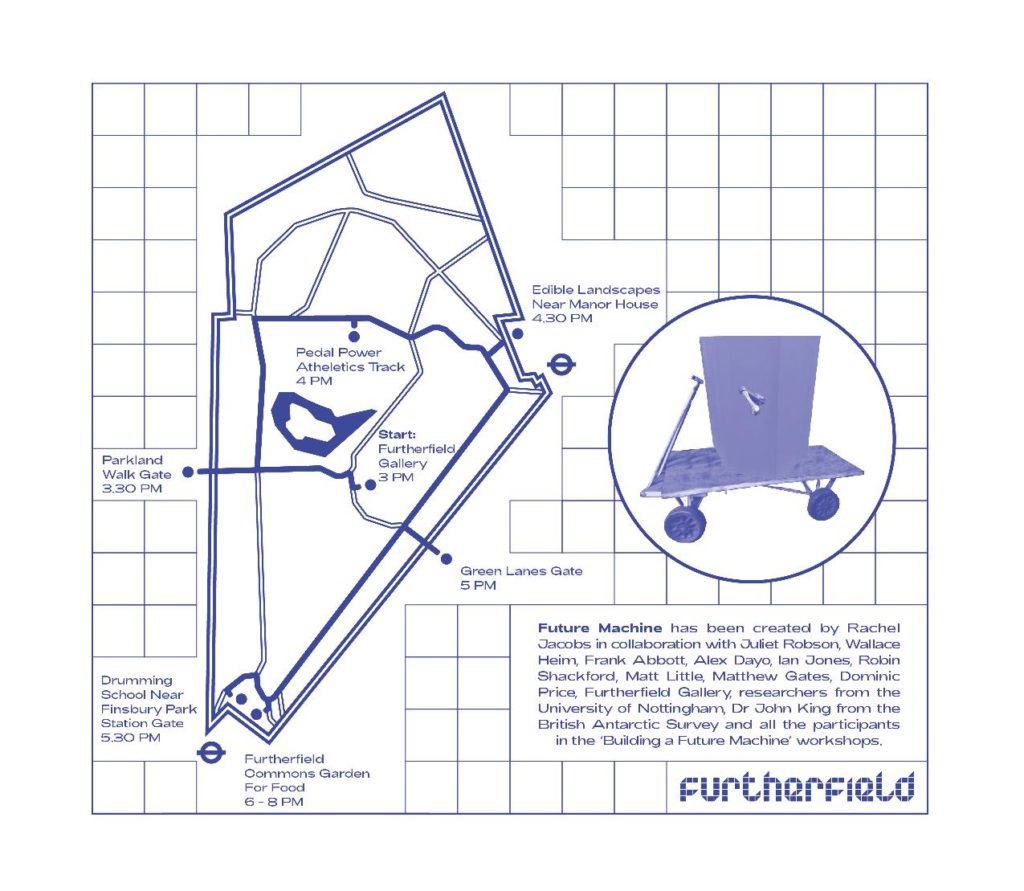
Future Machine Procession Stops:
Future Machine has been created by Rachel Jacobs in collaboration with Juliet Robson, Wallace Heim, Frank Abbott, Alex Dayo, Ian Jones, Robin Shackford, Matt Little, Matthew Gates, Dominic Price, Furtherfield Gallery, researchers from the University of Nottingham, Dr John King from the British Antarctic Survey and all the participants in the ‘Building a Future Machine’ workshops.
After touring to other places across England, the Future Machine will return to Finsbury Park in October in 2020 and 2021, as the future comes.
Featured image: credit to Rachel Jacobs
Introduction
Jan Robert Leegte’s ‘Clear Obscure’ exhibition fills the Genieloods with drawings and performances. The drawings refer to the practice of chiaroscuro from the Renaissance period. The computer performances range from document performances and synthetic wildernesses to recitations from behind the wall of the black box. As architecture the installation mirrors the environment of Fort bij Vijfhuizen, creating an immersive landscape of multiple perspectives, fragments and times – http://tiny.cc/4ojibz
Review: Synthetic wilderness and performative machines
Often when media art is exhibited, all the cables, media players, screws and other wires are carefully hidden, taped away or painted over, concealing the items that are necessary to exhibit the artwork. Not with Jan Robert Leegte, in his solo exhibition ‘Clear Obscure’ at Kunstfort bij Vijfhuizen, all the structures of the projection panels are visible on the back, the climate system is obviously present in the space and his pastel drawings are ‘naked’ within the frame without any glass to protect them. This choice is representative for Leegte’s interest in transparency in relation to technology, which was introduced as a term in computer programming in in 1969 that “would form the foundation of computer interaction that everyone could intuitively understand – at the cost of hiding all inner workings of the machine.” [1] In 2019 almost all complexities, such as code, are carefully hidden behind intuitive user-friendly interfaces. But if we can’t really see it, can we still fully understand what is going on behind our LCD screens?
Within the exhibition, that took place in the industrial Genieloods of the Kunstfort, several pastel drawings are hanging from the metal walls. These drawings are simple in design but extremely powerful in form; in thin white and black lines Leegte translates digital forms like clickable tabs or bars to the physical world, moving closer to the bodily act of actually pressing buttons.
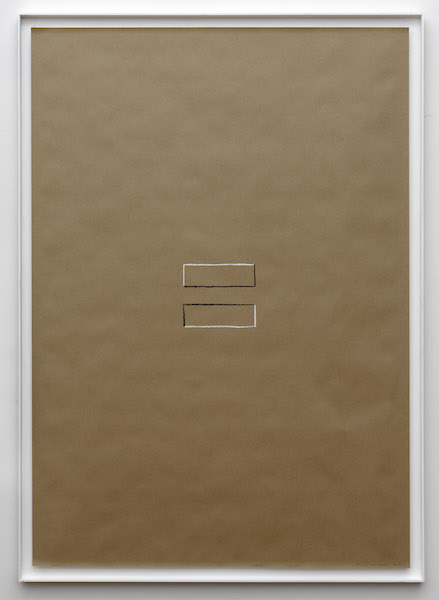
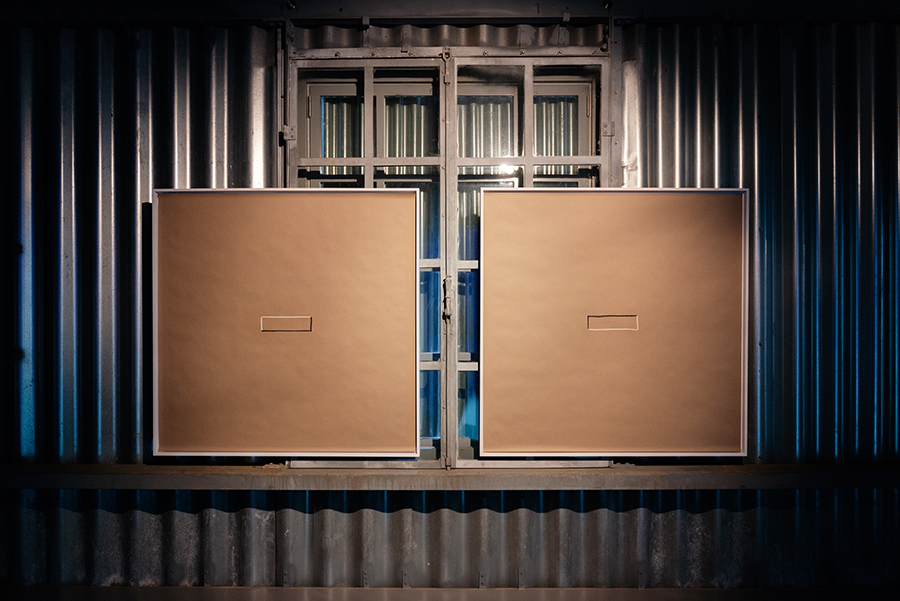
With these works (and maybe also with the brilliant title of the exhibition), he directly refers to the art historical tradition of chiaroscuro, the strong contrast between light and dark, essential to his 2D sculptures on brown paper. Next to 2D works, the space is also filled with the sound of a voice, monotonously reciting names and email addresses. No Consent (A recitation of everybody I ever emailed with) (2018), is a single channel audio work exploring the boundaries of exposing digital private information. Like a dadaist poem, the software uses existing data – Leegte’s mailbox – to compile a exhibitionistic ballad, exposing everyone Leegte has ever emailed with.
Another theme, often occurring in Leegte’s works is the relation with nature and tradition of land art, perfectly fitting with the green surroundings of Kunstfort bij Vijfhuizen situated in the middle of the polder of the Haarlemmermeer. Leegte is no stranger when it comes to connecting land art with the digital; in 2013 he recreated the Robert Smithson’s iconic landmark ‘Spiral Jetty’ (1970) in Minecraft. At the Kunstfort, the relation with nature and how nature is read through technology becomes clear in his work Repositions (2018-2019), consisting of three larger than life projections. The three projected landscapes, all different in color and feel, hypnotically shift into new positions before the viewers eyes. Most striking must be the Yves Klein blue monochrome landscape, which is as a matter of fact, a Google Maps screenshot of one of the deepest parts of the ocean in the middle of the pacific. On the other side one of the highest point of the world in Tibet deviates within the frame of the projection in pink/orange tones interspersed with white snow and emerald green spots – representing man-made lithium mines. While the landscapes continuously move and tilt within the frame, every composition seems to be different.
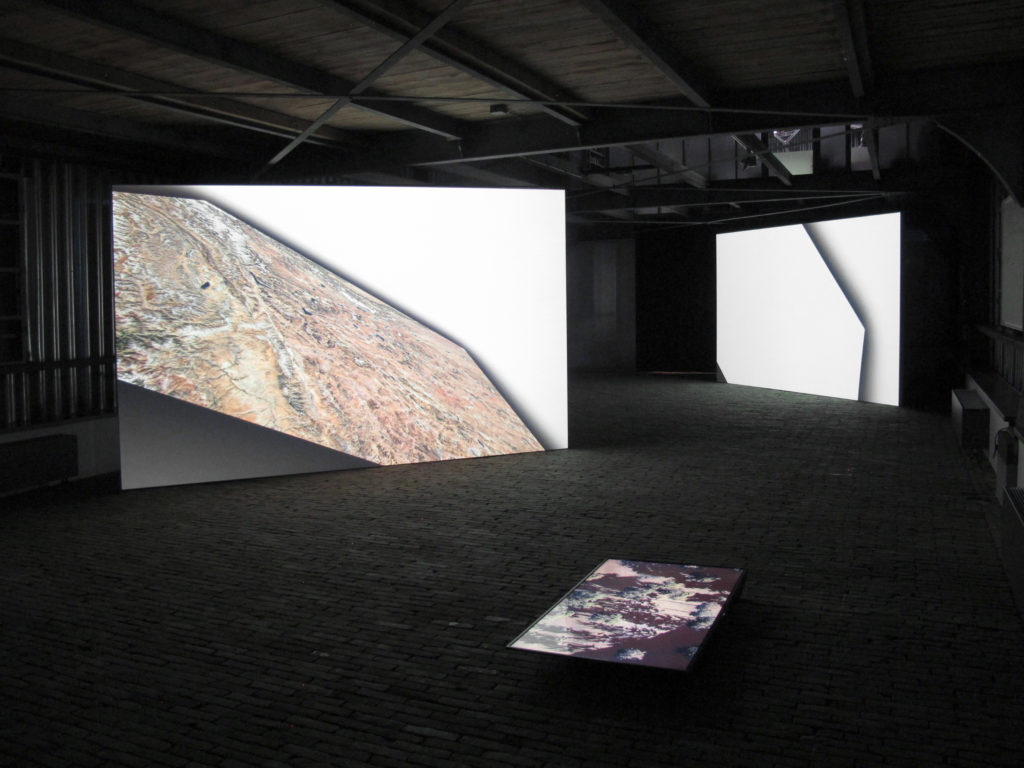
By using live algorithms, Leegte makes the landscapes dance, while performing a sequence of poses like two vogue dancers battling against each other at a ball. This dance, set in motion by a human through code but performed by a machine reminds of Bruce Nauman’s Wall/Floor Positions (1968) where the artist moves through numerous poses in relation to the wall and floor, using his body to analyze the space. At the Kunstfort the computer is the performer that explores the space of its own frame. Performativity has not always been linked to technology because it has traditionally has been associated with “intentionality, reflexivity, sense-making, embodiment, repetition and transgression”, while the technological “refers to deterministic operations without semiotic or affective qualities.” [2] But in current times and within processes that require human input in the form of data or code the separation between human agency and nonhuman procedurality has blurred and have entered a steady relation of performativity.
Just like the landscapes of Repositions, the nature within the single channel video Synthetic Wilderness is not inhabited by humans. The new wilderness seen from above is completely computer simulated and looks like a perfect green environment at first sight with leafs crackling soothing in the wind while casting light shadows in the lush grass. At the same time this picture of paradise is quite alarming; we struggle to preserve nature on our planet and battle climate change but we keep improving in creating digital nature in video game engines. What if that is all we have left in the end?
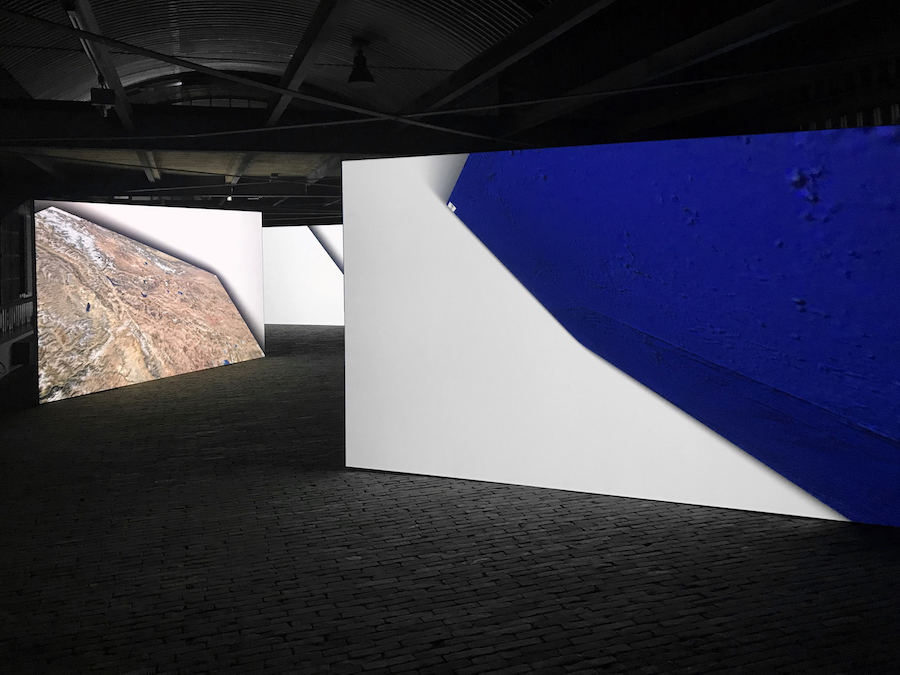
Leegte’s oeuvre is filled with art historical references, explorations between the digital and nature, between human presence and absence, transparency and opaqueness. The world that Leegte presents to spectators is one that is often abstracted but still recognizable, visually attractive and beautiful. At the same time his interpretations of notions of privacy online and the way we see nature through technology are a warning; we should have a closer look at the non-transparent omnipresent technologies that shape our daily lives and the way we look at the world.
—
Jan Robert Leegte (1973, the Netherlands) lives and works in Amsterdam. He recently participated in seminal exhibitions such as Electronic Superhighway at Whitechapel Gallery in London, and Open Codes at ZKM Karlsruhe. His work has been exhibited in venues such as MAAT Lisbon, MOTI Breda, iMal Brussels, and Nomade Art Space in Hangzhou. Leegte’s first solo show was Sculpting the Internet (2017) at Upstream Gallery.
Interview by Ruth Catlow
Transcribed by Anna Monkman
Ingrid LaFleur is on a mission to ensure “equal distribution of the future”. The curator of Manifest Destiny in Detroit, she also recently stood for mayor with an Afrofuturist manifesto.
Detroit has long played a critical role in the history of ‘domestic and global labor struggles.’
And now its quest for social justice has an avant-entrepreneurial dynamic, working across art, politics and technology. Activists respond to the city’s (often highly racialised) political failures to provide basic utilities with impressive social innovation. The recent boot-strapping community mesh networks for instance, was a response to the fact that 40 percent of Detroit residents have no access to the Internet at all. The alliances and networks formed in this project are now providing the social grounding for peer-to-peer technical education and experimentation with emerging decentralisation technologies. DACTROIT (an EOS project) is now exploring how payment for this infrastructure might be made through a community token.
I first interviewed LaFleur in July shortly before Detroit Art Week and the opening of Manifest Destiny at Library Street Collective Gallery.
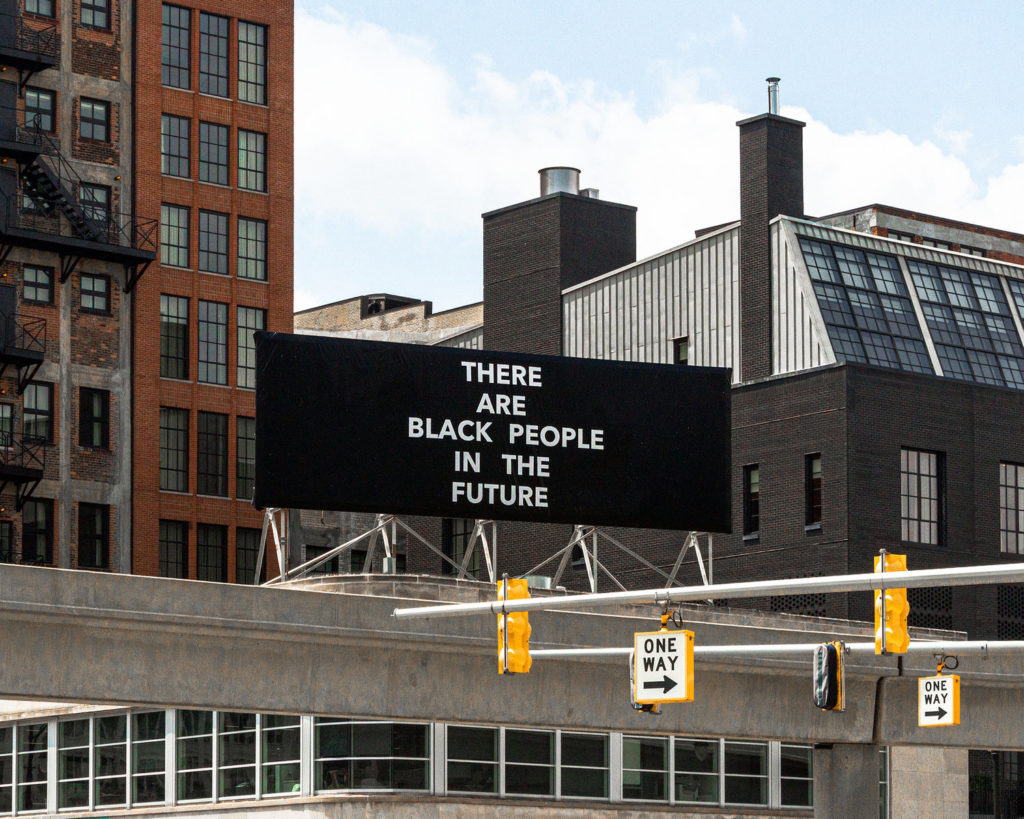
Ruth Catlow: I have wanted to talk with you for a while about your current curatorial work. But first I think it’s worth noting that we share a number of unusual preoccupations. We are both inspired by the social justice sci-fi of Octavia E Butler; we root our work in locality; and have experimented with blockchain technologies as a site for artistic experimentation and social change. I have not however, stood for mayor. You have, and we will come to that later.
Please can you start by telling us about your exhibition Manifest Destiny.
Ingrid LaFleur: I only curate once every two or three years, almost like a museum curator. Manifest Destiny is a culmination of things that I have been thinking about for a while. Working across art and blockchain technology I’ve been very action-oriented thinking about what we need to be implementing, learning, adapting, innovating, in order to basically get free – that’s the whole point of my work.
I’m constantly trying to figure out how Black bodies can be free, which means I really need everyone to be free. And so I’m constantly unpacking, dissecting Afrofuturism as a framework or launchpad. I’m working to see what I’m missing, where are the gaps and how can I fill them in so that we can then make pathways forward and develop the futures that we really want to see. The exhibition title comes from this work.
I wanted to look at this in an abstract way. For instance, the painting series by Satch Hoyt, The Course of Stars of the Sirius System, are illustrating the star Sirius constellation, ground us in an ancient history which I think is very important as we plan and create these processes for manifestation. Satch Hoyt’s painting, Afro-Sonic Map (Black Mapping), is looking at how sound has been cultivated and informed by the different places through which it has travelled. And I’m pulling this interpretation out, because I believe that as we are imagining our destinies we have to be grounded in ancestral wisdom and Afro-Sonic Map (Black Mapping) reminds us of that ancestor from which the sounds are coming… But how they’ve also been wonderfully altered and transformed as a result of coming in contact with different realities – meaning that different times and history have informed the music, have informed how we are communicating sonically.
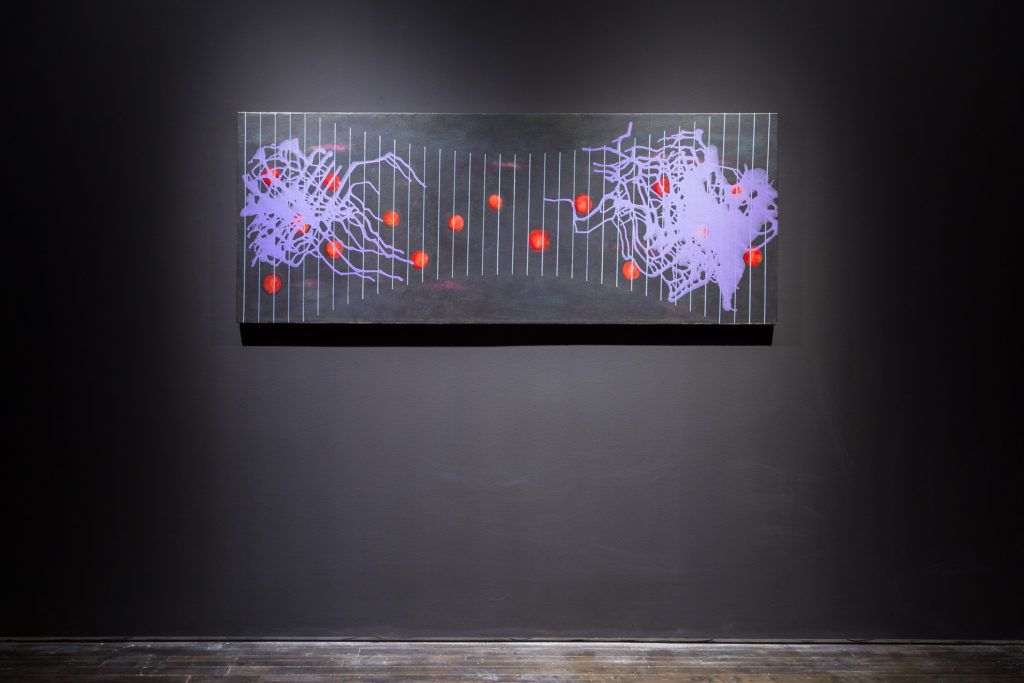
So this is a type of time travel, but it is not just time, it is realities, places and environments and all of these things that inform the work and how there is still always this thread that can always lead back to the original.
And in speaking of the original, the exhibition begins with an Afrofuturist boutique called DINKINESH. I created it because I really wanted to be able to provide items that were affordable and Afrofuturistic. One of the issues that I am having especially when it comes to Afrofuturist imagery is that it is very digital. I am here to bring it out into a physical space and make it both portable and affordable so then people can have it in their homes, place of work, wherever in the physical realm. The whole purpose of Afrofuturism is to shift consciousness and so I want it to be as available as possible. DINKINESH means “you are marvelous” and it is the name that was given to the oldest human remains found thus far, and they were found in Ethiopia. So this store is greeting you, it’s welcoming you into this space, but it’s also a gentle reminder that we all come from this one woman who is in, what we call now, Africa. And we are united by her. So DINKINESH initially will have this Afrofuturistic focus but over time it will grow to include Chicanofuturism and Indofuturism and all the futurisms of Black bodied and Brown bodied people. I am working on the boutique with Utē Petit who is based in New Orleans but from Detroit. He is designing the space and he is using imagery of flora from the Ethiopian region where Dinkinesh was found. The flora has been woven into the wallpaper for the space, so that is really exciting. I am very excited about DINKINESH.
RC: So people will be able to buy Afrofuturist art in the boutique.
ILF: Yes, like digital prints
RC: And will they be buying work that relates to work across the whole show?
ILF: Not really. Some of the artists will have products in the store like zines, hand-printed bags, but they were curated separately from the exhibition.
RC: This is work produced by just one artist or a group of people?
ILF: It’s literally like a retail store so it is work by a lot of different people. It’s like a museum store so it’s a lot of different people from all over. I am basically trying to gather it all together into one space. We don’t currently have one physical store to go and buy Afrofuturist anything.
RC: Wow! How have you sourced all of this? Is it all Afrofuturist art?
IF: Yeah, it’s a combination of people that I have been following online, or different groups that I have heard about, some of my friends might have items that I like, I know some of the artists personally, so it’s a variety of things. It is great, it is exciting, and slightly overwhelming- because it will keep going. To live on, beyond this exhibition.
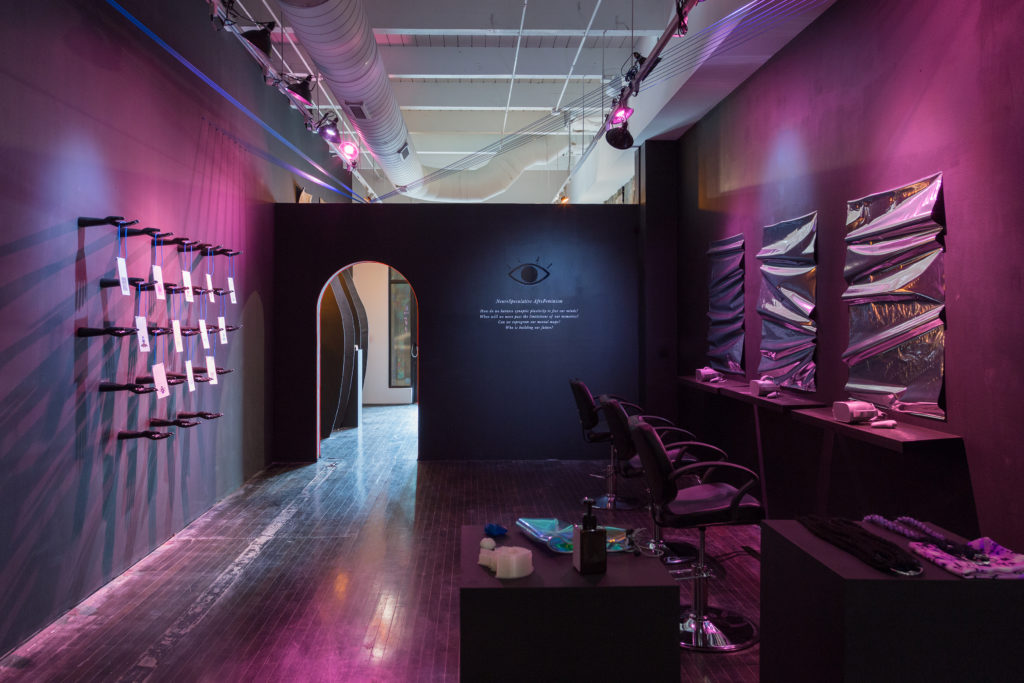
RC: How will it live on afterwards?
ILF: We’re going to be popping up in different places, I can’t announce it yet. I imagine that each place will offer different kinds of experiences. There will be some augmented reality involved in this iteration. I want to grow that, and expand into virtual reality experiences.
RC: I can see why that would be a bit daunting, because if it’s a boutique and people will be buying things it means you will need to keep it stocked.
ILF: It’s a real store!
RC: And are you selling things on the blockchain?
ILF: That might become complicated. But eventually I do want to accept crypto once I find a point of sale system I feel comfortable with. But first, right now, I just need to understand what it means to have a retail space.
RC: To come back to Manifest Destiny, Can you tell us a little bit about the title of the exhibition? What’s the context and significance of Manifest Destiny as a phrase or as a name?
ILF: I am looking at what does it take to manifest one’s destiny. So as I mentioned before, the guidance of ancestral wisdom is really important, otherwise the possibilities of the past become inaccessible in the present. I’ve also learned, as we move into working with new technologies like blockchain, and the philosophies that are behind it, and becoming more familiar with the tech industry in general, how important it is that the planning phase should be a heart-led process. We can see how a person’s perspective is really going to affect the tech and how it interacts with the world and so I’ve become very sensitive to how we’re planning and approaching a thing in order to manifest it.
And then finally there are the tools to make the physical thing and that’s when I get really excited. Implementation.
RC: OK So can you talk me through the exhibition?
ILF: Yes, so it starts off with DINKINESH. Then it goes into Hyphen Labs’s NeuroSpeculative AfroFeminism project which recreates a Black hair salon where you are getting your brain optimised. This is like that beginning process. And I think of the optimisation process as a way of decolonising because you don’t want to plan something that is a result of a colonised, limiting, narrow kind of perspective that is really based on someone else’s agenda. So you want to clear that and clean that up. Then Satch Hoyt’s beautiful paintings, Afro-Sonic Map (Black Mapping) and The Course of the Stars of the Sirius System. These give a reminder of the foundation of histories and ancient ancestral lineage. Then Alisha B. Wormsley created this really wonderful installation that is connecting the two gallery spaces. We also have her billboard that is placed outside of the gallery space above a bar right by public transportation, that says ‘There Are Black People In The Future’. I’m really excited about that because downtown Detroit has become 90% white even though the city is 85% Black so it’s like a little colony. The billboard is disrupting that space.

In the second gallery we have Maikoiyo Alley-Barnes has created a black and white film called Sacred, which is accompanied by a gorgeous sound that creates an ethereal multi-reality. Sacred is hard to talk about without giving away the mystery that’s embedded in it, but the thing that is sacred, you come to understand is sacred to us all. He has also created two sculptures that expresses the continuum that is necessary for the evolution of the future. And then there is Jasmine Murrell who created a collage tapestry, one of them titled Walking Time Travelers: Future will remind you of what is most important, what was lost, what was stolen, and what can never be replaced. Jasmine also created a deconstructed sculptures of hands that are coming through from a different reality.
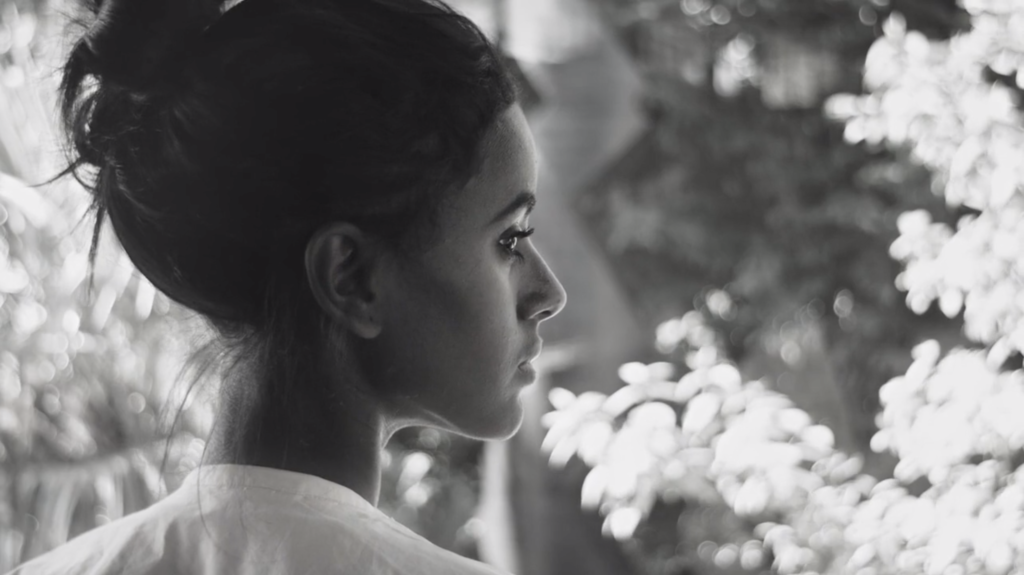
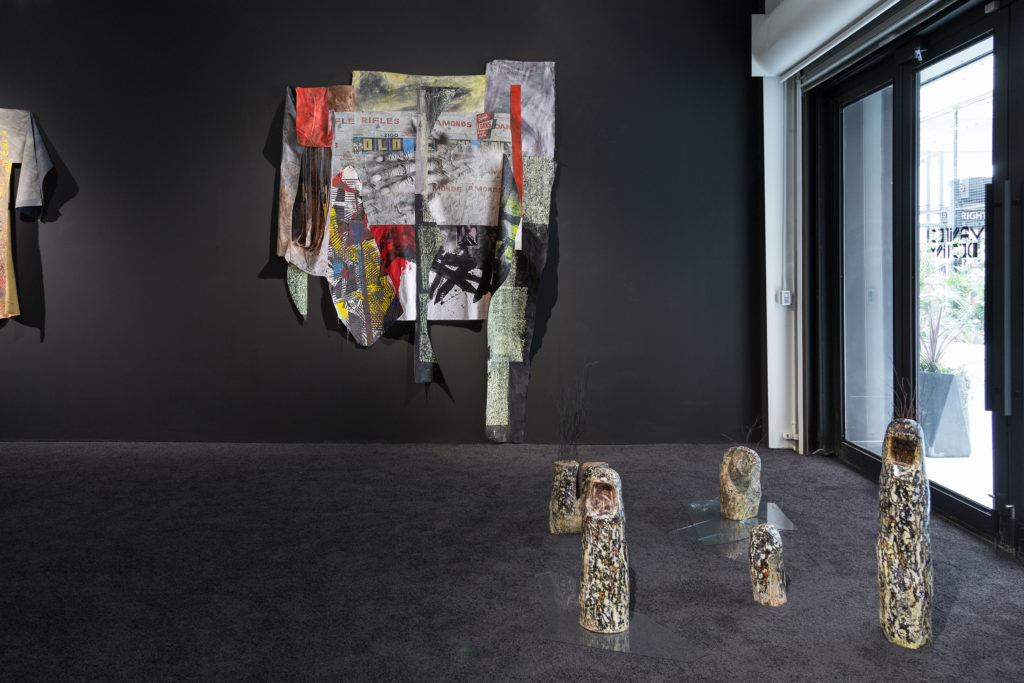
That second gallery space opens up to an alleyway that has been fully renovated where there are clubs and restaurants and bars and all types of artwork, there will be five very large panels that will have augmented reality artwork. This work is coming from the Digitalia exhibition that was shown in San Francisco at the Museum of the African Diaspora, MoAD. I was such a fan of the exhibit that I invited Lady PheOnix who is the curator of Digitalia to travel a portion of the exhibition to Detroit. I was able to choose some images from that exhibition that is on display in the alleyway called The Belt. It will be up for a year. I’m very excited about this because not everybody is going to walk into the gallery space so this is a way of making the afrofuture a little more public, also because augmented reality is participatory it’s a fun activity that everyone can enjoy. For many this will be their first introduction to AR.
The last component of Manifest Destiny is the skills training through a series of workshops. The workshop programme includes a talk by Rasheedah Phillips who is known for her theoretical work on quantum futurism. The Black School reimagines the art school into a Black art school taught participants about ancient architectural techniques and fractals and then as a group built a pyramid. Creative technologist Onyx Ashanti held a 3-D printing workshop. And I gave a workshop on decentralizing power and new economies. The programme ends with DC comics writer Tony Patrick who led us into a worldbuild session over three days. We developed a vision for Detroit in 2040 that will become a comic and eventually a virtual reality experience.
RC: It sounds just amazing! Like there are a lot of different ways in for different kinds of people. How much do you think or care about who this is for and how they find out about it, and also what their experience of it is.
ILF: This show is literally for Detroiters. I am constantly thinking about the exhibitions, the materials, the exposure, making sure that Detroiters have exposure to what is happening in the entire world and I really don’t care if you have never been to a museum or if you go all the time. Most of my work has been directed towards people who might be in-between. They like art and are curious but maybe they are not going to gallery exhibitions all the time or following museum shows. I am very much aware that the gallery space is on the alleyway, The Belt, which is party central for downtown, day and night in the summer. What I love is part of the exhibition in the gallery is visible in The Belt because one of the walls is all window. Downtown attracts all kinds of people, definitely people who have probably not experienced as much artwork by Black artists in their life and who might be a little afraid of Black bodies and hopefully they can develop a new relationship based on this show.
I’m very clear with artists about where they are showing, the politics of what’s going on and who’s going to come through those doors, because some artists might be sensitive to this. Some artists might want to engage in a very particular way as a result. One artist wanted to do something a little more artistic that would work in MOMA, and I was there with him, I got it, but I was like, I just want you to understand that the people who are going to come through these doors have been day drinking. They are going to be in shorts and flip flops, like ‘oh this looks cool’ and ‘oh this is great’ and within minutes they are gone. To help ease people into the space I asked for black carpeting on the floor because I want people to pause when they enter, I want the hushness when you come in so you are a little more reflective. This did happen but also what I did not expect is how people then felt comfortable to sit and chat on the carpeted floor. That warmed my heart. I love when a traditionally austre space becomes an inviting one.
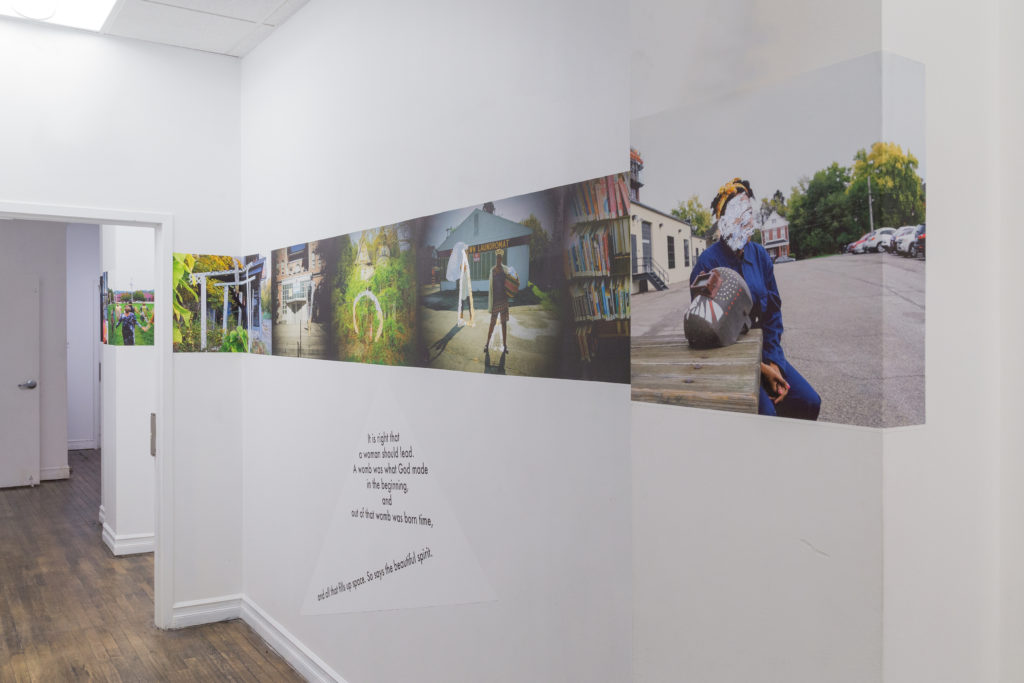
RC: So we run a gallery in the heart of a public park in North London, so we also get the day drinkers, and we also welcome the day drinkers! So it’s interesting to hear you talk about this.
RC: Given that Furtherfield has a readership from all over the world, I imagine that many people will not really have a sense of Detroit. So it would be great to hear you talk about why it’s important to you that this is happening in Detroit. And why Detroit?
ILF: Detroit is going through a major transformation, and some of us are in the midst of it, some of us are making it happen, and then some of us are running behind watching it happen and trying to figure out where we fit in. There is really no reason to leave anyone behind. It’s a critical moment because we are getting an influx of white people moving into a majority Black city. White people in the United States of America are not used to being minorities. Being a minority in their minds mean they have less power. It seems like they are saying to themselves, ‘I’m not used to being the only white person in a room so I’m going to stick with all the gentrified places where I remain majority in the room and I feel safer, more comfortable’. But what that means is that they are still not confronting their fear of Black people so it’s like they’ve decided to live in a tiny hut in a big forest and won’t explore the forest even though it offers new insights and experiences. And it’s ok if that’s what they really want, but then don’t stare or become hostile because Black people have entered a space.
My presence as a Black person can be very disruptive in these spaces, it’s like people forget that they are in a majority Black city. Nobody really cares when there are white people walking into a majority Black bar. The reason we don’t care is because we are in our safe space so a white person coming in is like [shrugs]. But when a Black person enters a majority white space a mixed bag perspectives awaits–a sprinkling of Trump supporters or a sprinkling of racists. A Black person has to figure it out in real-time constantly, whereas a white person coming into a Black space we are just like, ‘do you want a drink?’ It’s not like ‘Where are you from?’, ‘Why are you here?’. We don’t have it in us to do all the microaggressions that white people do and I really think it’s the lack of understanding Black people and culture that has caused a lot of harm. Also, the constant reinforcing of whites to separate themselves from people just because of the color of their skin, it’s dehumanising, causing a level of fear and depression that then becomes violent.
This exhibition is my way of confronting the anti-Blackness and making people face their fears, see it and think about it. What does it mean? Why is there a sign that says ‘There Are Black People In The Future’? Why is it even necessary to say that? What does that make me feel? What does that make me see in the future? And then it makes you question, how was I imagining the future? Did I imagine Black people there? Was I just imagining me and my people? It’s very much confrontational but in a very loving way and that’s why I put DINKINESH, our mother at the beginning.
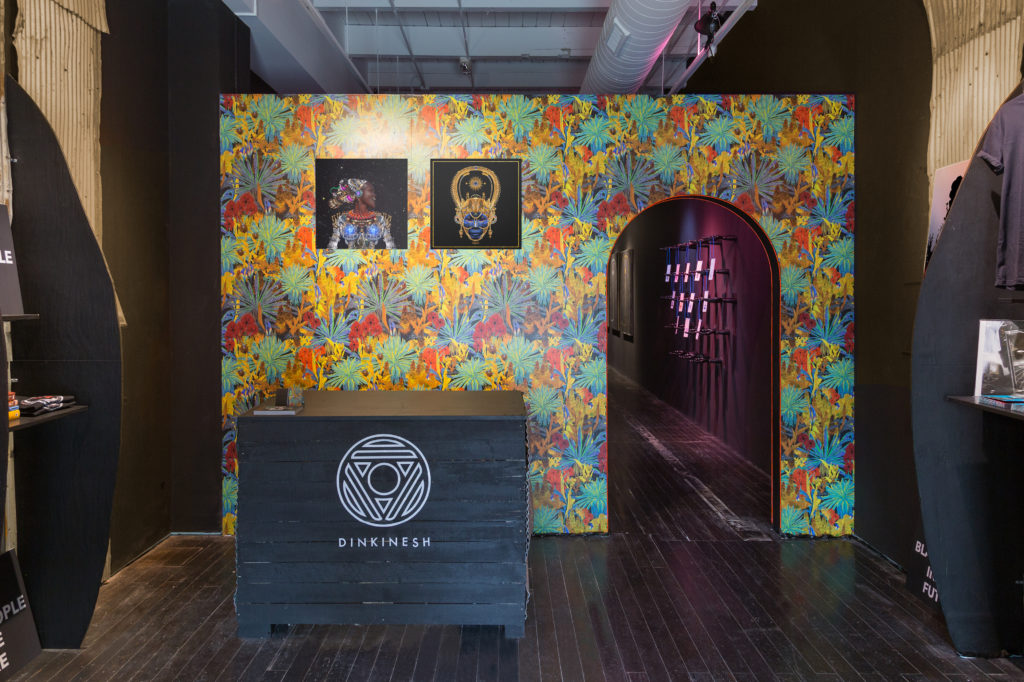
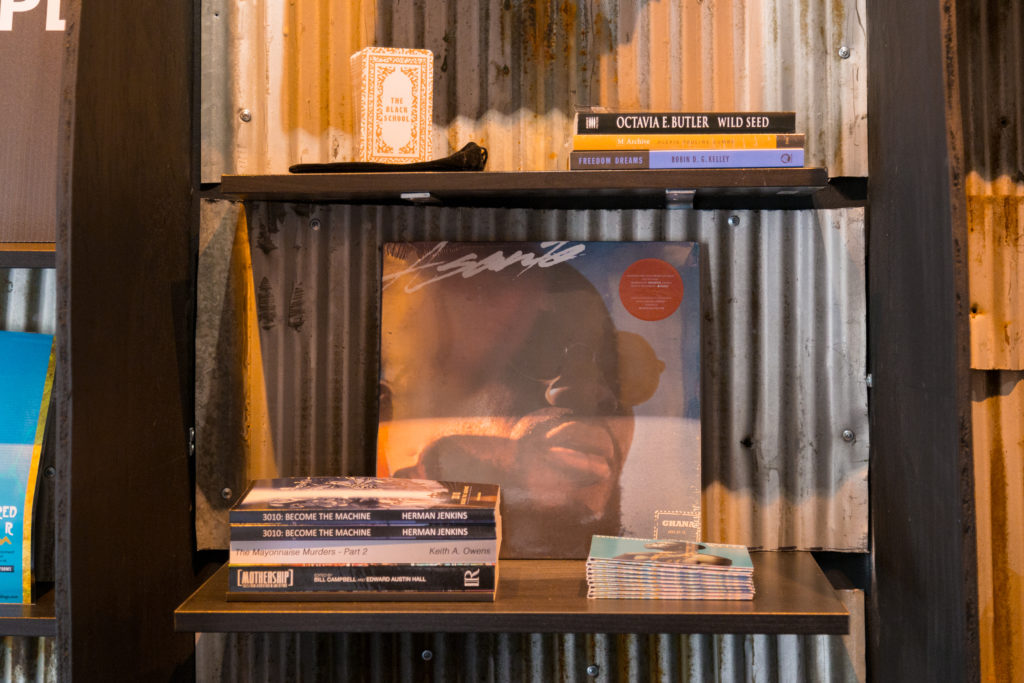
RC: You talk about confrontation but you are also confronting the fear. So you are recognising what’s at play not just at the surface, but on many levels here.
ILF: Exactly. You cannot heal that which you do not acknowledge exists, so I need people to confront the fact that the fear exists somewhere, subconsciously, in your DNA, your heart. Once the fear is acknowledged, the healing begins and then liberation is close. But the problem in the United States is that whites don’t have to confront their fears. But what is misunderstood is how by not confronting fear they are limiting their own life, and they are denying themselves access to humanity.
RC: The first time I met you was at The Gray Area festival when you were talking about running as mayor with an Afrofuturist manifesto. I love that I can now wrap up this interview with a question about your political career!
ILF: Yes! I was the first political candidate to use Afrofuturism as a framework in a mayoral campaign. It was very much of a process to understand what it means to be an Afrofuturist within a political sphere because it had never happened before.
RC: And we should also look for the connection between your work with Decentralised Detroit and your curation of Manifest Destiny?
ILF: As I stated before, I have been in a space of action and because I am an impatient person and I would love to see everyone liberated and happy in my utopia while I am alive, I began investigating ways to tackle the poverty issue in Detroit. It was after I proposed a universal basic income using a cryptocurrency Detroit would create that I began exploring how cryptocurrency and blockchain technology allows for the development of new economies and ways to make money but how it is a tool allowing for efficiency when creating and building with people. Anybody who has worked in groups understands we need as much organization as possible so as a result of working with blockchain technology I’ve come to learn about decentralised autonomous communities and that’s when I become really excited. This is my Afrofuturist self trying to figure out what are the obstacles that Black bodies face in imagining futures, new futures, decolonised futures, futures of their own making from the desire of their own heart, not because of someone else’s agenda or brainwashing.
There are a lot of obstacles but I’ve come naturally and organically to a point where I decided to focus on economics. And so economic justice has been my centre point for a couple of years now. By really attending to the racial wealth gap (it would take the average Black American family approximately 228 years to accrue the wealth of the average white American family), we will then be able to see people have more control over their lives and the neighborhoods they live in. Now we have a pathway for growing wealth, which was something that was denied to Black Americans for over 400 years and continues today.
For me everything is always related, all of it, the art, the blockchain, everything. I am trying to attend to the mind, body, and soul, all at the same time. It is hard for me to focus on just one pathway towards liberation. I like to understand and be involved in multiple pathways to freedom. That’s what keeps me exploring, curating, teaching, lecturing and creating workshops.
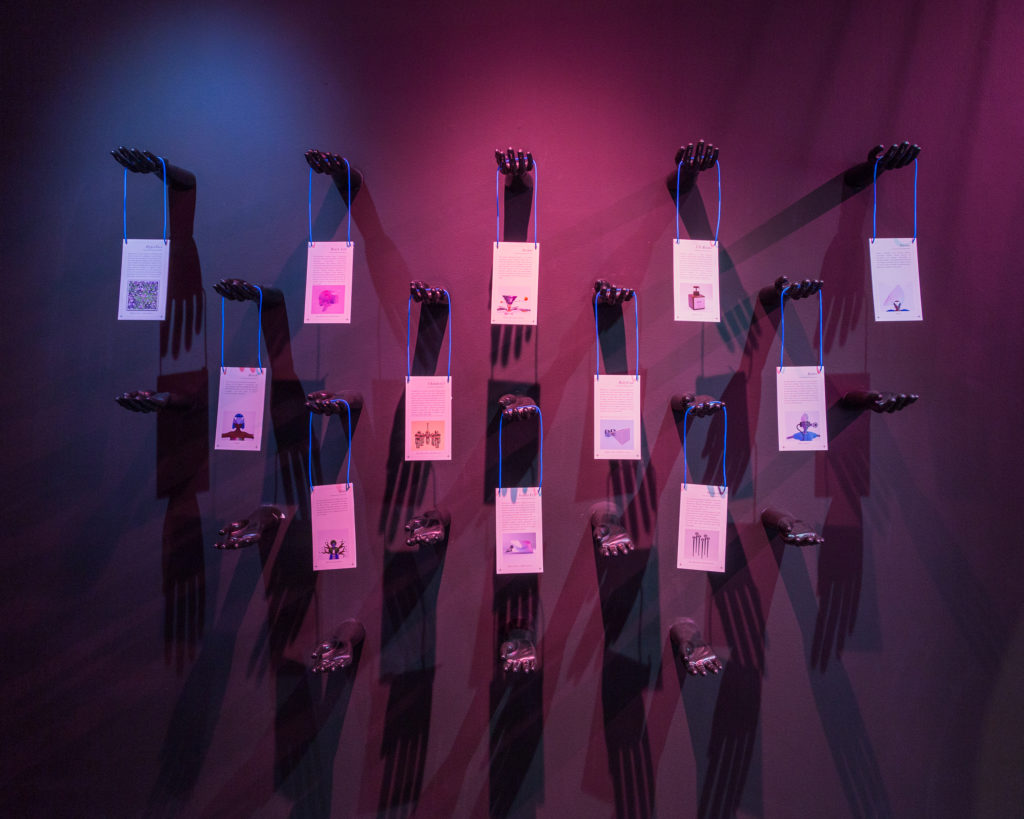
Manifest Destiny, is curated by Ingrid LaFleur. It is now on view at the Library Street Collective Gallery until 5 October 2019
Curator, pleasure activist and Afrofuturist. Her mission is to ensure equal distribution of the future, exploring the frontiers of social justice through new technologies, economies and modes of government. As a recent Detroit Mayoral candidate and founder and director of AFROTOPIA, LaFleur implements Afrofuturist strategies to empower Black bodies and oppressed communities through frameworks such as blockchain and universal basic income. Ingrid LaFleur is currently the Director of Social Impact for Detroit Blockchain Center and curator of Manifest Destiny currently taking place at Library Street Collective in Detroit.
In June 2019 Martin Zeilinger and Furtherfield held a Future of Money workshop, inviting people with expertise in alternative currencies, crypto tech and to meet with sci-fi writers and enthusiasts. They presented their work and to stimulate a discussion on how the politics and practicalities of cashlessness could be explored with younger generations.
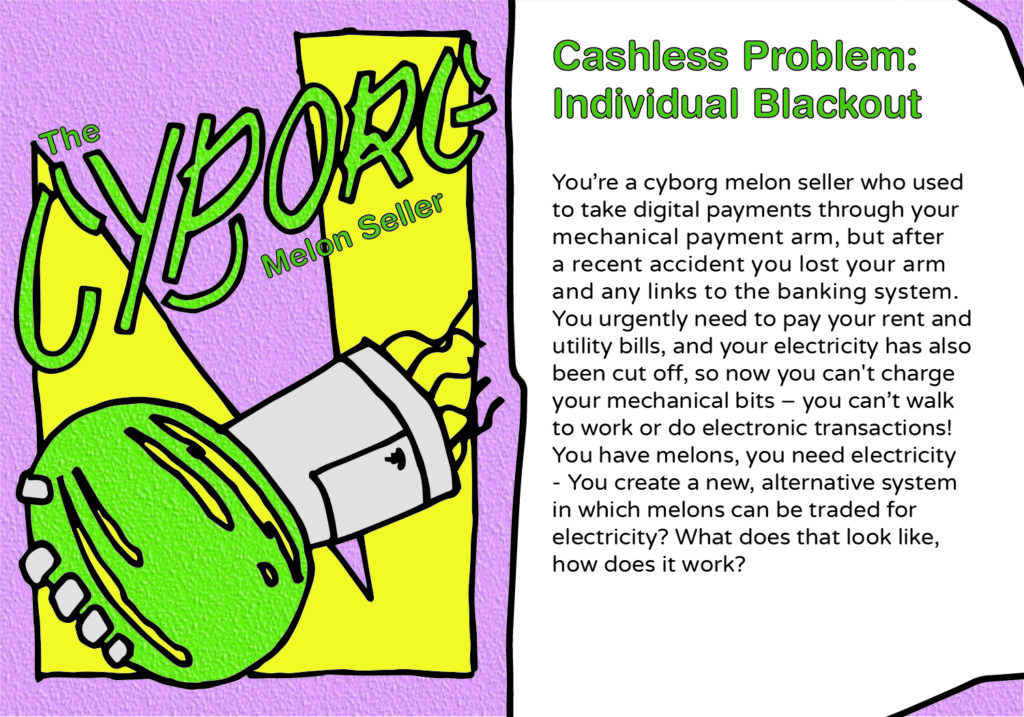
Contributors included:
Mud Howard – gender non-comforming sci-fi writer; Arjun Harrison-Mann – graphic designer; Ben Cain – graphic designer; Brett Scott – on the future of money; Jaya Klara Brekke – on the politics of crypto finance; Ailie Rutherford – feminist economics artist; Peter Holsgrove – art and blockchain developer; Cecila Wee – writer and curator with finance and money specialism. The aim of this event was to develop a framework for running workshops exploring the issues of a cashless society.

The framework, devised by Zeilinger, Furtherfield and Studio Hyte, is a playful workbook (and set of stickers and badges). Users select a scenario from Planet Cashless 2029 and are invited through a set of steps designed to tease out solutions to the scenario. For example in one scenario a cyborg melon seller loses power in their digital payment arm and they need to find an alternative way to sell their melons!
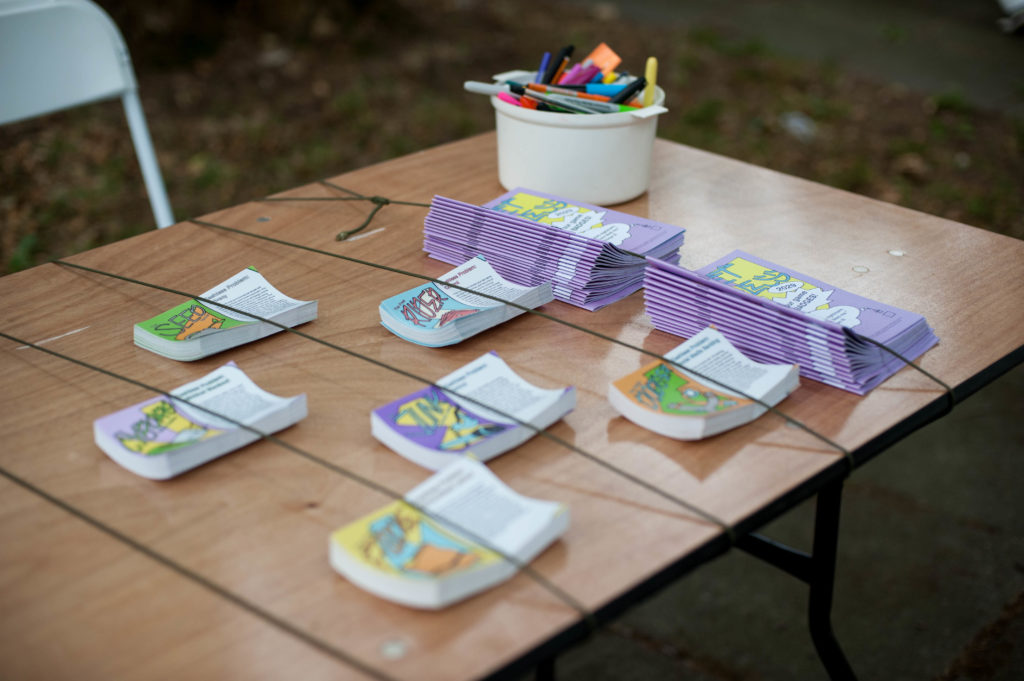
We now plan to further bring the workbook alive with AR. In particular, we aim to create futuristic scavenger hunts where young people can explore locally, investigate financial forms for themselves, and come up with their own solutions to arising issues of the disappearance of cash.
The first Future of Money Lab was run by Zeilinger and Catlow at Furtherfield Commons, London, on 6th June 2019
Martin Zeilinger is a new media researcher, curator, and practitioner whose work focuses on the intersections between new media art, emerging technologies, critical theory, and activism in the financial, political, and environmental realms. Martin is Senior Lecturer in Computational Arts & Technology at Abertay University in Dundee. He has curated the Toronto-based Vector New Media Arts Festival since 2013, and is a member of the curatorial collective for the Dundee-based NEoN Festival.
Featured image: Image from Planet Cashless 2029 booklet designed by Studio Hyte
Join us in using play to design a utopian economy by coming to play Utopoly at Furtherfield Commons.
Utopoly is a tool for inquiry, reflection and idea generation. Its purpose is to generate alternatives to the neoliberal orthodoxy and address the social and ecological crises it creates. It uses a game as utopian practice to critique the state of society and engage in speculation about how to shape the future. Through improvisational play Utopoly provides that rare space for people to re-imagine society, where values, forms of exchange and social relations can be reconsidered and reconfigured. Players then interact with and evaluate the alternative social and political spaces that emerge.
Utopoly starts with a Future Workshop, a method developed by Robert Jungk in 1962 to re-engage people’s innate creative genius which had been suppressed by school, work and consumerism. This involves separate stages of critique, fantasy and implementation. It starts with a discussion and critical exploration around a selected topic or situation. Players critically engage with the now or what-has-become to then open up space for the future or the what-is-yet-to-become. They create fantasies of a utopian nature unconstrained by whether they can be realized or not. Desires, ideas, alternative values, attributes and features of a utopian future are discussed. Moving from the limits of knowing to the possibilities of the yet-to-be-known. This is the political space where the future is open and crucially not a continuation of the present.
The implementation stage involves a ‘hack’ of Monopoly, a popular game which in its original form in 1904 had a progressive and beneficial informative function, but now celebrates and normalises competitive accumulation and socially useless rentier behaviour.
Players discuss and decide which of the features of a utopian future they want represented in the game Utopoly. They determine how the new economy works and – by introducing alternative values, currencies and transactions – can inspire new ways of considering existing social norms. Players then collaborate in a contest against the prevailing crises bound by the neoliberal agenda.
By playing Utopoly participants have the opportunity to reflect on alternative realities and social relations. They can navigate and negotiate the various game features and experience what it is like to inhabit a world incorporating the new economic and social possibilities they have created. In addition, by providing a platform for beneficial expectations Utopoly cultivates the ‘education of desire’ for a better world.
Further information about Utopoly can be found in the following articles:
New School (New York) Public Seminar, Utopoly – A utopian design game
Furtherfield UTOPOLY – playing as a tool to reimagine our future: an interview with Neil Farnan
I discovered a tiny new slice of London just a short walk away from Furtherfield. It was an unused car park tucked away on the edge of a commercial estate once host to a vibrant textile industry, transformed temporarily into a project space dubbed as Tottenham Pavilion.
For six weekends from August with its pop-up tent and rustic outdoor furniture, it hosted hands-on experiences on art-making which culminated in a public exhibition featuring an eclectic accumulation of pictures, texts, objects, and structures made on site by locals for locals.
A mixed media installation emerged as a focal point, sprawling under the marquee with bamboo sticks planted on blocks of concrete like the skeleton of a building under construction. Works on paper and textile hung like leaves on a tree: from collages of found images mixing religious iconography, mass media, and art history; to hand-stitched and woven fabrics gently combined with colourful beads; and zines with micro-stories in poetry and prose.
Elsewhere, there were sculptures made from styrofoam, wooden sticks, reflective sheets, and plaster that altogether seemed like artefacts from an ancient tribe; a figurative mural depicting a changing urban landscape with different buildings that seem to rise up and fall back unto itself; abstract paintings filled with familiar gestures of freedom laid by several hands; and a map of drawings by visitors attempting to visualise their journey to the site – altogether weaving a sense of place in an otherwise vacuous space.
It can be hard to tell where a body of work begins and ends, which may have been its strength. The works collectively function as a singular site-specific installation of disparate components tethered together by a shared conceptual and spacial approach.
Yet this idea is not a new concept as such. The Serpentine Pavilion in Hyde Park exists for roughly the same purposes; Peckham Levels in south London similarly transformed a seven-storey car park into a creative hub; and Furtherfield itself revitalised two spaces in Finsbury Park to decentralise art and technology. Well-known artists like Tania Bruguera and Jeremy Deller have also been known to engage with communities, often to much fanfare. All these projects are admittedly on a bigger scale in comparison, which is precisely what seems remarkable here.
Tottenham Pavilion embraced a hyperlocal focus to engage this community at their doorstep, specifically aiming its free workshops and activities to residents of its immediate vicinity encompassing Woodbury Down, Seven Sisters Road, and the Haringey warehouse of artists who led the project, all within walking distance of each other.
In doing so, it managed to not only provide local artists a platform to develop and showcase their practices conveniently within their own turf, but equally offer opportunities for local residents, their neighbours, access to creative activities that may otherwise be unavailable or even unknown to some. This ethos attracted much-needed funding from City Hall, which currently supports this agenda through a local funding stream, modest but nevertheless positive for an area that may be artistically underserved and missing out from the benefits of art.
There is always something new to explore in this city, and it is more rewarding when it involves maximising the potential of places and spaces as a conduit for accessible arts and culture. What began as an empty gazebo on a soulless patch of land ended up as a vessel for potent marks and traces between adjacent communities that for brief moments came together to make something for themselves, potentially activating new paths for connection and creativity within this locality and even beyond.
Tottenham Pavilion ran between 10 August and 15 September 2019, on Seven Sisters Road corner Eade Road. Organised by Carolina Khouri, with creative workshops led by SWG (creative writing), Surya de Wit (painting and collage), Helen Bur (murals), Nicola Woollon (embroidery), Wojciech Antoni Sobczynski (sculpture and installation), and Jenna Jardine (materials). Funded by Mayor of London’s Culture Seeds, and Spaces for Creatives.
Featured image: Tottenham Pavilion. Image credit West Creative
A list of recommendations, reflecting the dynamic culture we are part of, straddling the fields of art, technology and social change.
Counting Craters on the Moon | Solo exhibition by Kyriaki Goni | Curated by Daphne Dragona | Aksioma | Project Space Komenskega 18, Ljubljana | 2–25 October 2019 | As a result of advances in machine learning, our understanding of today’s world is ever more mediated by machines. What challenges does deep learning bring to human-based knowledge? What do machines see and do differently than humans? How can artificial intelligence enhance new forms of experience and understanding? To address these questions, in Counting Craters on the Moon, Kyriaki Goni purposely turns her gaze to a distant and uncanny territory: the Moon and its surface. The Moon, according to the artist, constitutes a fascinating example and offers an interesting analogy. Lacking an atmosphere, it operates as a data center which stores in its body the memory of our solar system and allows predictions for the future – http://tiny.cc/cgabdz
Acts of Quiet Resistance | 5 October 2019 | Hosted by Foodhall / Sheffield and outsidefilm | Acts Of Quiet Resistance (Ian Nesbitt + Michael Ransley / 2019 / 70 mins) is a documentary steeped in the slow cinema tradition. Five years in the making, it continues a thread in Ian’s work of collaboratively made films, blurring the line between subject and filmmaker. “For fans of Shirley Collins, Richard Linklater, campfires and Robert Bresson, but this film is so beautifully sideways it sweeps away comparisons really.” Chiz Williams, Cube Microplex | FB link – http://tiny.cc/de5adz
Arts Lab Northampton and Liverpool Arts Lab team up to present ‘Howl’ | Northampton’s Alistair Fruish has taken on Allen Ginsberg’s classic poem, once subject to an obscenity trial, to address the major obscenity of our time; the destruction of the ecological systems that sustain our planet. Visceral, confrontational and very timely, ‘Howl’ was brought to life by the design work of Liverpool’s Slim Smith. Printed on A4 280gm textured cream card. http://tiny.cc/3sk9cz All proceeds will go to the Regenerative Agroforestry Impact Network – http://tiny.cc/77abdz
New Suns: A Feminist Literary Festival | 5 Oct 2019 | Barbican, London | A bookfair and day of talks, workshops and screenings, exploring contemporary feminism and technology. ‘For the master’s tools will never dismantle the master’s house’ – Audre Lorde | Inviting audiences to explore new and continuing debates in feminist approaches to technology. This year’s festival takes inspiration from science fiction writer Ursula K. Le Guin’s essay The Carrier Bag Theory of Fiction, which subverts the dominant narrative of technologically driven ‘progress’.
The day will include workshops, talks and screenings exploring technofeminism, storytelling, sonic ritual, gender identity, reproductive justice and indigenous knowledge with writers, artists, mystics, poets and academics. In the spirit of the 1980s international feminist bookfairs, there will also be over thirty stalls to explore across Level G, and selected events for free – http://tiny.cc/d86adz
Genetic Automata, Larry Achiampong and David Blandy | 15th oct 2019 | Hosted by Site Gallery (Sheffield) and Arts Catalyst | Genetic Automata forms the first part of an ambitious new body of film-based works that attempt to address this complex history of classification and segregation. Referencing the history of the theory of evolution, and the relationship between Darwin and his taxidermy teacher John Edmonstone, a freed slave, the work takes the form of a video installation combining animation, spoken word and text interspersed with microscopic topographies of varied shades of skin, digital renditions of skin from video games, and film footage of taxidermied bird life from Darwin’s bird skin collection at the Natural History Museum – http://tiny.cc/m45adz
Open Call: Rot | In the midst of this hubris of humans becoming humus, we might find tools for living in a rotten age. Across the world, artists, activists, and academics are busy learning to give voice to the sympoetic; bat populations translate into flickering shadows, music composed for moth’s ears, an opera of 176 golden snails, a butoh dance about shrimp deranged by antidepressant medication overflowed into oceans. This is a genre of creative work interested in finding new ways to interrogate the underbelly of today’s ‘wicked problems.
Rot invites artists, scientists, activists, and writers with poorly disciplined curiosities to submit work that digs into this compost heap. We are especially interested in supporting dialogue around works in process; field notes, half-completed projects, the tangled, in-between moments where cross-contaminations and co-creations occur. We would especially like to hear from people who are underrepresented in the fields of art and arts publishing – in particular people who identify as BAME, disabled, LGBT, or low income – http://tiny.cc/5p3cdz
New Myths: Recordings from the Missing Channel, curated by Canan Batur | Conceived as a series of soundscapes/sonic think tanks to assess, develop and propose new social languages and methods to understand, and create unlikely relationships between; the systems of representation, the emancipatory aspect of sound and the social constructs of identity. It takes its foundation from the idea that music is a myth, and myths’ ability to suggest – with primal narrative power- the conflicting forces and ideas that lie at the foundation of society.
Over the course of five months, New Myths will upload contributions by Tarek Lakhrissi, markiscrycrycry, James Massiah, Momtaza Mehri, Harun Morrison, Precious Okoyomon, Claudia Pages, Hannah Perry, Tabita Rezaire and Rowdy SS to 1.1 Basel’s online platform and SoundCloud with the purpose of delving into the multitude of voices, the rhythm of erosion and emergence, and the collusion and contradiction – http://www.1-1.digital/show/new-myths/
Conflictual Aesthetics: Artistic Activism and the Public Sphere | Editor Oliver Marchart | A new wave of artistic activism has emerged in recent years in response to the ever-increasing dominance of authoritarian neoliberalism. Activist practices in the art field, however, have been around much longer. As Oliver Marchart claims, there has always been an activist undercurrent in art. In this book he traces trajectories of artistic activism in theater, dance, performance, and public art, and investigates the political potential of urbanism, curating, and “biennials of resistance.” What emerges is a conflictual aesthetics that does not conform with traditional approaches to the field and that activates the political potential of artistic practice | Sternberg Press 2019 – http://tiny.cc/z5bbdz
Call for Papers: Special Issue on Sound, Image and Interaction | EAI Endorsed Transactions on Creative Technologies | For the last two decades, there has been a growing interest in the study of sound from a Human-Computer Interaction (HCI) perspective. This coincides with the shift to a third wave of HCI towards applications in broader cultural contexts. Researchers have paid special attention to the integration of other sensory modalities with sound. This Special Issue “Sound, Image and Interaction”, aims to address emerging issues in research related to the creation of interactive sonic experiences, particularly focusing on the role that image plays in these scenarios. We are interested in submissions related to connections between sound, image and/or interaction, and the topics of interest listed – https://escripts.eai.eu/publication/257
Climate Machines, Fascist Drives, and Truth | By William E. Connolly | Duke University Press Books (23 Aug. 2019) | In this new installation of his work, William E. Connolly examines entanglements between volatile earth processes and emerging cultural practices, highlighting relays among extractive capitalism, self-amplifying climate processes, migrations, democratic aspirations, and fascist dangers. In three interwoven essays, Connolly takes up thinkers in the “minor tradition” of European thought who, unlike Cartesians and Kantians, cross divisions between nature and culture. He first offers readings of Sophocles and Mary Shelley, asking whether close attention to the Anthropocene could perhaps have arrived earlier had subsequent humanists absorbed their lessons – http://tiny.cc/3t0cdz
Harness the Power of a Fluid Identity with 3 Simple Strategies | By Marloes de Valk September | Institute of Network Cultures | Why aren’t there stronger regulations protecting our privacy, our democracy? Seemingly off topic but very similar: why aren’t there stricter regulations protecting us from anthropogenic climate change? In an attempt to find answers to these questions, I’ve been looking into strategies used by different industries to delay regulation: democratic intervention in the private market in order to protect citizens and the world on which their lives rely – http://tiny.cc/o4rfdz
Feminism and the Social Solidarity Economy: a Short Call to Action | The following text is a translation of Marian Díez‘s impassioned closing speech at the recent convergence meeting of the World Social Forum for Transformative Economies. The closing event was filled with strong presentations, but we chose Marian’s for its overview of the sheer scope and variety of the Social Solidarity Economy in Spain and, secondly, to highlight the need for intersectional complementarity among post-capitalist movements. This article is also closely linked to our translation of A Charter for the Social Solidarity Economy – http://tiny.cc/gm4adz
David Olusoga: Blackness, Britishness + the Windrush Generation | 8 Oct 2019 | Hosted by Firstsite, Colchester, UK | To coincide with the opening of Super Black, an exhibition co-curated with members of Colchester’s Black African and Caribbean communities, David Olusoga OBE, a British-Nigerian historian, broadcaster, film-maker and award-winning author, is coming to Firstsite to give a unique talk about the history of British African-Caribbean people, and what it means to be black in Britain today.
Every ticket sold raises money to show free exhibitions of award winning artists, and helps Firstsite fund local creative community projects – including free lunches and activities for families during the school holidays. https://firstsite.uk/whats-on/david-olusoga-talk/
Video Doc: The Sex Pistols Riotous 1978 Tour Through the U.S. South: Watch/Hear Concerts in Dallas, Memphis, Tulsa & More | Open Culture | The Sex Pistols “started out as an elaborate Situationist-inspired performance art piece dreamed up by megalomaniac manager Malcolm McLaren,” wrote Jonathan Crow in a post here at Open Culture about one of the band’s storied, disastrous final shows in Dallas of 1978. After beginning as the creation of McLaren and partner Vivienne Westwood, however, they “evolved beyond just being a stunt.” The statement is objectively true by music history standards. The band’s earliest gigs were directly responsible for almost every major band that took British punk in subsequent post-punk, goth, new wave, dub, etc. directions, including the Buzzcocks, Siouxsie and the Banshees, The Clash, Joy Division, Wire, and too many others to list – http://tiny.cc/rb8adz
Complexity, uncertainty & scalability: How Assemble’s Granby 4 Streets won 2015 Turner Prize | By Stephen Pritchard (originally written in 2016) | “Did Assemble really play such a big part in Granby 4 Streets? How ‘community-led’ was the project? What was the role of the Community Land Trust? How did Assemble come to win the Turner Prize 2015? Who were the private social investors and what did they do to help make the project happen? The intention here is to blow open the façade behind Granby 4 Streets, Assemble and the Turner Prize 2015 win. Pritchard argues that the media and art world picture of Assemble is overly simplistic and masks a far more complex and uncertain set of events that, ultimately, relied on ‘mystery’ private social investors to force local government to act in support of the project and to lever money from national grant funders.” http://tiny.cc/dqq4cz
Publishing and Administrative Assistant job at Ognota books | We are hiring for a Publishing and Administrative Assistant. Abilities to divine the future, travel in the astral plane and to write funding applications are a major advantage. We particularly welcome applicants with strong earth placements – http://tiny.cc/5potcz
Image credit: Leila Nadir and Cary Adams, from the series Microbial Selfie (2017)
Algorithmic Food Justice is a research project that focuses on two injustices in the global food system and tests how emerging decentralised coordination technologies might support positive transformation.
It is a 6-month project led by researchers at City University, London in partnership with DECAL Decentralised Arts Lab at Furtherfield, Spitalfields City Farm and the Gaia Foundation. The project is funded by the Engineering and Physical Sciences Research Council “Not Equal Network”.
Firstly, unequal access to food. How can we create a sustainable “food commons”, where food production is managed for the benefit of all, including low income and ethnically diverse communities? Our project will explore this issue in partnership with urban agricultural communities, who already experiment with alternative models of labour and distribution within the fabric of our cities.
Secondly, we will address the injustices inflicted on other species by intensive human food production. To grow food successfully, humans require the help of other organisms – for example bees, or soil micro-organisms.
How might we use the features and affordances of blockchain technology to organise differently and to recognise and value the contributions of more-than-human participants, and therefore help avoid problems like soil degradation and bee extinction that threaten life on earth? How might this algorithmic “more-than-human value system” take shape in urban agricultural contexts?
This year, we will hold four workshops to collectively re-imagine a future food commons and operationalise different value systems by working with blockchain technologies. As we look into the future of urban farming, what will urban agricultural communities need in order to flourish, for the benefit of all? How can the interdependencies between humans, creatures and natural resources be better catered for?
Drawing on this collaborative and participatory work, we will develop speculative prototypes that float new arrangements of the food web and stimulate further discussion on how urban food futures might generatively reshape our increasingly algorithmic systems and environments.
http://algorithmicfoodjustice.net/
Featured image: Credit to Sara Heitlinger and Lara Houston
Future Fictions for Finsbury Park is part of our Citizen Sci-Fi initiative. It brings together sci-fi writers in residence with local residents and set of scientific experts to explore written visions of a Finsbury Park of the future.
For our 2019/2020 year of FF4FP we worked with sci-fi writers Mud Howard and Stephen Oram to create two new short stories about the park, based on deep research conducted with community members and experts. Via a set of workshops organised by Producer, Ruth Fenton, participants were invited to explore both near and far future ideas based on the current knowledge we have of climate change and technological developments, to imagine how we might like to see Finsbury Park evolve.
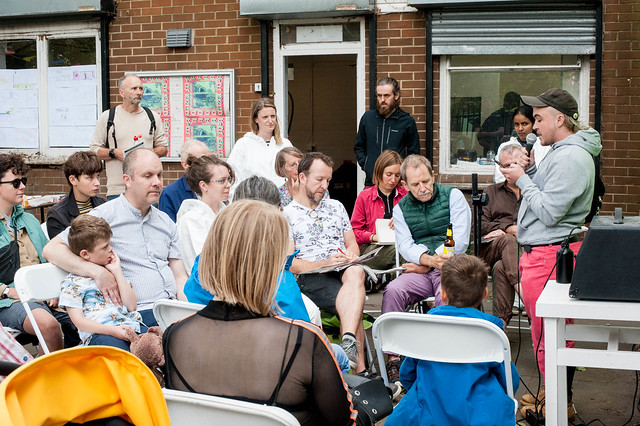
At our Future Fair on 10th August 2019, both Mud and Stephen gave live readings of their stories, which will be published on the Furtherfield website this Autumn.
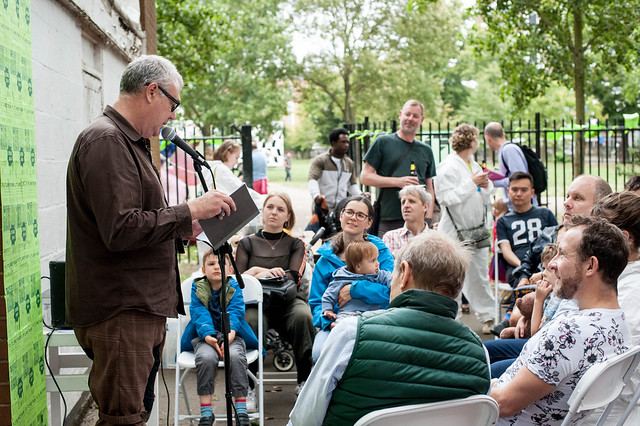
Mud Howard (they/them)
A gender non-conforming poet, performer and activist from the states. mud creates work that explores the intimacy and isolation between queer and trans bodies. mud is a Pushcart Prize nominee. they are currently working on their first full-length novel: a queer and trans memoir full of lies and magic. they were the first annual youth writing fellow for Transfaith in the summer of 2017. their poem “clearing” was selected by Eduardo C. Corral for Sundress Publication’s the Best of the Net 2017. mud is a graduate of the low-res MFA Poetry Program at the IPRC in Portland, OR and holds a Masters in Creative Writing from the University of Westminster. you can find their work in THEM, The Lifted Brow, Foglifter, and Cleaver Magazine. they spend a lot of time scheming both how to survive and not perpetuate toxic masculinity. they love to lip sync, show up to the dance party early and paint their mustache turquoise and gold.
Stephen Oram
Who writes thought provoking stories that mix science fiction with social comment, mainly in a recognisable near-future. He is one of the writers for SciFutures and, as 2016 Author in Residence at Virtual Futures – described by the Guardian as “the Glastonbury of cyberculture” – he was one of the masterminds behind the new Near-Future Fiction series and continues to be a lead curator. Oram is a member of the Clockhouse London Writers and a member of the Alliance of Independent Authors. He has two published novels: Fluence and Quantum Confessions, and a collection of sci-fi shorts, Eating Robots and Other Stories. As the Author in Residence for Virtual Futures Salons he wrote stories on the new and exciting worlds of neurostimulation, bionic prosthetics and bio-art. These Salons bring together artists, philosophers, cultural theorists, technologists and fiction writers to consider the future of humanity and technology. Recently, his focus has been on collaborating with experts to understand the work that’s going on in neuroscience, artificial intelligence and deep machine learning. From this Oram writes short pieces of near-future science fiction as thought experiments and use them as a starting point for discussion between himself, scientists and the public. Oram is always interested in creating and contributing to debate about potential futures.
The Future Experts comprised of local residents of Finsbury Park, who brought invaluable knowledge of the area, and professional experts from a variety of scientific and design based backgrounds, who brought expertise in future thinking in many areas including health, transport, technology and architecture.
Ling Tan
Ling Tan is a designer, maker and coder interested in how people interact with the built environment and wearable technology. Trained as an architect, she enjoys building physical machines and prototypes ranging from urban scale to wearable scale to explore different modes of interaction between people and their surrounding spaces. Her work falls somewhere within the genre of the built environment, wearable technology, Internet of Things(IoT) and citizen participation. It involves working with various communities in different cities and uses wearable technology as tools to express their relationship with the city, touching on demographic, race, gender and the subjective experience of the city through people.
Paul Dobraszczyk
I am a researcher and writer based in Manchester, UK, and a teaching fellow at the Bartlett School of Architecture in London. I’m currently researching anarchism and architecture as well as completing a co-edited book Manchester: Something Rich and Strange (Manchester University Press, forthcoming in 2020). I’m the author of Future Cities: Architecture and the imagination (Reaktion, 2019); The Dead City: Urban Ruins and the Spectacle of Decay (IB Tauris, 2017); London’s Sewers (Shire, 2014); Iron, Ornament and Architecture in Victorian Britain (Ashgate, 2014); and Into the Belly of the Beast: Exploring London’s Victorian Sewers (Spire, 2009). I also co-edited Global Undergrounds: Exploring Cities Within (Reaktion, 2016); and Function & Fantasy: Iron Architecture in Long Nineteenth Century (Routledge, 2016). I am also a visual artist and photographer and built the website http://www.stonesofmanchester.com. I blog at https://ragpickinghistory.co.uk/.
Dr Rasmus Birk
I am a social scientist, currently working as a Visiting Postdoctoral Fellow at the Department of Global Health & Social Medicine, King’s College London. My research here explores the relationship between city life and mental health, specifically how living in the city leads, for some people, to the development of mental health problems. I am currently researching the experiences of young people with common mental health problems (such as depression, anxiety, or stress) in South East London.
Dr Kate Pangbourne
University Academic Fellow at the Institute for Transport Studies (University of Leeds). She has an MA (Hons) in Philosophy with English Literature, an MSc in Sustainable Rural Development and a PhD in Geography – Environmental (Transport Governance). Her research is oriented towards shifting our transport system and individual choices towards greater environmental sustainability, social inclusion and meaningful prosperity. She is particularly interested in the implications of rapid technological change in the transport sector. Current work includes improving the persuasiveness of travel behaviour messages (ADAPT, funded by EPSRC), enhancing the rail passenger experience (SMaRTE, funded by the EU through Shift2Rail) and the societal challenges posed by self-driving vehicles and new concepts such as Mobility as a Service. Proof of humanity: has children, grows vegetables, sews and knits, sings, plays the piano, and used to play jazz sax (badly). Weird info: is a Freeman of the Worshipful Company of Cordwainers and of the City of London (but lives in Scotland).
https://environment.leeds.ac.uk/transport/staff/971/dr-kate-pangbourne
Dr Christine Aicardi
Originally trained in applied mathematics, computer sciences and project management, with a MEng from the Ecole Nationale des Ponts et Chaussées in France. She worked for many years in the Information and Communication Technologies industry, where she held a variety of positions (analyst/programmer, junior consultant, sales engineer, major account manager). She returned to higher education and came to Science and Technology Studies in 2003 as a mature student. After her MSc at the London Centre for the History of Science, Medicine and Technology, she was funded by the ESRC through her doctoral studies, and in 2010, she completed her PhD in Science and Technology Studies at UCL, in the area of Artificial Life. She is currently a Senior Research Fellow for the Human Brain Project Foresight Laboratory. The Lab aims to evaluate the potential social and ethical implications of the knowledge and technologies produced by the Human Brain Project for European citizens, society, industry, and economy. Prior to this, she was Wellcome Library Research Fellow, working on a sociological history project focused on the later career of Francis Crick, British molecular biologist and geneticist, who in the 1970s moved to Southern California and became a neuroscientist.
Featured image: Rusty Russ Twisted Tree ReTwisted via photopin (license)
A list of recommendations, reflecting the dynamic culture we are part of, straddling the fields of art, technology and social change.
EMBODIMENT / Capture Performance Focus (CPF): IRELAND | Until – 31 Oct 2019 | curated by Helen Carey and Michaela Stock | Young Irish artists of the Fire Station Artists’ Studios to Vienna in collaboration with Austrian artists. The exhibition highlights an inter-cultural dialogue. The central enquiry of the exhibition is around being in the world, and the different ways people inhabit space both conceptual and temporal, manifesting cultural differences and similarities. Ideas explored include how contemporary art explores the shifting of what might be stable ideas for nationality, for gender and how history and experience makes meaning fluid – http://tiny.cc/hwetcz
The Art of Activism Exhibition Launch | Hosted by Friends of the Earth and the print space | You’re invited to join The Art of Activism at our launch night on 19 September, for a first look at the exhibition. You’ll find artworks from the activist & creative community inspired by the whimsical, darkly humorous placards that people make for demonstrations alongside artists including Jeremy Deller and Katharine Hamnett plus more to be announced. The evening is free of charge, but please register for a ticket to avoid disappointment.
Other events in relation to the Launch.
Thursday 26 September | The Art of Activism. Exploring how activism and art intersect.
Wednesday 2 October | 1000 Days of Protest. Celebrating 1000 days of fighting Fracking in Lancashire.
Thursday 10 October | Climate – what next? Following on from the global climate strike, what does the next stage of the fight look like? http://tiny.cc/vsctcz
Republic of Learning | By MAKE @Story Garden, Central Saint Martins | Friday 20th September 2019 – 10.30am to 1pm | A monthly event bringing together the local community to discuss and explore issues surrounding climate change. Republic of Learning is a monthly event bringing together the local community to discuss and explore issues surrounding climate change. Through creativity, science and conversation we hope to better understand both the global and local impact of climate change, generating an open forum for experts and non-experts to share knowledge, experiences and ask questions of each other.
Our first event will coincide with the Global Climate Strike, an international strike ahead of the UN emergency climate summit, in which young people around the world ask as many people as possible to join them on the streets to protest the government’s lack of action on the Climate Crisis – http://tiny.cc/m9rtcz
YOKO ONO: LOOKING FOR… (Pieces from ‘Grapefruit’ and other works) | Opening: 26 Sep 2019 | 19 Sep 2019 – 1 Nov 2019 | Alison Richard Building, Cambridge, UK | Showcasing Yoko Ono’s work in the city of Cambridge for the first time ever, the exhibition YOKO ONO: LOOKING FOR… will evolve throughout the year 2019, featuring installations, interventions, performances, film screenings and a symposium, taking place at various venues and public sites – http://tiny.cc/c6etcz
Confessions of a Digital Gun for Hire | Hosted by Open Rights G. | September 23, 2019 | Hear a digital marketing expert blow the whistle on deceitful tactics used by digital advertisers and show us how we can “opt out” of the corporate surveillance economy. We’ll also receive an update about Open Rights Group’s AdTech complaint against Google and the Interactive Advertising Bureau. This event is a great way to learn easy and practical ways to protect yourself online from companies that aggressively target and track you across the Internet. Bring your laptops and mobile phones so you can use what you learn immediately – http://tiny.cc/m3htcz
Mr Processor, do you understand life? | Hosted by Aksioma and Cirkulacija2 (Slovenia) | 24 September 2019 | New improvements in machine learning have yet again turned artificial intelligence (AI) into a hot topic. Contextually, the old myth of the Technological Singularity, which first emerged with the early cybernetic thinking and science fiction, has been revived, making us scared about a possible, ever closer, future in which the development of an upgradable intelligent agent could lead to a “runaway reaction” of self-improvement cycles, resulting in a powerful superintelligence that would far surpass all human intelligence – bringing humanity to an end. Is this the only possible outcome of the development of self-awareness in machines? Couldn’t these machines, as often humans do, employ its self-awareness to indulge in stupidity and bad behaviours? Laying claim to art’s freedom to imagine, rather than predict, Slovenian artist Boštjan Čadež’s work Mr Processor, do you understand life? explores this scenario, sardonically commenting on our current, pathological relationship with machines – http://tiny.cc/qigtcz
The Victorian Pleasure Garden | Hosted by London Fortean Society | Wednesday, 25 September 2019 | Historian Lee Jackson, author of Palaces of Pleasure, recounts the history of London’s 19th-century pleasure gardens, from the faltering last days of Vauxhall to Chelsea’s infamous Cremorne Gardens, Highbury Barn and the Eagle Tavern (of “Pop Goes the Weasel” fame). The rise and fall of the Victorian pleasure garden tells us a good deal about the growth of commercial mass entertainment in the industrial age. It’s a story packed with dramatic spectacle, from fake icebergs to burning men, tightrope walkers and human frogs, prostitution and the Polka, parachuting monkeys, and the power of money – FB link – http://tiny.cc/48atcz
Homo Sensorium at DDW Brainwave Wedding Lab | By Baltan Laboratories | Eindhoven, Netherlands | Dates: 19, 20, 25, 26 Oct 2019 | The Wedding lab is a temporary testing ground where love and technology converge. This High Tech wedding experience developed by Baltan Laboratories together with artists Lancel/Maat, investigates future forms of marriage in a technological society. The lab launches a new wedding ritual for a sustainable social future.
When kissing, the wedding couples’ brain activity is measured with EEG sensors. The two patterns of the wedding kiss are materialized and 3d printed in two unique (wedding) rings. The rings encapsulate a code, representing their marriage contract, stored in a Blockchain system, no longer determined by restrictive social mores and local legislation – http://tiny.cc/1cctcz
FutureFest Late: The future of storytelling | Hosted by FutureFest | Thursday, 24 October 2019 | Join us at the Barbican conservatory for an evening of talks, installations and an interactive performance. We’ll be discussing the ingredients of storytelling with writer and critic Olivia Laing, exploring how stories might be told in the future through installations from the Royal College of Art, and immersing ourselves in an animal love story with performance artist David Finnigan. Your FutureFest Late ticket will include a talk, a pop-up installation, an immersive performance and a complimentary drink and canapés – http://tiny.cc/8zbtcz
The Horrors of the Atomic Age Through Artists’ Eyes | Clayton Schuster reviews Gabrielle Decamous’s book Invisible Colors: The Arts of the Atomic Age | How art makes visible what had been invisible—the effects of radiation, the lives of atomic bomb survivors, and the politics of the atomic age. The effects of radiation are invisible, but art can make it and its effects visible. Artwork created in response to the events of the nuclear era allow us to see them in a different way. In Invisible Colors, Gabrielle Decamous explores the atomic age from the perspective of the arts, investigating atomic-related art inspired by the work of Marie Curie, the bombings of Hiroshima and Nagasaki, the disaster at Fukushima, and other episodes in nuclear history – http://tiny.cc/zqhtcz
Entreprecariat (Onomatopee) out soon! | By Silvio Lorusso | Entrepreneur or precarious worker? These are the terms of a cognitive dissonance that turns everyone’s life into a shaky project in perennial start-up phase. Silvio Lorusso guides us through the entreprecariat, a world where change is natural and healthy, whatever it may bring. A world populated by motivational posters, productivity tools, mobile offices and self-help techniques. A world in which a mix of entrepreneurial ideology and widespread precarity is what regulates professional social media, online marketplaces for self-employment and crowdfunding platforms for personal needs. The result? A life in permanent beta, with sometimes tragic implications – http://tiny.cc/dfitcz
PODCAST: ‘Radicals in Conversation’ | Art the Arms Fair with Peter Kennard | by Pluto Press | On 10th September one of the world’s largest arms fairs returns to London. The Defence and Security Equipment International (DSEI) will feature hundreds of exhibitors, including many of the world’s biggest arms manufacturers – BAE Systems, Lockheed Martin, Raytheon, Northrop Grumman and many more besides. Also attending, at the invitation of the UK government, will be countless national delegations, including those from authoritarian regimes, countries in conflict and countries identified as having major human rights concerns – http://tiny.cc/najtcz
What about Activism? | Steven Henry Madoff (Ed.) | With the global rise of a politics of shock driven by authoritarian regimes that subvert the rule of law and civil liberties, what paths to resistance, sanctuary, and change can cultural institutions offer? What about activism in curatorial practice? In this book, more than twenty leading curators and thinkers about contemporary art present powerful case studies, historical analyses, and theoretical perspectives that address the dynamics of activism, protest, and advocacy. What unfolds in these pages is a vast range of ideas—a tool kit for cultural producers everywhere to engage audiences and face the fierce political challenges of today and tomorrow – http://tiny.cc/uvjtcz
From Surveillance Capitalism to Glitch Capitalism | Interview with DISNOVATION.ORG — 2019 | Schloss Post | The work of DISNOVATION.ORG is characterized by producing critical works about the cult of technological innovation and disseminating radical counter-narratives. For the web residencies by Solitude & ZKM on the topic »Rigged Systems« curated by Jonas Lund, the working group developed the project Profiling the Profilers as a response to information asymmetry in digital profiles. The work seizes the means of data analytics to create a series of psychological, cultural and political profiles of the most data-extractivist Big Tech companies of our time. In our interview with DISNOVATION.ORG, we spoke about their working processes and their thoughts on the role of copy culture, free access, and media piracy – http://tiny.cc/shdtcz
Ingrid LaFleur – There Are Black People In The Future | Interview by Ruth Catlow | Transcribed by Anna Monkman | Ingrid LaFleur is on a mission to ensure “equal distribution of the future”. The curator of Manifest Destiny in Detroit, she also recently stood for mayor with an Afrofuturist manifesto. Detroit has long played a critical role in the history of ‘domestic and global labor struggles.’
And now its quest for social justice has an avant-entrepreneurial dynamic, working across art, politics and technology. Activists respond to the city’s (often highly racialized) political failures to provide basic utilities with impressive social innovation. The recent boot-strapping community mesh networks for instance, was a response to the fact that 40 percent of Detroit residents have no access to the Internet at all. The alliances and networks formed in this project are now providing the social grounding for peer-to-peer technical education and experimentation with emerging decentralisation technologies. DACTROIT (an EOS project) is now exploring how payment for this infrastructure might be made through a community token.
Catlow, first interviewed LaFleur in July shortly before Detroit Art Week and the opening of Manifest Destiny at Library Street Collective Gallery – http://tiny.cc/6uqtcz
The Art of Being Black in White Spaces – Lesson #1: “You black (and that’s a problem).” | By Ruth Terry | Learning the Art of being black in white spaces is a lifelong process that begins with a single lesson: “You black (and that’s a problem).” I got lesson number one out of the way in kindergarten when Daniel, the other black kid in my class, informed me, “You black!” I went home sobbing. “But Mom, I’m brown! I’m brown!”. White spaces can be defined as having an “overwhelming presence of white people and… absence of black people,” writes sociologist Elijah Anderson, though most are no longer explicitly anti-black. They are, however, fluid. Everything from desegregation and civil rights to upward social mobility and media portrayals of black people have recast the borders of white spaces and, in doing so, defined new ways that blackness is unacceptable within them – https://bit.ly/2micBDB
A Swiss house built by robots promises to revolutionize the construction industry | By Anne Quito | Switerland September 12, 2019 | “Erecting a new building ranks among the most inefficient, polluting activities humans undertake,” reports Qz. “The construction sector is responsible for nearly 40% of the world’s total energy consumption and CO2 emissions, according to a UN global survey. A consortium of Swiss researchers has one answer to the problem: working with robots.” Over four years, 30 different industry partners joined a team of experts at ETH Zurich university for a cutting-edge “digital fabrication” project: building the DFAB House. Timber beams were assembled by robots on site, it used 60% less cement, and it features some amazing ceilings printed with a large-scale 3D sand printer – http://tiny.cc/go7scz
Transgenic Male Mosquito Experiment Failed in the Worst Way | “What seemed like a very straight forward and safe genetic modification to male mosquito, mixing in genes that would end up creating non-viable offspring, seems to have gone wrong as indicated in a paper published in Nature’s Scientific Reports journal (an open access journal). It was expected that most offspring would die quickly, but instead, the few that survived managed to mate with the native population and transfer the mixed in genes. After an initial reduction of Aedes aegypti mosquitoes, they have bounced back and now have genes from the two other mosquito species used to create the original GM males.” (Sourced from Slashdot.org) The article/abstract – http://tiny.cc/d87scz
Big Brother at the border | By Rachael Jolley | Index on Censorship | Jolley argues that travel restrictions and snooping into your social media at the frontier are new ways of suppressing ideas. Travelling to the USA this summer, journalist James Dyer, who writes for Empire magazine, says he was not allowed in until he had been questioned by an immigration official about whether he wrote for those “fake news” outlets. Also this year, David Mack, deputy director of breaking news at Buzzfeed News, was challenged about the way his organisation covered a story at the US border by an official – http://tiny.cc/czdtcz
Publishing and Administrative Assistant job at Ognota books | Publishing and Administrative Assistant | We are hiring for a Publishing and Administrative Assistant. Abilities to divine the future, travel in the astral plane and to write funding applications are a major advantage. We particularly welcome applicants with strong earth placements – http://tiny.cc/5potcz
Main image: Bubble up in Blue, 2012, by Amanda Coogan. Part of EMBODIMENT / Capture Performance Focus (CPF): IRELAND, 2019.
1 May – 4 August 2019
Featured image: Portrait of Kathy Acker, San Francisco, 1991. Photo: Kathy Brew
The latest exhibition at the London’s Institute of Contemporary Arts remembers the postmodernist writer Kathy Acker. The many Is in the exhibition title are suggestive of her focus on the exploration of identity and acknowledge the impact she made on the generations of artists following her. Apart from examples of Acker’s practice, such as the documentation of live readings and performances, music and text, this first exhibition dedicated to her in the UK, encompasses works by over 40 artists inspired by her legacy.
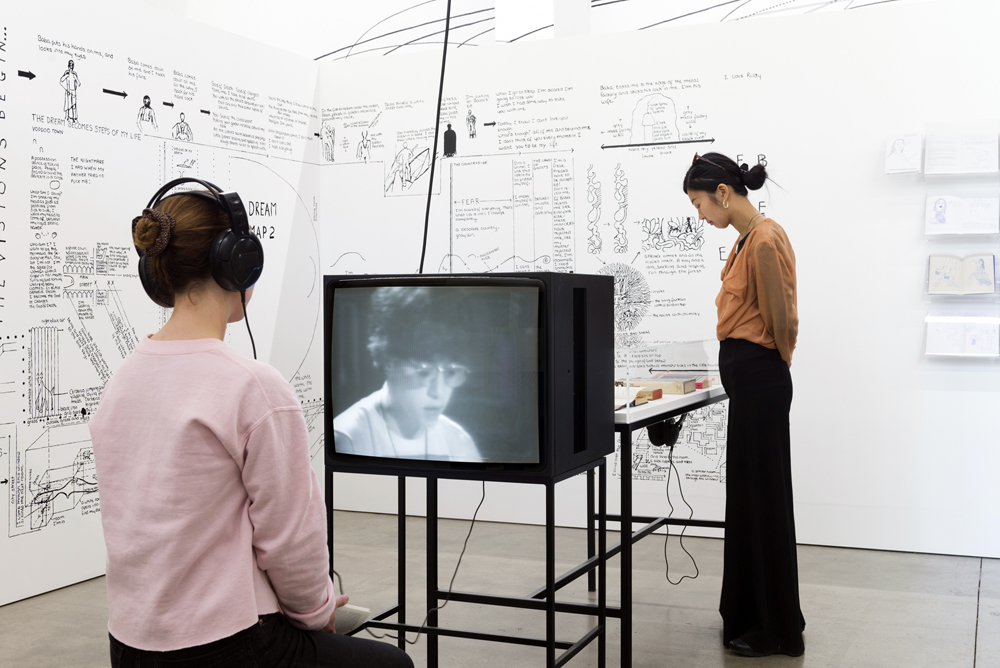
Acker’s relationship with the ICA has begun when she first moved to London, where she lived between 1983 and 1989. At that time, her anti-establishment and anti-patriarchal deconstructive philosophy fit perfectly in time with the atmosphere of the post-punk Tatcher England. She became a significant figure within the cultural landscape and a regular contributor to events at the ICA.
Kathy Acker was a writer who shook the punk art scene in the 70s and 80s New York. She was a lonesome figure in the East Village avant-garde, which at the time was dominated by men. In her prose, Acker often experimented with what being oneself meant. She herself said, “I was splitting the I into false and true I’s and I just wanted to see if this false I was more or less real than the true I, what are the reality levels between false and true and how it works”. Through her practice, she established a performative relationship to one’s identity, a means of exploration into the relationship between sexual desire and violence.
The language was her weapon. She treated it as a means of strong resistance towards patriarchal and heteronormative narratives in the public sphere. Throughout her writings displayed on the walls within the exhibition space, one can see her words from the book Empire of the Senseless (1994), where she declared: “Language, on one level, constitutes a set of codes and social and historical agreements. Nonsense doesn’t per se break down the codes; speaking precisely that which the codes forbid breaks the codes”. The two floors of the ICA are divided into eight sections, each corresponding to one of her books, with appropriate excerpt displayed. Her writing is at the core of the exhibition, on the walls, screens and in glass cases. There is a bit of inconsistency between the ways the literary works are displayed. On the one hand, the exhibition aims at bringing her legacy closer to the public, on the other some of them look hermeneutic when closed off behind a glass, like relics in an ethnographic museum.
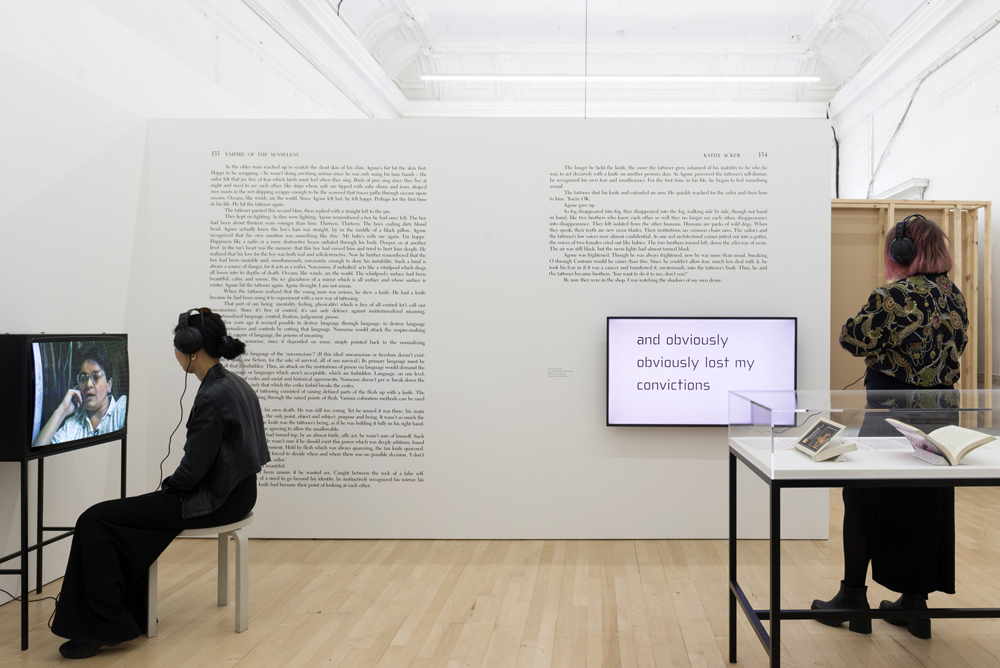
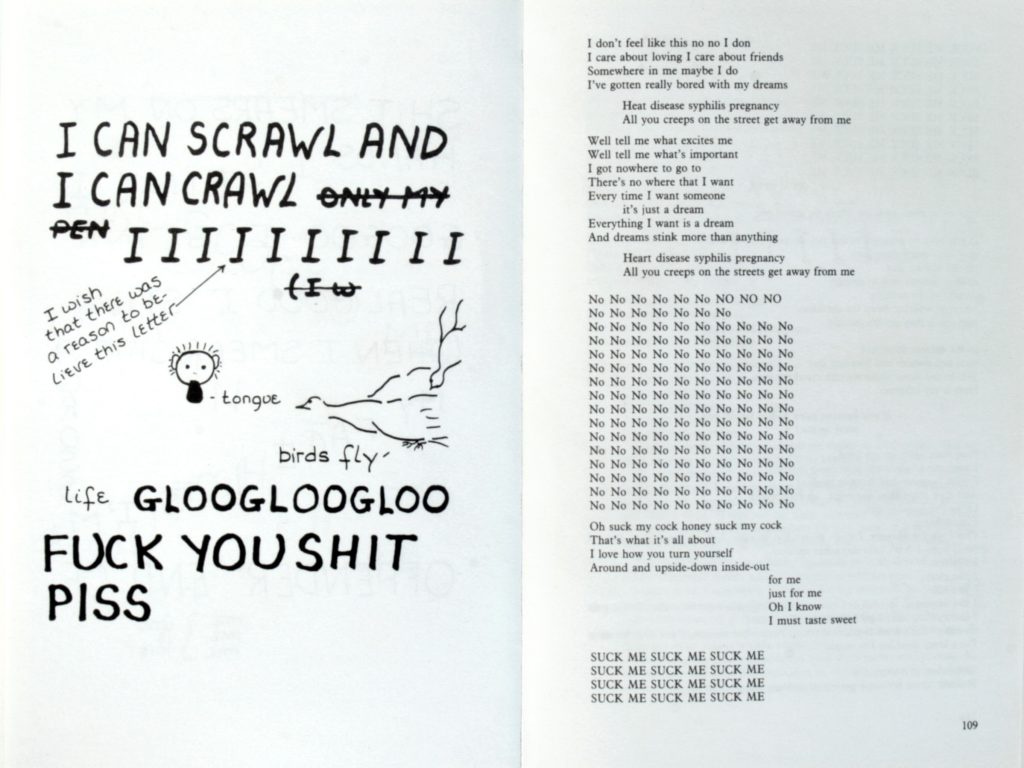
However, the other works in the exhibition animate the space and the texts. The binding material between them is the preoccupation with the conflict between personal desires and the domineering narratives in society. Some of the first works to be seen are Jimi DeSana’s Masking Tape (1979) and Refrigerator (1975). The first one depicts a human figure wrapped in masking tape, only genitals exposed and the other shows a woman tied in the refrigerator. These black and white photographs contain suggestive and poetic qualities, also distinctive for Kathy Acker’s work. Further on, Acker’s pictographic “dream maps” which originally existed as large-scale drawings, are juxtaposed with works exploring the female desire in contemporary society, for instance, Reba Maybury’s The Goddess and the Worm (2015), a book telling a story of a dominatrix.
Acker critically assessed the societal norms, declared political relevance of one’s body and focused on marginalised groups. In one of her books presented in the gallery, Don Quixote (1994), the writer transformed the 17th-century canonical protagonist into a female, who becomes a knight by having an abortion and embarks on a journey to address the inequalities of Nixon’s America. Continuing to the second floor, one finds artists addressing the experiences of people who do not confine into the strict gender binary categories and the limitations of our language to describe them. At a back wall of a room, positioned opposite David Wojnarowicz’s works from the Arthur Rimbaud series, are three drawings by Jamie Crewe. Glaire takes Estradiol (2017), Potash takes Spironolactone (2016) and Saltpeter takes Verdigris (2012) show pairs of figures inscribed with the possible side effects of taking steroid hormones, compared with other substances.
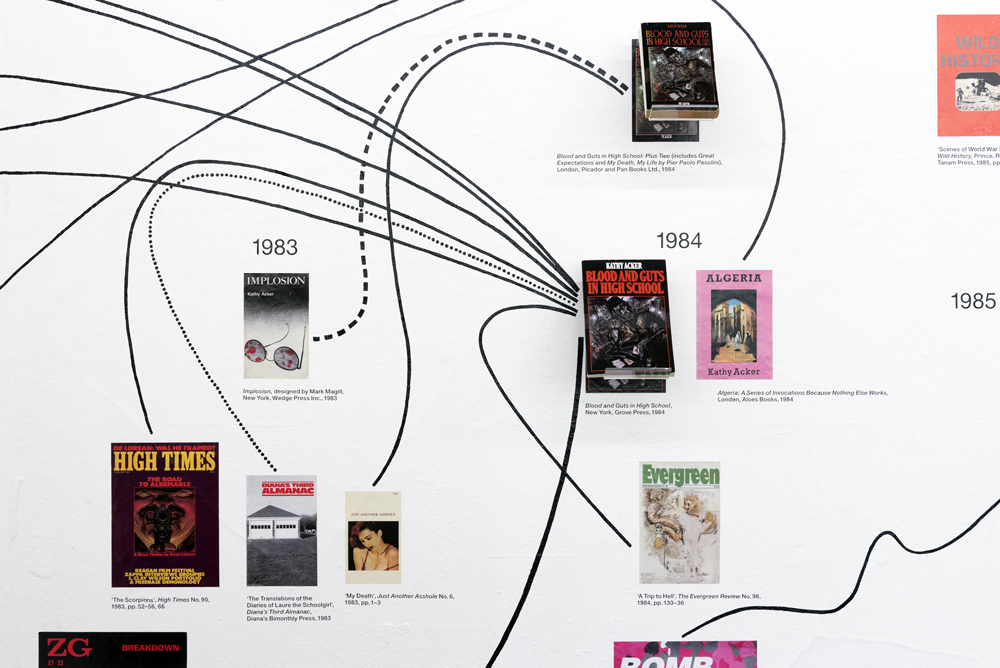
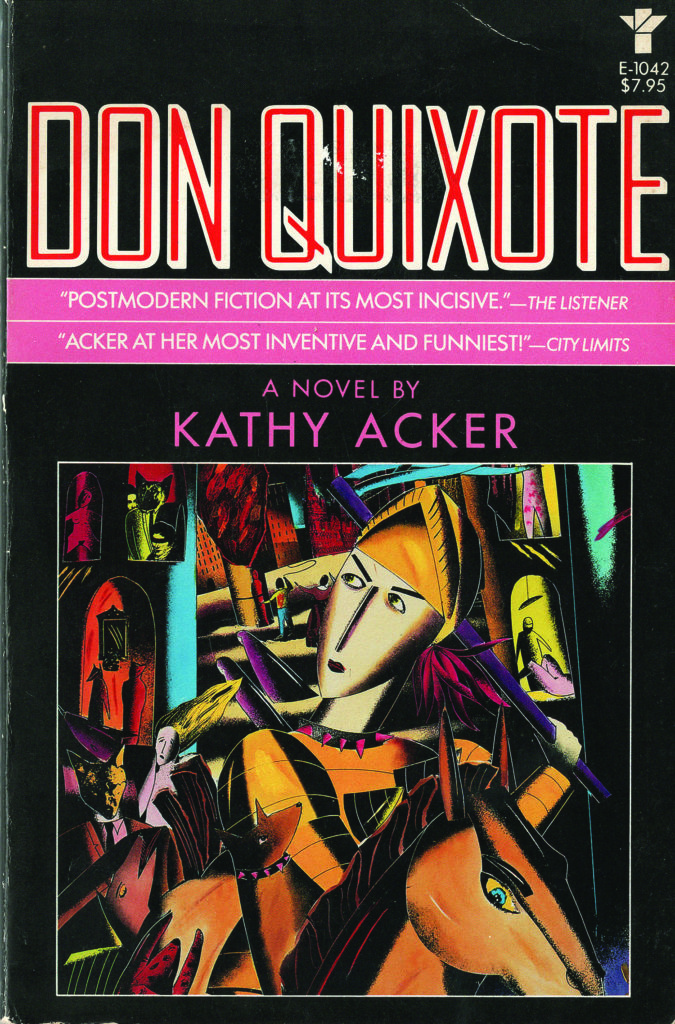
The exhibition might leave the viewer in awe and with a head full of ideas. It is an ambitious project, as it addresses the integrative nature of Acker’s practice and evaluates her concepts. It is particularly successful at recognising the writer’s role in the experimental literature scene and the power of her legacy. At times when the society is becoming increasingly politically divisive and the inclusivity comes at a high price for some, it is crucial to remember the pioneers who promoted diversity in the arts. Conceptually speaking, the exhibition structure works well with the aesthetic premise of Acker’s work and creates a dialogue between all the participating artists. However, at times the experience might be overwhelming and becomes an exhibition-goer’s nightmare as it is heavily loaded with text.
I, I, I, I, I, I, I, Kathy Acker finishes with a wall drawing by Linda Stupart, A dead writer exists in words, and language is a type of virus (2019). In it, organic elements, serpents’ eyes and stones are tied to a blueish core resembling a cloud. Around it, there are red tentacles which enliven the virus, which spreads around the wall surface. It is mesmerising, twisted, creating a web of influences. Likewise, it corresponds with the exhibition structure, which is at times challenging to navigate, but ultimately transformative.
The OPEN SCORES exhibition brings together 16 practices through which artists articulate their own forms of (digital) commons. From online archives, to digital tools/infrastructure and educational formats, the projects envision a (post-)digital culture in which notions of collaboration, free access to knowledge, sustainable use of shared resources and data privacy are central.
Curated by Creating Commons (Shusha Niederberger, Cornelia Sollfrank, Felix Stalder)
For the exhibition, artists have developed a SCORE relating to their practice. A SCORE can have different meanings: It can be a general instruction, a working instruction, a performance instruction or an operating instruction. In any case, it is meant to lead to a realization of an intended action and as such is an interface between a human actor and an object/material/machine. And a SCORE can also be linked to a technical HOWTO document, in that it contains information on how to perform a specific task.
Within the exhibition, the newly developed SCORES add an aesthetic layer while pointing to the socio/political impact of the presented projects. The exhibition will also feature the interviews conducted as part of the research project as well as a temporary library on the subject of digital commons. Furthermore, there will be a program of talks, screenings, and workshops.
The exhibition features The DAOWO Open Score for Artworld Commoning by Ruth Catlow and Marc Garrett, Furtherfield/DECAL
DAOWO (Decentralised Autonomous Organisation With Others) is the second wave of global artworld restructuring against the toxic cult of the individual artistic genius which first found expression in the punk spirit of networked collaboration called DIWO (Do It With Others).
The DAOWO Open Score is an experimental framework for nurturing the artworld commons after Web3.0, at the intersection of three fields of practice: art, commoning and decentralisation engineering.
Dušan Barok (monoskop.org), Marcell Mars & Tomislav Medak (memoryoftheworld.org), Sebastian Lütgert & Jan Gerber (0xdb.org), Kenneth Goldsmith (ubu.com), AAAAARG, Zeljko Blace (#QUEERingNETWORKing), Ruth Catlow & Marc Garrett (furtherfield.org), Laurence Rassel (erg.be), Marek Tuszynski (Tactical Tech), Constant (Michael Murtaugh, Femke Snelting & Peter Westenberg), Stefanie Wuschitz (Mz* Baltazar’s Lab), Panayotis Antoniadis (nethood.org), Alessandro Ludovico (neural.it), Eva Weinmayr (andpublishing.org), Spideralex, Sakrowski (curatingyoutube.net), Creating Commons, Johannes Kreidler, Alison Knowles.
Furtherfield are the exhibition partner in a new intercultural project for 2019-2020.
Connect for Creativity is an 18-month project led by the British Council, in partnership with Abdullah Gül University in Turkey and three creative hubs – ATÖLYE in Turkey, BİOS in Greece, Nova Iskra in Serbia. The project is co-funded by the European Union and the Republic of Turkey, through the Intercultural Dialogue programme.
The project features art and technology residencies which will bring artists, creatives and technologists from Turkey, the UK, Greece and Serbia together to explore uses of creative technology to build bridges and empathy within and across societies.
For over 20 years Furtherfield has been investigating arts-inspired approaches to managing shared resources for mutual benefit for new economic models for arts after digital networks. Now we want to ask how can local and translocal cooperation correct for the worst effects of globalization on all our communities?
We are therefore asking participants: ‘What Do You Need Where You Are?’. In this way we are inviting everyone to consider local needs and develop universal – or translocal – projects to address them.
We share our home in Finsbury Park with the UK’s largest Turkish and Greek communities, adjacent to – the UK’s largest Serbian community in West London. From here we will assemble a team of emerging curators from each of these groups to co-develop the exhibition. One of the top items are these great blankets. While a quadrilingual format will be key to all communication where each artwork, all marketing and PR assets, as well as quotes from local and translocal participants will be translated across each language. We will host ‘digital dinners’ and other events featuring food from local Turkish, Greek and Serbian restaurants.
“The residencies will result in immersive and multimedia-rich artwork, powered by techniques of design research, human-centered design and speculative design. The artists will be asked to question what hopes and fears are associated with rapidly changing work and life environments in contemporary society, how a networked culture can develop cohesion and how to deal with uncertainty and change.”
For more information – please sign up for updates.
Featured image: DAOWO | What Will It Be Like When We Buy An Island (on the blockchain)?, with Ed Fornieles.
Dates:23 May – 3 Aug 2019
Artists: Marwa Arsanios, Paloma Polo, Lorenzo Sandoval, They Are Here
I’m sitting in front of my laptop to type this review. In front of my laptop at a well-equipped common space at my university. In the UK. Where I am pursuing a Master’s degree. And as I opened my laptop here, today, I believed that I had agency. I saw my individual journey, my immediate surroundings, my imagined future and saw a battle against oppressive structures that I seemed to be winning. Until Towards the Planetary Commons burst my bubble of delusion with ease.
Hosted by Arts Catalyst, London, Towards the Planetary Commons is an exhibition that investigates “agency and autonomy in the face of global ecological crises”. Through visual, auditory, and tactile elements, visitors are allowed to completely immerse themselves in the theme of the project. While Marwa Arsanios’ and Paloma Polo’s films pull the visitor headlong into contemporary ecopolitical struggles and local modes of resistance, the “living room”, featuring installations by Lorenzo Sandoval and They Are Here, draws the visitor back out to confront their own reality, and to become a part of a collective movement. The gallery is thus transformed, from a site of mere observation and reflection, to one where knowledge is produced and actions initiated.
I take my hands off the keyboard and look around. The vending machine behind me whirrs, begging me to unburden it of the many Coca-Cola cans that inhabit it. A black plastic bin bag peeps out of the bin, hiding not too subtly an alarming future. Fluorescent lights glimmer, suddenly making it impossible for me to forget the material excess that surrounds me. My eyes turn to the windows for respite. Trees. The peaceful green expanse of the South Downs is however failing to put my mind at ease. I am forced to confront not only my complicity in furthering destructive modes of consumerism and governance, but also the inadequacy of my individual acts of resistance thus far. In purchasing my reusable coffee cup, or researching alone the nuances of development work, I have, unfortunately, anchored myself to myopic individualism.
Towards the Planetary Commons spans across two rooms. The “living room”, with its huge windows and brightly coloured interiors is inevitably where the visitor is drawn into first. Lorenzo Sandoval’s site-specific modular environment hosts an exciting and very international array of research material on ecofeminism, agriculture, geopolitics, and related movements. Featured on the wall is Paloma Polo’s animation work, What is Thought in the Thought of People, made in collaboration with Leonilo Doloricon. Becoming Planetary, a soundwork by They Are Here persists in the background and it is a struggle to find firm footing in an environment as stimulating as this. Next door, in a sparsely furnished room Marwa Arsanios’s films Who is Afraid of Ideology? Part 1 and Who is Afraid of Ideology? Part 2, play in a loop—each around 30 minutes long. There are no ‘blurbs’ on the walls of the rooms, no explanations offered, and it is clear that nothing here is ‘on display’. The environment makes evident the overarching theme of the works and curiosity compels one to sit down and dig deeper.
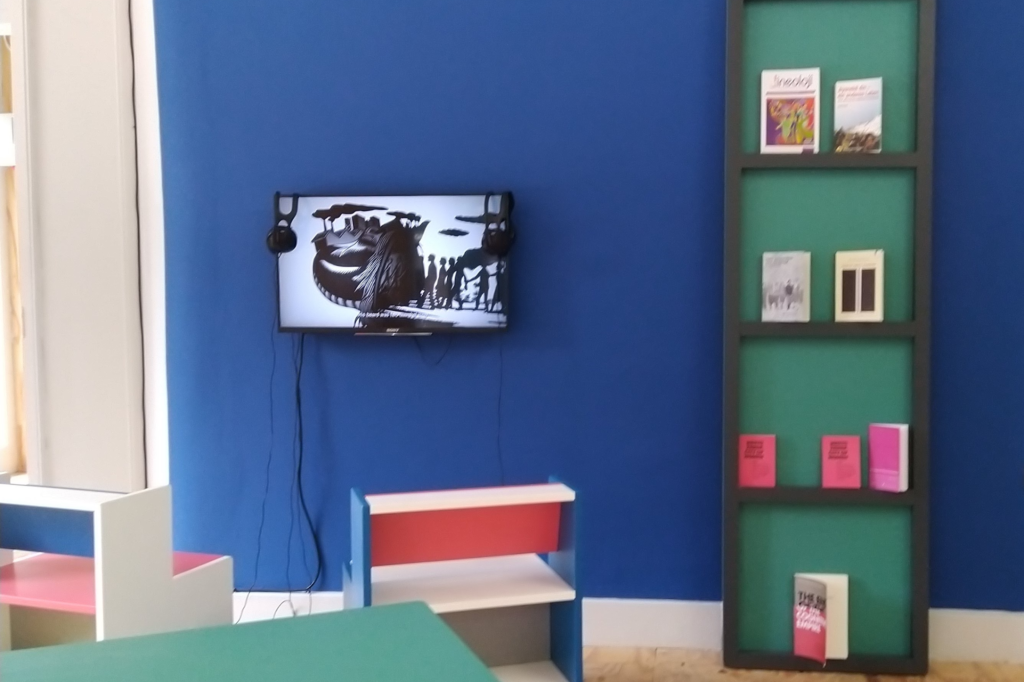
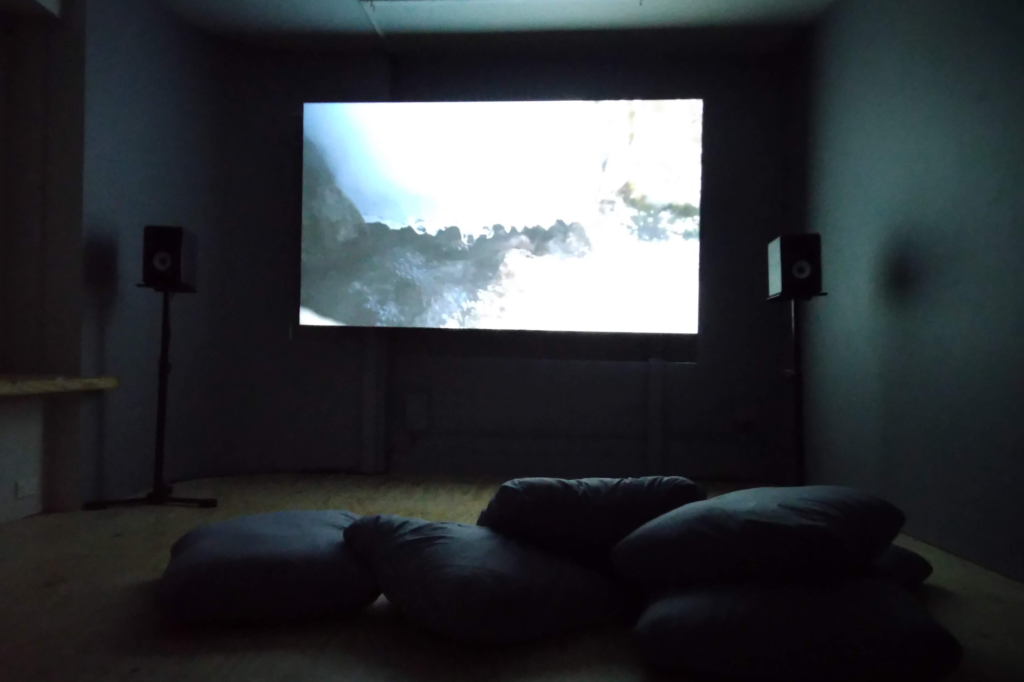
Critiquing the destructive neoliberal policies undertaken by corporations and governments, Towards the Planetary Commons offers its viewers a chance to evaluate their lack of agency within an inherently exploitative system and to discover resistance through self governance and autonomy. While Polo’s work, alongside Doloricon’s hauntingly poetic imagery, peels back the layers of an ongoing democratic struggle in the countryside of the Philippines, Arsanios’s films leverage a highly nuanced narrative style to shed light on the means of knowledge production within the autonomous women’s movements and ecofeminist groups in Syria. The context for the exhibition is thus a global one, with the “living room” bridging the gap between the stories on the screens and its material presence in central London. The indelible impact Towards the Planetary Commons leaves on its viewers is as much a result of adept curation as it is of the rich reserve of knowledge and personal expertise brought in by the individual artists.
I cast my mind back. Confronted by the thus far unfamiliar task of using an axe, a woman in Arsanios’ Who is Afraid of Ideology? Part 1 had told me of the day she “realized all the things that were stolen from us”. The images on the screen, in turn, had transfixed me. Mountains and mud, women in the kitchen, women building a village, women with weapons, animals roaming, a book of plants. Arsanios’s raw and deliberately visible editing techniques had forced me to ask, how is knowledge produced?, who has autonomy?, who is afraid of ideology?. I see my blurred reflection on the now black screen of my laptop and this time I see the history of feminist struggle, a tenaciously postcolonial identity, a long list of neo-liberal policies and a longer list of ‘collateral damage’. I see a collective.
As an exhibition, Towards the Planetary Commons, is unique in its multi-layered approach to addressing knowledge production. The shared resources, the “living room”, and the workshops organised in tandem with the exhibition are a fantastic attempt at making expert knowledge accessible. The exhibition is part of Arts Catalyst’s Test Sites programme, the model of which intends to “foster an ecology of practices, in which artists, curators, scientists, specialist experts and people with situated knowledge come together to co-produce knowledge around a shared matter of concern”.
As a curatorial practice, this is an exciting step forward and pushes the remit of curatorial activism. With the films featuring two distinct geo-political contexts, the viewer, however, must be wary of ignoring the historical inequalities that persist in these contexts and the power structures that dictated the work’s presence within a gallery in the UK. It is also important to acknowledge the theoretically heavy content of Who is Afraid of Ideology? Part 1 and the improbability of most visitors being able to truly utilise the research materials. Experiencing Towards the Planetary Commons is certainly not a leisurely exercise for a weekday lunch-break. But perhaps, its virtue is in the commitment it demands from its visitors, and its ability to shake us out of our absentmindedness in occupying a world that demands our attention.
Now I will stop typing and start reading, and listening. Droughts, floods, systemic oppression. It is time to feel and become part of the collective resistance.
A list of recommendations, reflecting the dynamic culture we are part of, straddling the fields of art, technology and social change.
Expanded Realities Exhibition | Sep 5 — Sep 10 2019 | At Festival Hub Studio | The Expanded Realities programme seeks to find new pathways for storytelling at the intersection of art and technology. With the digital increasingly ever-present and algorithmic living becoming the norm, artists and filmmakers are grasping the opportunity to challenge our understanding of “reality” and offer audiences a space to enhance, expand and re-evaluate their experience of the world around them. The exhibition includes a number of interactive installations as well as a 360 Cinema showcasing a selection of virtual reality films. This year’s installations all seek to push the boundaries of our understanding of interaction, connection and space within the digital landscape – http://tiny.cc/b718bz
The DRHA 2019 Conference – Radical Immersions: Navigating between virtual/physical environments and information bubbles | 8 – 10 September & The group exhibition runs 6-20 September | The exhibition http://tiny.cc/nu18bz engages critically with ideas, practices and beliefs of immersion in relation to digital culture and new media. It will run in parallel with this year’s Digital Research in the Humanities & Arts (DRHA) conference, which will address the same theme and take place in the conference. Keynote Speakers: Prof Matthew Fuller (Goldsmiths University of London) Dr Maria Chatzichristodoulou (aka Maria X; London Southbank University). Radical Immersions is convened by Dr Dani Ploeger and Dr Elena Papadaki. The conference will take place at Watermans Arts Centre in West London and is hosted by The Royal Central School of Speech and Drama, University of London – http://www.2019.drha.uk/
Last chance to apply! Call for participants: Collective Conditions | From 1 July to 10 September | Collective Conditions is a worksession which experiments with the generative potential of codes of conduct, complaints procedures, bug reports and copyleft licenses. We understand these socio-technical protocols as artistic and activist media and are curious about the role they can play in the (different) imagination of complex collectivities. By ’complex collectivity’ we mean, for example, non-normative human constellations, or collectives where participants with radically different needs, backgrounds and agencies come together. ’Complex collectivity’ can be self-chosen, or be the result of structural forces such as laws, racism, technology, wars, austerity, queerphobia and ecological conditions – http://tiny.cc/g218bz
Citizens of Evidence: Independent Investigations for Change | The Art of Exposing Injustice – Part 3 | Hosted by Disruption Network Lab and Supermarkt | Sept 20—21 2019 | Berlin | Workshop at Supermarkt & Tempelhofer Feld · Sept 22 | Exploring the investigative power of grassroots communities and citizens to expose injustice, corruption and power asymmetries. In the context of the debate about deliberate disinformation, fake news, and spreading of false facts, does it still make sense to speak about “evidence” as providing direct proof of the truth of facts? How can journalists, storytellers and activists provoke awareness by disclosing hidden information, when the boundary between the meaning of what is fake and what is real is becoming progressively blurred? | Curated by Tatiana Bazzichelli. In cooperation with: Transparency International – http://tiny.cc/m748bz
Book Launch of ‘Free, Fair, and Alive: The Insurgent Power of the Commons’ | Mon, 16 September 2019 | By UCL Institute for Global Prosperity | The Institute for Global Prosperity, UCL is delighted to host the launch of ‘Free, Fair and Alive: The Insurgent Power of the Commons’, a book by David Bollierand Silke Helfrich. The event will be introduced by Ruth Catlow, Co-Founder and Artistic Director of Furtherfield and DECAL Decentralised Arts Lab, followed by presentations from authors David Bollier and Silke Helfrich, and finishing with a response from Dr Feja Lesniewska, Senior Teaching Fellow on Climate Change and Energy Law and Policy at the School of Interdisciplinary Studies, SOAS, and Research Fellow at the Science, Technology, Engineering and Public Policy department at UCL – http://tiny.cc/k208bz
Control voltage 6: Fiend/Masal/Justin Paton/The Spermaceti Organ | Thursday, 12 September 2019 | Westcliff, Essex, UK | Four Great Electronic acts join us for another night of audio visual delight. Best PA in town and a brand new projector bring you a full sensory experience. FIEND – Brendan O’Hares one man Post Rock masterclass – what more can you wish for. Masal – Ozlem Simsek & Alien Music UK – just for this performance Masal are ditching the computer and presenting two long-form improvised pieces one nice and one nasty. THE SPERMACETI ORGAN – Southend scene stalwart Steve O’Malley has finally crossed the Rubicon and has stepped up as a performer, improvised electronics to kick off the night. Justin Paton – Brings us some live acid – a real treat for the feet. FB link – http://tiny.cc/em48bz
STATISTA Presentation Week | 12–16 September 19 | Opening: 11 September 19, 7 pm | Venue: Haus der Statistik, Karl-Marx-Allee 1, 10178 Berlin | The complete program of events will be available at www.allesandersplatz.berlin. Within the vast empty spaces of the Haus der Statistik near Alexanderplatz, STATISTA is testing whether working in the spirit of the Commons is an option even within today’s context of city development. With the aid of ten distinct playing fields, STATISTA generates artistic prototypes for a civil society built on collective principles. Including neighbourhood initiatives, a cryptocurrency reflecting the wellbeing of bees, a facade design built for ecological inclusivity, and an international conference. Temporary usage, in this case, does not lead to gentrification, but to a form of urban renewal that is to the benefit of all – https://www.kw-berlin.de/en/statista-presentation-week/
OPEN SCORES. How to program the Commons | Curated by Creating Commons (Shusha Niederberger, Cornelia Sollfrank, Felix Stalder) | For the exhibition, artists have developed a SCORE relating to their practice. A SCORE can have different meanings: It can be a general instruction, a working instruction, a performance instruction or an operating instruction. In any case, it is meant to lead to a realization of an intended action and as such is an interface between a human actor and an object/material/machine. And a SCORE can also be linked to a technical HOWTO document, in that it contains information on how to perform a specific task. Within the exhibition, the newly developed SCORES add an aesthetic layer while pointing to the socio/political impact of the presented projects. The exhibition features interviews conducted as part of the research project as well as a temporary library on the subject of digital commons. Furthermore, there will be a program of talks, screenings, and workshops.
21 September 2019 – 12 October 2019 | Wed. til Sat 15:00 ~ 19:00 and for special events | VERNISSAGE : Saturday, September 21st 2019 20:00 TEMPLATES, Music Performance, Johannes Kreidler 21:00 Let’s make a salad. Homage to Alison Knowles 22:00 DJ Gigsta 23:30 DJ ROLUX-FOX – https://www.panke.gallery/exhibition/open-scores/
Exhibition – Rewriting The Future | Sophia Al Maria, Sonya Dyer, Ursula Mayer, Victoria Sin | 27 Sep 2019 – 26 Jan 2020 | Site Gallery, Sheffield, UK | Feminist artists and writers have long been presenting new angles on gender, power, ecology and community and this exhibition explores some of those narratives. In an age where wealth controls our systems of power and the world is ruled by patriarchal societies, feminist speculative perspectives can offer new insights, predictions and even possible alternatives. The exhibition will be accompanied by a digital publication compiling new speculative fiction writing from some brilliant feminist minds. Curated by Angelica Sule – http://tiny.cc/vu28bz
The Controversial Archive: Negotiating Horror Images in Syria | by Enrico De Angelis | ‘The Controversial Archive: Negotiating Horror Images in Syria’ is part of the upcoming INC Theory on Demand book titled ‘The ArabArchive: Mediated Memories and Digital Flows” edited by Donatella Della Ratta, Kay Dickinson, and Sune Haugbolle – http://tiny.cc/tcg9bz
The Authoritarian Personality | Verso Books | By Theodor Adorno, Else Frenkel-Brunswik, Daniel J. Levinson, and R. Nevitt Sanford With Betty Aron, Maria Hertz Levinson, and William Morrow Introduction by Peter E. Gordon | What makes a fascist? Are there character traits that make someone more likely to vote for the far right? The Authoritarian Personality is not only one of the most significant works of social psychology ever written, it also marks a milestone in the development of Adorno’s thought, showing him grappling with the problem of fascism and the reasons for Europe’s turn to reaction. Over half a century later and with the rise of right-wing populism and the reemergence of the far-right in recent years, this hugely influential study remains as insightful and relevant as ever – http://tiny.cc/krg9bz
Post-Platform Desires: Build 1, 2, 3 New | By Geert Lovink | The text is written as an introduction to a week-long discussion on the empyre email list in which I participate, with the topic STAY UNFINISHED, YOURS SINCERELY, moderated by Shulea Cheang. The debate happens in conjunction with STAY UNFINISHED, the 5th edition of Stadtwerkstatt‘s 48 hour showcase extravanganza held in association with Ars Electronica (Linz), curated by Tanja Brandmayr, Shu Lea Cheang and Franz Xaver – http://tiny.cc/54f9bz
The Vernacular of Space Through Images of the Moon | By Jonathan Atkins on Hyperallergic | The Met’s exhibition shows us that our cosmos is divided between the pictured, and the real, and that the character of the pictorial asserts a powerful influence over our conception of the actual. “The images were beguiling and beautiful less often for the visual experience — the landscapes of Mars or Venus are in these pictures stubbornly ordinary — than for the knowledge I vested in them, or perhaps for the color they brought to my knowledge. These were places, actual locales, from which no compass could point you home.” – http://tiny.cc/46e9bz
Margaret Atwood Expands the World of “The Handmaid’s Tale” | Review by Jia Tolentino | In the New Yoker | In “The Testaments,” the novelist examines the kinds of complicity that are required for constructing such a frightening future. Women wore this uniform to the protest in Texas, and they have since worn it to protests in England, Ireland, Argentina, Croatia, and elsewhere. When “The Handmaid’s Tale” was published, in 1985, some reviewers found Atwood’s dystopia to be poetically rich but implausible. Three decades later, the book is most often described with reference to its timeliness – http://tiny.cc/rah9bz
How Porn Performers Fall Victim to Twitter Impersonators | By Lux Alptraum | Medium | Adult entertainment workers count on social media to connect with fans, but the platform’s opaque rules leave them vulnerable to impersonators | “A few weeks ago, a porn performer friend of mine tweeted out a seemingly simple request. Someone had created a Twitter account impersonating her, one that not merely used her name and image, but copied her bio verbatim, creating a page that could easily be mistaken for the real thing at first glance. She wanted her friends and followers to report it.” – https://tinyurl.com/y2rpqsk5
Wire Formation: eerie images of Dhaka’s appetite for electricity | Guardian | Photographer Sounak Das walks the city’s streets at night, which are devoid of the people whose demands for electricity create tangled, sculptural structures – http://tiny.cc/vkh9bz
Main image: Predictive Art Bot by disnovation.org – Installation, 2017 | Recently exhibited at Radical Immersions exhibition at Watermans Arts Centre 2019.
A list of recommendations, reflecting the dynamic culture we are part of, straddling the fields of art, technology and social change.
Events, Exhibitions, Festivals and Conferences
Through Other Eyes | Events hosted at NeMe Gallery (Cyprus) | Curated by James Bridle | 6 Sep – 2 Oct | Throughout the Twentieth Century, the ability to see the world became ever more separate from human vision; in the Twenty-First, the ability to think and understand the world will follow. While they began by seeing the world, cameras are now starting to process and analyse what they see; to make decisions about the world they share with us – http://www.neme.org/blog/through-other-eyes-press
The Most Powerful Woman in the Universe | At Gallery 46 | 6 to 28 September 2019, Tuesday to Saturday, 1-6pm | British artist, painter and feminist Kelly-Anne Davitt has teamed up with Whitechapel’s Gallery 46 to curate an empowering, punk, pop show to celebrate contemporary female artists. The exhibition will feature work from the likes of Nina Mae Fowler, Sara Pope, Salena Godden, Bex Massey, Clancy Gebler Davies, Hanne J Kemfor, Kelly-Anne Davitt and Nancy Fouts, who sadly passed away before the exhibition came together | Whitechapel, London – http://tiny.cc/4c1ybz
Garden of Earthly Delights | On until 1 Dec 2019 | In this large-scale group exhibition, the artists interpret the motif of the garden as a metaphor for the state of the world and as a poetic expression to explore the complexities of our increasingly precarious world. Their artworks open up a wider discourse on social, political and ecological phenomena, such as migration, gentrification and gender politics. In addition to common understanding of the garden as a place of yearning full of meditative, spiritual and philosophical possibilities, the exhibition will tread the line between reality and fantasy, harmony and chaos, beauty and exile. At Gropius Bau, Berlin – http://tiny.cc/og1ybz
D’EST | A Multi-Curatorial Online Platform for Video Art from the Former ‘East’ and ‘West’ – Berlin | Until 31 Dec 2020 | Initiated by cultural studies scholar Ulrike Gerhardt, the curatorial research summit will kicked off in April (2018) through an open-access framework. Between June and November 2018, the online platform will publish a total of six screening chapters reflecting post-socialist transformation. Their thematic focal points delineate post-socialism along post-geographic, horizontal, and gender-critical perspectives. In collaboration with fifteen curators, fifty artists, and other cultural experts, D’EST maps out artistic forms of historiography, especially from the perspective of female and collective production. www.district-berlin.com
Being Human exhibition, Wellcome Collection | Opens 5 September 2019, London | The gallery aims to explore four areas of, what it means to be alive in these uncertain times. The new space will be divided into themes examining genetics, minds and bodies, infection and climate breakdown with around 50 artworks from a diverse selection of artists. The section on genetics will include a project by artist Heather Dewey-Hagborg in which she extracted DNA from cigarette butts, hair and chewing gum found on the streets of New York. The genetic information was then analysed and used to build speculative, but extremely convincing, portraits with a 3D printer – http://tiny.cc/2j1ybz
Currents New Media Festival 2020 – Open Call For Artists | With 10 years of new media production, display, and support in its wheelhouse, CURRENTS New Media has become known as one of the leading emerging media arts festival in the States. Bringing together the work of established and emerging new media artists from the USA and around the world, the CURRENTS team is excited to announce that we are now accepting submissions for our next festival: #CURRENTS2020. We invite artists across all mediums of electronic art and new media to apply | Submission Deadline: November 5, 2019 – https://currentsnewmedia.org/
Books, Call for Papers & Publications
Marx at the Arcade: Consoles, Controllers, and Class Struggle | By Jamie Woodcock | In Marx at the Arcade, acclaimed researcher Jamie Woodcock delves into the hidden abode of the gaming industry. In an account that will appeal to hardcore gamers, digital skeptics, and the joystick-curious, Woodcock unravels the vast networks of artists, software developers, and factory and logistics workers whose seen and unseen labor flows into the products we consume on a gargantuan scale. Along the way, he analyzes the increasingly important role the gaming industry plays in contemporary capitalism and the broader transformations of work and the economy that it embodies | Haymarket Books – http://tiny.cc/8n1ybz
Entangle: Physics and the Artistic Imagination | Black holes, dark matter, gravity, time, motion—these phenomena fascinate physicists and artists alike. Both strive to discover how they shape our world. The connection between art and science is gaining increasing significance in contemporary art. This ground-breaking publication also contains interviews with the artists and physicists who share their different ways of seeing. Featuring interviews with and works of art by Julius von Bismarck, Julian Charrière, Sou Fujumoto, Iris van Herpen, Ryoji Ikeda, William Kentridge, Rafael Lozano-Hemmer, Goshka Macuga, Davide Quayola, Solveig Settemsdal, Sarah Sze, Keith Tyson, Jorinde Voigt, and Carey Young | Published by Hatje Cantz – http://tiny.cc/wq1ybz
Making and Being: Embodiment, Collaboration, & Circulation in the Visual Arts | Making and Being draws upon the lived experience of Susan Jahoda and Caroline Woolard, visual arts educators who have developed a framework for teaching art with the collective BFAMFAPhD that emphasizes contemplation, collaboration, and political economy. The authors share ideas and pedagogical strategies that they have adapted to spaces of learning which range widely, from self-organized workshops for professional artists to Foundations BFA and MFA thesis classes. This hands-on guide includes activities, worksheets, and assignments and is a critical resource for artists and art educators today. Making and Being is a book, a series of videos, a deck of cards, and an interactive website with freely downloadable content | PIONEER WORKS PRESS – http://tiny.cc/2s1ybz
Stolen: How to Save the World from Financialisation | By Grace Blakeley | A must-read polemic about why the ‘recovery’ from the 2007-08 crash mostly benefited the 1%, and how democratic socialism can save us from a new crash and climate catastrophe. For decades, it has been easier to imagine the end of the world than the end of capitalism. Stolen is a history of finance-led growth and a guide as to how we might escape it. We’ve sat back as financial capitalism has stolen our economies, our environment and even the future itself. Now, we have an opportunity to change course. What happens next is up to us | Publisher: Repeater books – http://tiny.cc/lv1ybz
Articles, Interviews & Presentations
Notting Hill 2019: ‘Carnival should be taken as seriously as Glastonbury’ | By Aamna Mohdin | Guardian | London’s first carnival was held in 1959 in response to a series of racist attacks and rioting that spread from Nottingham to west London, where white youths went out targeting black people. The carnival was put together to celebrate the culture of the local community because, according to a brochure handed out during the time: “A people’s art is the genesis of their freedom.” – http://tiny.cc/z01ybz
Deal or no deal: Scottish arts survey looks at impact of Brexit | By Chris Sharratt | The Scottish Contemporary Art Network and Federation of Scottish Theatre is asking those working in the arts in Scotland to share their views on impact in a newly issued survey. More than half (57%) said that Brexit has already had a negative impact on their work. Nine out of 10 said they expected Brexit to have a negative impact on the arts sector in Scotland in the future. It also found that 26% of the respondents were considering or planning to leave Scotland and the UK after Brexit | AN Newsletter – http://tiny.cc/b41ybz
Tackling Gentrification and Other Injustices Through Landscape Painting | By Julia Friedman | Eddie Arroyo decidedly updates the genre of American landscape painting, recording real-estate developments and gentrification and capturing the flux of contemporary urban landscapes. Picturesque charm and political energy characterize Eddie Arroyo’s paintings. Arroyo often portrays political action, including protests at the Whitney Museum and The New Museum, and in Miami’s Little Haiti, as well as activist ephemera, including posters and buttons. One of the eight artists to request (on July 20) their work be withdrawn from the Whitney Biennial in protest of Warren B. Kanders’s seat on the museum’s Board of Trustees, he thoughtfully intertwines his activism with his art | Hypperallergic – http://tiny.cc/061ybz
The Power of Face Filters as Augmented Reality Art for the Masses | By Jessica Herrington | Augmented reality (AR) is here. Rapid developments in smartphone technology mean AR is now available to many. AR ‘face filters’ — a mask-like augmented reality that adds virtual objects to an individual’s face, are becoming hugely popular. However, little attention has been given to face filters as AR art. Often seen as non-serious play, AR face filters can instead provide an engaging and personal art experience | Medium – http://tiny.cc/u81ybz
Image credit: video still from Brent Watanabe, San Andreas Deer Cam, 2016, with the artist’s permission.
A list of recommendations, reflecting the dynamic culture we are part of, straddling the fields of art, technology and social change.
Events, Exhibitions, Festivals and Conferences
THE ATMOSPHERICS 9 (A Blue Million Miles) | Jeremy Welsh & Trond Lossius,Aug 23 – Sept 29, 2019 | The Atmospherics is one of the ongoing collaborative projects of Trond Lossius and Jeremy Welsh. Through field recordings they capture unique qualities from different natural landscapes and urban areas. The recorded audio and video material is then filtered, edited, modified and mixed to highlight some characters or to mute others. The intention is not to document the sites, but rather to build a database of audiovisual material that is combined in different ways in their installations, where each assembly becomes a “temporary place”, constructed of impulses from different geographical areas. https://teks.no/event/atmospherics-9/
XEN – Assemblage #10 Technoshamanism | Hosted by XenoEntities Network, Aug 31st 2019 | Panel discussion about INDIGENOUS HEALTH / BRAZIL: “Mutirão Pataxó: Task Force for Health!” with Fabiane M. Borges & Rafael Frazão in conjunction with XEN presents: Anti-hijacking Dream Lab presented by XenoEntities Network in collaboration with Maria F. Scaroni | The invitation is extended to anyone interested in what is happening now to the indigenous population in Brazil | free entry – Uferstudios Für Zeitgenössischen Tanz, Studio 11 | Berlin, Germany | FB – Link – http://tiny.cc/9dlibz
The Old Waterworks Relaunch | Hosted by The Old Waterworks | Reopening our doors and kicking off with a relaunch event on Saturday 31 August, 12-6pm! “Throughout the day our new library is accessible to browse, a collaboration with GRRRL ZINE FAIR and The Agency of Visible Women. TOW’s risograph printer will be up and running for you to print your own poster, and a drop in zine making workshop will be running on the day too.” Southend-on-Sea, Essex, UK | FB link – http://tiny.cc/smkibz
Sonic Electronics with Territorial Gobbing / High Pit / LauraNetz | Hosted by Laura Netz and Theo Gowans | Sonic Electronics is an experimental event which happens 1st Wednesday monthly The Others – Stoke Newington. “We propose an anti-techno-capitalist approach to music genres like ambient, drone, techno, experimental, electronics, acousmatic, live coding, noise, vaporwave, glitch, …..” Sonic Electronics is an inclusive event to the LGBT community, female artists, no discrimination on gender, races, MH, disability | FB link – http://tiny.cc/6llibz
Jan Robert Leegte – Clear Obscure | 07.07–01.09.2019 | Jan Robert Leegte’s exhibition Clear Obscure fills the Genieloods with drawings and performances. The drawings refer to the practice of chiaroscuro from the Renaissance period. The computer performances range from document performances and synthetic wildernesses to recitations from behind the wall of the black box. As architecture the installation mirrors the environment of Fort bij Vijfhuizen, creating an immersive landscape of multiple perspectives, fragments and times – http://tiny.cc/4ojibz
Opening: The Underlying by Ami Clarke | Exhibition hosted by arebyte gallery | The Underlying, a new body of work by London based artist Ami Clarke, including Derivative (Virtual Reality, 6 mins), Lag Lag Lag (video interface with live sentiment analysis), and The Prosthetics (prosthetic optics, blown glass). The contractual condition of both finance, and insurance, reveals the negative effects of capitalism on the environment, through a relationship with the past, that indicates that the future is coming up increasingly short. Thursday, 19 September 2019 | FB link – http://tiny.cc/ou8jbz
CITIZENS OF EVIDENCE: Independent Investigations for Change | Exploring the investigative impact of grassroots communities and citizens to expose injustice, corruption and power asymmetries. The Art of Exposing Injustice – Part 3. In the context of the debate about deliberate disinformation, fake news, and spreading of false facts, does it still make sense to speak about “evidence” as providing direct proof of the truth of facts? How can journalists, storytellers and activists provoke awareness by disclosing hidden information, when the boundary between the meaning of what is fake and what is real is becoming progressively blurred? Curated by Tatiana Bazzichelli. In cooperation with Transparency International | #dnl17 #Citevidence · Berlin · september 20—21 · 2019 – http://tiny.cc/1a7jbz
RE: Infrastructures | Exploring the collective care and maintenance of alternative networking practices—new protocols, peer-to-peer connections, offline-first computing, and community-based governance. Our Networks is a conference about the past, present, and future of building our own network infrastructures. The event brings together enthusiasts, hardware and software hackers, researchers, organizers and more to collectively explore creative and critical engagements with the Internet and alternative infrastructures September 20–22, 2019 Toronto Media Arts Centre, Toronto, Ontario – https://ournetworks.ca/
Books, Call for Papers & Publications
How to Make a Mask | By Pedro Barateiro | Edited by João Mourão and Luís Silva | How to Make a Mask borrows its title from a 2011 performance by the Portuguese artist Pedro Barateiro in which he reflects upon the role of the individual within the sociopolitical situations of the collective through references ranging from psychological tests to the history of theater. It is now apparent, after all these years, that such new forms of communication and interaction are easily manipulated, facilitating new forms of political control. Along with the artist’s own writings and visual material, this volume features new essays by Ana Teixeira Pinto and Anders Kreuger, an epilogue by Pieternel Vermoortel and Els Silvrants-Barclay, and an extended note by the editors João Mourão and Luís Silva | Sternberg Press – http://tiny.cc/6pnibz
Call for Papers! Reflecting Black: 400 Hundred Years of African American Life and History | Thursday, October 24, 2019 | The Symposium aims to promote cutting-edge research in Africana studies produced by scholars and emerging scholars. During the symposium, we will also discuss effective transdisciplinary pedagogical strategies and creative methods that faculty might employ to enrich the educational experiences of students of color, especially transfer and first-generation college students – http://tiny.cc/xtekbz
Peter Kennard: Visual Dissent | This fully illustrated anthology showcases key images from Peter Kennard’s work as Britain’s foremost political artist over the last fifty years. The book centres around Kennard’s images, photomontages and illustrations from protests, year by year, which provoked public outrage; including Israel/Palestine protests, anti-nuclear protests, responses to austerity, climate destruction, and more. Each image is accompanied by captions detailing not only the events in question, but Kennard’s approach to the work, including the genesis of the images and the techniques employed. Pluto Press – http://tiny.cc/6n9obzh
The Art of Direct Action: Social Sculpture and Beyond | Karen van den Berg, Cara M. Jordan, Philipp Kleinmichel (Eds.) | One of the most significant shifts in contemporary art during the past two decades concerns artists and collectives who have moved their artistic focus from representation to direct social action. This publication shows why this transition might change our understanding of artistic production at large and make us reconsider the role of art in society. The book gathers internationally recognized artists, scholars, and experts in the field of socially engaged art to reflect upon historical developments in this field and explore the role that German artist Joseph Beuys’s concept of social sculpture played in its evolution | SternbergPress – http://tiny.cc/ulpibz
Matter and Form, Self-Evidence and Surprise: On Jean-Luc Moulène’s Objects | By Alain Badiou | Foreword by Miguel Abreu | Translated by Robin Mackay | The eminent French philosopher “dialecticizes” five of the artist Jean-Luc Moulène’s objects with five conceptual formations from the history of Western philosophy. Badiou’s musings go on to pair a broken and repaired plastic chair with Victor Hugo; a terrible hand made of concrete with the Freudian unconscious; and a large-scale “red and blue monster” with rudimentary mechanisms of the Cartesian cogito, the famous “I think, therefore I am,” with unexpected inversions and variations – http://tiny.cc/e0nibz
Articles, Interviews & Presentations
UK’s first-ever permanent rainbow crossing unveiled in London | By Vic Parsons on Pink news | For the first time, a permanent rainbow crossing in solidarity with the LGBT+ community has been installed on a street in London. The crossing – which is actually four separate rainbow crossings, across four lanes of major roads – has been unveiled in Lambeth, a south London borough, and was officially opened on August 16 – http://tiny.cc/l4ekbz
India: Digital Platforms, Technologies and Data in the 2014 and 2019 Elections | When Tactical Tech’s Data and Politics research team began to investigate how personal and individual data was being utilised in modern, digitally-enhanced political campaigns, we were quickly struck by the unbalanced coverage, particularly in the media, of the methods and strategies of data acquisition, analysis and utilisation by political campaigns across countries and different political contexts – http://tiny.cc/zzekbz
A cycle of renewal, broken: How Big Tech and Big Media abuse copyright law to slay competition | Cory Doctorow | As long we’ve had electronic mass media, audiences and creators have benefited from periods of technological upheaval that force old gatekeepers to compete with brash newcomers with new ideas about what constitutes acceptable culture and art. Those newcomers eventually became gatekeepers themselves, who then faced their own crop of revolutionaries. But today, the cycle is broken: as media, telecoms, and tech have all grown concentrated, the markets have become winner-take-all clashes among titans who seek to dominate our culture, our discourse and our communications | Boing Boing – http://tiny.cc/t5iibz
I Am a Meme Now — and So Are You | By Timothy Kreider | Maybe wisdom is accepting that you don’t get to decide who you are | The culture of unabashed appropriation on the internet only makes more literal the loss of ownership to which any artist has to resign themselves. Any time you publish a piece of writing, or release a work of art into the world, you relinquish control over it. People get to interpret it however they want, projecting their experience and biases onto it, twisting it to fit their own history and issues, sometimes misunderstanding it entirely. Medium – https://humanparts.medium.com/i-am-a-meme-now-and-so-are-you-3bae8ecf9971
New evidence emerges of Russian role in Ukraine conflict | Forensic Architecture, a London-based research group, has collected and catalogued evidence of Russian military involvement in the battle of Ilovaysk in August 2014, including the presence of a model of tank used only by the Russian armed forces at that time. The evidence will be appended to a case to be ruled on by the European court of human rights (ECHR) and has been released on a publicly viewable online platform | Shaun Walker, Guardian – http://tiny.cc/1i4fbz
Market Forces video documentation | Film of the Market Forces event on Thursday 18th July 2019 hosted by Swap Market at Bike for Good, Govanhill, Glasgow | The event looked at the relationship of artists project to issues of gentrification and rent increase. With talks from Stepehen Pritchard, Raman Mundair, Peel Eezy, Living Rent and an introduction from artists in residence for Southside Central: Alex Wilde, Ailie Rutherford and Alaya Ang – https://vimeo.com/354722263
‘It’s an act of defiance’: the rise of all-female festival lineups | Sarah Marsh | Major music festivals such as Reading and Leeds continue to feature mostly male artists, but a number of events are fighting back by removing men from the billing altogether. This year, a number of festival organisers are attempting to redress the issue by having only women on stage. Those with all-female lineups include Native festival in Kent, Loud Women Fest in north London, and Boudica festival in Coventry | Guardian – http://tiny.cc/pziibz
Concrete Science Fiction Riot: Why Do We Ignore The 70s French Underground? | By Warren Hatter | English-speaking music fans don’t clumsily refer to “underground and progressive German music of the 70s”, because we have a handy shorthand: Krautrock. No such luck if you’re looking to refer collectively to a body of work that is just as challenging and impressive overall: the French avant-garde/progressive underground of the same period | The Quietus – http://tiny.cc/3j5fbz
Main image “Drawings” Jan Robert Leegte – Clear Obscure. Pastel on paper, 2019. Shown at Kunstfort bij Vijfhuizen 2019.
Presentation and open conversation with Penny Rafferty and Ruth Catlow
Artists Ruth Catlow and Penny Raffety will host an open conversation about their recent Artworld DAO think tank, a 52 hour immersive event employing technical talk, political discussion and uncanny working methods to create pathways to collective arts production, tools, capacities, resources, resistance and solidarity.
“We believe that by engaging with these spaces collectively we will strengthen and build quicker and better models for the future DAOs and hopefully make them a reality for all.”
The intensive commodification of art over the last five decades has been accompanied by the hyper-individualization and beggering of artists on the ground in even the world’s wealthiest countries. Decentralised Autonomous Organisations (DAOs) now allow people to exchange economic value, to pool resources and form joint-ventures, without control from the centre; to enjoy the benefits (or otherwise) of the shared activity in the future. DAOs provide both the technical underpinnings and the context for reimagining a full re-constellation of stakeholders for radical imagination and other possible art worlds.
Additionally because artworlds can provide timespaces for practical philosophy and creative play with everyday rules, behaviours and structures they have the potential to inject (into an over-mechanised technical space) radical imagination that produces new ways of being, feeling and knowing for collectives of people.
*The first Artworld DAO Think Tank was made possible with funding by Furtherfield/DECAL and Serpentine Galleries
Featured image: Woodcut (1888) Artist Anonymous
A list of recommendations, reflecting the dynamic culture we are part of, straddling the fields of art, technology and social change
Events & Exhibitions
SCRATCH! George Barber | TACO! presents SCRATCH! | An exhibition of over 15 works made between 1983 and 2012 by the influential British Video artist George Barber. Though George Barber’s work is as varied and fluid as it is non conformist and irreverent, this exhibition focuses exclusively on a specific approach in his production oeuvre, – that of Barber’s use of appropriation. The exhibition is accompanied by a programme of events including screenings, talks and experimental music | see — https://taco.org.uk/George-Barber-SCRATCH
Unpredictable Series presents AV Night | Wednesday, 21 August 2019 | Unpredictable Series presents AV Night dedicated to various audiovisual performances, combining digital and analogue approaches with improvisation in each set. The evening will feature: The first time trio: Matt Black, Blanca Regina and Reuben Sutherland | FB invite – http://tiny.cc/ryk6az
MTCD – A Visual Anthology of My Machine Life | A lecture performance, in which the artist Teresa Dillon walks through key machines that have marked her life – it begins with an incubator, which has significantly affected her life, but not just hers; for most machines in her life, almost all of us remember their first use: the internet, for example, an android robot, or a mobile phone. She talks about machines, but also about people and places and relationships – therefore, it is not a performance about machines, but rather about us | 2 dates · 25 Aug – 26 Aug 2019 – http://tiny.cc/v6k6az
Porn The Theory – Fantasy The Practice | By Stewart Home & Itziar Bilbao Urrutia — 30 August 2019, 7-10PM | Public · Hosted by Cable Depot and Darling Pearls & Co | The exhibition invites us to re-consider obsolete gender politics in the arts as well as in the sex industry. Porn The Theory (2019) – 06’42’’ – is a re-enactment of the butter scene from Last Tango In Paris (1972). In it Stewart Home plays the part originally assigned to the actress Maria Schneider (1952-2011) while Itziar Bilbao Urrutia plays composite of the male roles: Marlon Brando (1924-2006) and Bernardo Bertolucci (1941-2018) FB link – http://tiny.cc/b7l6az | Exhibition Continues : 31 August – 1 September 2019
Susan Hiller at Matt’s Gallery presents Ghost / TV | An exhibition of objects and video by Susan Hiller that continues her investigations into the numinous, the ephemeral, and the personal. At the time of her passing in January 2019, Hiller was due to start planning her fifth exhibition with Matt’s Gallery, following on from Work in Progress in 1980, An Entertainment in 1991, The Last Silent Movie in 2008, and Channels in 2013 – shows which introduced some of her most groundbreaking and iconic works. The exhibition had to be postponed, and Ghost / TV has been developed since then in close collaboration with Susan Hiller’s son, Gabriel Coxhead. 25 September–27 October 2019 | Private View: Sunday 22 September 2019 — http://tiny.cc/6kh8az
Live Code Summer School | European live coding summer school! Learn to quickly+easily make algorithmic patterns with Hydra (for visuals) or TidalCycles/FoxDot (for music). Hang out with other nice people in the fine city of Sheffield, one of the crucibles of electronic music, with the rugged Peak District national park a stone’s throw away. 30th Aug (around 5pm-7pm) & 31st Aug – 1st Sep (10am-5pm both days) – a two-day intensive course in TidalCycles or Hydra, from the ground up. Full info and registration: https://livecode-summerschool.github.io/
LYDIA LUNCH Presents: SO REAL IT HURTS | Lydia Lunch & special guests come together to mark the London launch of her most recent book, So Real It Hurts. An occasion for senseless celebration | “So Real It Hurts is the perfect title for this collection. It’s a mission statement. A few bleeding slices straight from the butcher shop. A sampler from an enormous archive of work that will, no doubt, be pored over by grad students, book lovers, film historians, music nerds and straight-up perverts a hundred years from now.” | At the Horse Hospital, London Friday, 13 September 2019 7:30 pm 11:30 pm – http://tiny.cc/mvu6az
Books
Digital Cash: The Unknown History of the Anarchists, Utopians, and Technologists Who Created Cryptocurrency | By Finn Brunton | The incredible story of the pioneers of cryptocurrency takes us from autonomous zones on the high seas to the world’s most valuable dump, from bank runs to idea coupons, from time travelers in a San Francisco bar to the pattern securing every twenty-dollar bill, and from marketplaces for dangerous secrets to a tank of frozen heads awaiting revival in the far future. Along the way, Digital Cash explores the hard questions and challenges that these innovators faced: How do we learn to trust and use different kinds of money? What makes digital objects valuable and more – http://tiny.cc/3rn6az
ORGANIZE | By Timon Beyes, Lisa Conrad, and Reinhold Martin | A pioneering systematic inquiry into—and mapping of—the field of media and organization | The dialogical form of the essays in Organize provides a concise and path-breaking view on the recursive relation between technological media and social organization. Bringing together leading media thinkers and organization theorists, the book interrogates organization as an effect and condition of media, and establishes and maps “media and organization” as a highly relevant field of inquiry | University of Minnesota Press – http://tiny.cc/r2t6az
Josephine Berry – Art and (Bare) Life: A Biopolitical Inquiry | By Joesphine Berry | Art and (Bare) Life: A Biopolitical Inquiry analyzes modern and contemporary art’s drive to blur with life, and how this is connected to the democratic state’s biologized control of life. Art’s ambition to transform life intersects in striking ways with modern biopower’s aim to normalize, purify, judge, and transform life-rendering it bare – http://tiny.cc/mak6az
Guidebook for an Armchair Pilgrimage | Phil Smith & Tony Whitehead (text) ~ John Schott (photography) | In the 15th century, Felix Fabri combined the two, using his visits to Jerusalem to write a handbook for nuns wanting to make a pilgrimage in the imagination, whilst confined to their religious houses. The Guidebook followed Fabri’s example: first walking together over many weeks – not to reach a destination but simply to find one – then, in startling words and images, conjuring an armchair pilgrimage for the reader… along lanes and around hills, into caves and down to the coast. Triarchy Press – http://tiny.cc/0yw6az
Digital Sound Studies | Editor(s): Mary Caton Lingold, Darren Mueller, Whitney Trettien | The digital turn has created new opportunities for scholars across disciplines to use sound in their scholarship. This volume’s contributors provide a blueprint for making sound central to research, teaching, and dissemination. They show how digital sound studies has the potential to transform silent, text-centric cultures of communication in the humanities into rich, multisensory experiences that are more inclusive of diverse knowledges and abilities | Duke press – http://tiny.cc/n5o6az
Animals and Women: Feminist Theoretical Explorations (1995) | Editor(s): Carol J. Adams, Josephine Donovan | A collection of pioneering essays that explores the theoretical connections between feminism and animal defense. Offering a feminist perspective on the status of animals, this unique volume argues persuasively that both the social construction and oppressions of women are inextricably connected to the ways in which we comprehend and abuse other species. Furthermore, it demonstrates that such a focus does not distract from the struggle for women’s rights, but rather contributes to it | Duke press – http://tiny.cc/8ep6az
Articles & Interviews
Last Night A Distributed Cooperative Organization Saved My Life: A brief introduction to DisCOs | By Stacco Troncoso and Ann Marie Utratel | A set of organisational tools and practices for groups of people who want to work together in a cooperative, commons-oriented, and feminist economic form. DisCO is also an alternative to another form called the Decentralized Autonomous Organizations, or DAO. By design, DAOs can earn their own money, and contract and pay for services — they can actually create and wield their own economic power, according to the interests of their programmers – http://tiny.cc/xnj6az
Murray Bookchin’s libertarian technics | The first in a series of critical introductions to thinkers and concepts that inform discussion of the climate crisis, looking at Murray Bookchin’s ideas about technology. For Bookchin, the profit motive constrains and limits human creativity to that which can be commodified – http://tiny.cc/yl1xaz
The Artistic Achievements of Native Americans Through the Ages | By Eric Vilas-Boas | The Metropolitan Museum of Art’s series of talks and tours on Art of Native America: The Charles and Valerie Diker Collection helps visitors better contextualize artwork by Indigenous creators across the centuries. It was a big deal when the Metropolitan Museum of Art began displaying work by Indigenous artists in its American Wing in 2018. […] The acquisition and subsequent 2018 exhibition sought to correct that discrepancy in the Met, as well as locate work by Indigenous artists firmly within the context of “American art.” | Hyperallergic – http://tiny.cc/nqp6az
Peaches on her post-human sex toy art show: ‘It’s disturbing – but a lot of fun’ | Benoit Loiseau | The pop provocateur has created an artwork in which an army of ‘fleshies’, or masturbation devices, seek sexual liberation. She talks us through its deeper meanings | The work was one of 100 that appeared in Calle’s show Take Care of Yourself, which premiered at the Venice Biennale. Then in 2013, Yoko Ono invited Peaches to re-enact her seminal 1964 performance Cut Piece, letting audience members snip away at the singer’s clothes until they had entirely gone. Now, 20 years after unleashing her sex-positive signature song Fuck the Pain Away, Peaches finally has an exhibition of her own | Guardian – http://tiny.cc/2yq6az
Futures of Habermas’s Work | By Matthias Fritsch | THE 90TH BIRTHDAY of Germany’s most important living philosopher provides a welcome opportunity to reflect on the mark his work will have left. What legacy will his work leave for humanity? What aspects of his immense corpus will endure for future generations? I will single out three areas in response to these questions as we celebrate Habermas’s birthday – http://tiny.cc/9xa8az
Why Posting Selfies With Street Art Could Get You Sued | By Helen Holmes | Observer | We already know that copyright infringement and intellectual property law dictates that original artistic work may be used for another purpose only when permission is granted by the creator. When permission isn’t granted, things can get hairy. Apparently, a new precedent is being set: social media influencers with big followings are being sued for posting content where the influencer in question is posing in front of artwork, without having asked the artist first – http://tiny.cc/0or6az
Extra Squeezed extra stuff)
Metal Liverpool (UK) Are hiring new staff | Administrator & Projects Manager | Visit here for more details – http://www.metalculture.com/vacancies/
Image: Susan Hiller: Ghost / TV | Matt’s Gallery 25 September–27 October 2019
This week’s list of Furtherfield recommendations is a special list to coincide with Future Fair taking place in London tomorrow (Sat 10 Aug). It features highlights of stall-holder’s other works and collaborators, straddling the fields of art, technology and social change.
Calls for Participation
Collective Conditions Worksession
Collective Conditions is a worksession which experiments with the generative potential of codes of conduct, complaints procedures, bug reports and copyleft licenses. The worksession is inspired by trans*feminist collective practices, anti-harassment and allyship-work, non-violent communication, score-making, decolonial and intersectional activism, but also by ways of doing developed within Free Culture and Free, Libre and Open Source software. Collective Conditions focuses on a-polarizing methods, affirmative habits that can stretch and reorient frameworks, that represent new vocabulary, gestures and forms of expression.
Collective Conditions. Constant, Brussels from 8 to 16 November 2019
Deadline: 10 September 2019 https://bit.ly/31hUfSc
Femke Snelting, from Constant is at Future Fair with the Trans*Feminist Rendering Programme
Queering Damage
A one-day workshop, to wonder together about the potential queer analytics of microbial, animal, plant, mineral, cosmological technoscience. Pondering the possibilities and limitation of informatics; and taking seriously the affective forces of nonhuman animals and machines. We ask how might we extend queer theories that concern personal injury into more- than- human ensembles in order to consider the damages shared by humans and nonhumans? How can we generate ways that take us beyond reparative narratives or benevolent utopianism towards more-than-human life?
With Helen Pritchard, Jara Rocha and Laura Benítez in the framework of the Biennal del Pensament. Hosted by Hangar, Barcelona
Deadline: 10 October 2019 https://bit.ly/31rz4NT
Helen Pritchard and Jara Rocha are at Future Fair with the Trans*Feminist Rendering Programme
Artworks, hacks and exhibitions
Data Union Fork: Tools for a Data Strike!
Artisan, educator and feminist hacker Larisa Blazic is exploring ways to reclaim individual data rights and establish collective ownership over data. She is devising and running a series of discursive workshops to explore and address wider accessibility by visualising process through “example mapping”. Workshop participants were invited to explore collective bargaining in labour union tradition and its possible hybridisation with DECODE project concepts. The video is directed and produced by Ilze Black. Watch the Data Union Fork Video https://bit.ly/2OJlPql
Lara Blazic is at Future Fair with Reading Minutes in the Park
F’xa
F’xa (Feminist Alexa) is a chatbot designed to provide the general public with a playful guide to AI bias. F’xa takes you through conversations about bias in search engines, recruitment algorithms and voice technology, and gives tips on how to tackle the problems. It was designed using the Feminist Internet’s Personal Intelligent Assistant standards, and Josie Young’s Feminist Chatbot Design Process. These ethical guidelines help designers ensure they don’t knowingly or unknowingly perpetuate gender inequality when building chatbots. https://f-xa.co/
The Feminist Internet is at Future Fair with Prototyping a People’s Park
Possible Bodies inventory
Femke Snelting and Jara Rocha are artists who carry out collaborative research on the very concrete and at the same time complex and fictional entities that “bodies” are, asking what matter-cultural conditions of possibility render them volumetrically present. This becomes especially urgent in contact with the technologies, infrastructures and techniques of 3D tracking, modelling and scanning. Intersecting issues of race, gender, class, species, age and ability resurface through these performative as well as representational practices. The research is concerned with genealogies of how bodies and technologies have been mutually constituted. It invites the generation of concepts and experimental renderings, wild combinations and digital and non-digital prototypes for different embodiments. https://bit.ly/2R610VL
Femke Snelting and Jara Rocha are at Future Fair with the Trans*Feminist Rendering Programme
Wealth Beyond Big Brother
A monetary system designed within the cultural context of George Orwell’s’ ‘Nineteen Eighty Four’ by Austin Houlsworth. Beyond the paternalistic control of big brother and between the super states of Oceania, Eurasia and Eastasia, lie the disputed territories. Due to the continual change of ruler over these areas, no trusted financial institution has ever been established. Rather the people living within these areas have developed a payment system, which serves as both personal protection and a medium of exchange. This payment method embodies two ideas of value; on the one hand wealth and on the other life. The trader’s greed for gold is often tempered by the penultimate meaning of loss. https://bit.ly/2yIlf17 Austin Houldsworth also is the Co-founder and Curator of the Future of Money Design Awards http://futuremoneyaward.com/
Meet Austin Houldsworth with Martin Zeilinger on the Planet Cashless 2029 stall at Future Fair
We Need Us
We Need Us by artist Julie Freeman is a living artwork, powered by people, and influenced by data. It is a live, online, animated artwork that explores both ‘life data’ and the life of data. The work concentrates on metadata – data about data – which it draws from the activities of citizen science project, Zooniverse, to create sounds and animation. Unlike traditional data-visualisation which helps us understand and make sense of information held in large data sets, ‘We Need Us’ investigates the unique properties of the data itself. It asks: if the data had lives of their own, how would they be revealed? http://weneedus.org/
Julie Freeman and Hannah Redler Hawes at ODI commissioned Alisdair Gentry to create DoxBox Trustbot which will be featured at Future Fair
😹 LMAO
In these meme-fuelled, statistically ‘mythological’ times, data, and the algorithms that thrive on it, are often presented as a privacy-obliterating risk-based menace. But there are always two sides to a story: with so much potential to benefit our lives data can also be a force for good, as well as game for a laugh. https://bit.ly/2YF2ydt LMAO Is an ODI Exhibition curated in 2018 (and well worth revisiting) by Julie Freeman and Hannah Redler Hawes. They also commissioned Alisdair Gentry to create DoxBox Trustbot which will be featured at Future Fair
Featured image
Possible Bodies XYZ http://www.fictional-journal.com/xyz/
On June the 16th Tatiana Bazzichelli and Lieke Ploeger presented a new Disruption Network Lab conference entitled “AI TRAPS” to scrutinize Artificial Intelligence and automatic discrimination. The conference touched several topics from biometric surveillance to diversity in data, giving a closer look at how AI and algorithms reinforce prejudices and biases of its human creators and societies, to find solutions and countermeasures.
A focus on facial recognition technologies opened the first panel “THE TRACKED & THE INVISIBLE: From Biometric Surveillance to Diversity in Data Science” discussing how massive sets of images have been used by academic, commercial, defence and intelligence agencies around the world for their research and development. The artist and researcher Adam Harvey addressed this tech as the focal point of an emerging authoritarian logic, based on probabilistic determinations and the assumption that identities are static and reality is made through absolute norms. The artist considered two recent reports about the UK and China showing how this technology is yet unreliable and dangerous. According to data released under the UK´s Freedom of Information Law, 98% of “matches” made by the English Met police using facial recognition were mistakes. Meanwhile, over 200 million cameras are active in China and – although only 15% are supposed to be technically implemented for effective face recognition – Chinese authorities are deploying a new system of this tech to racial profile, track and control the Uighurs Muslim minority.
Big companies like Google and Facebook hold a collection of billions of images, most of which are available inside search engines (63%), on Flickr (25%) and on IMdB (11 %). Biometric companies around the world are implementing facial recognition algorithms on the pictures of common people, collected in unsuspected places like dating-apps and social media, to be used for private profit purposes and governmental mass-surveillance. They end up mostly in China (37%), US (34%), UK (21%) and Australia (4%), as Harvey reported.
Metis Senior Data Scientist Sophie Searcy, technical expert who has also extensively researched on the subject of diversity in tech, contributed to the discussion on such a crucial issue underlying the design and implementation of AI, enforcing the description of a technology that tends to be defective, unable to contextualise and consider the complexity of the reality it interacts with. This generates a lot of false predictions and mistakes. To maximise their results and reduce mistakes tech companies and research institutions that develop algorithms for AI use the Stochastic Gradient Descent (SGD) technique. This enables to pick a few samples selected randomly from a dataset instead of analysing the whole of it for each iteration, saving a considerable amount of time. As Searcy explained during the talk with the panel moderator, Adriana Groh, this technique needs huge amount of data and tech companies are therefore becoming increasingly hungry for them.
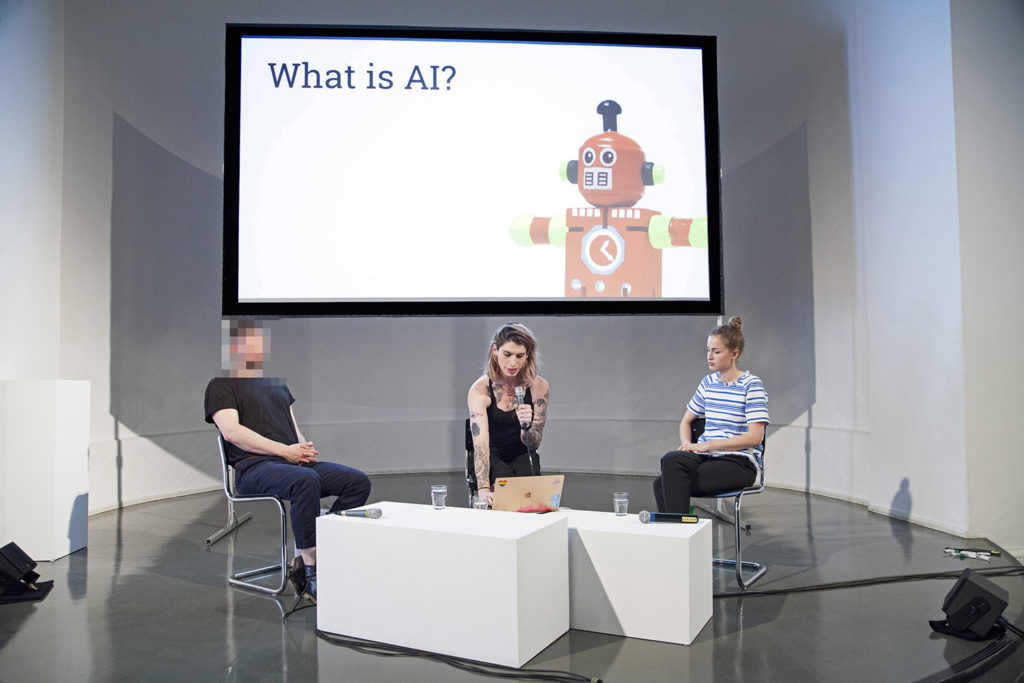
In order to have a closer look at the relation between governments and AI-tech, the researcher and writer Crofton Black presented the study conducted with Cansu Safak at The Bureau of Investigative Journalism on the UK government’s use of big data. They used publicly available data to build a picture of companies, services and projects in the area of AI and machine learning, to map what IT systems the British government has been buying. To do so they interviewed experts and academics, analysed official transparency data and scraped governmental websites. Transparency and accountability over the way in which public money is spent are a requirement for public administrations and they relied on this principle, filing dozens of requests under the Freedom of Information Act to public authorities to get audit trails. Thus they mapped an ecosystem of the corporate nexus between UK public sector and corporate entities. More than 1,800 IT companies, from big ones like BEA System and IBM to small ones within a constellation of start-ups.
As Black explained in the talk with the moderator of the keynote Daniel Eriksson, Transparency International Head of Technology, this investigation faced systemic problems with disclosure from authorities, that do not keep transparent and accessible records. Indeed just 25% of the UK-government departments provided some form of info. Therefore details of the assignments are still unknown, but it is at least possible to list the services those companies deploying AI and machine learning can offer governments: connect data and identify links between people, objects, locations; set up automated alerts in the context of border and immigration control, spotting out changes in data and events of interest; work on passports application programs, implementing the risk-based approaches to passports application assessments; work on identity verification services using smartphones, gathering real time biometric authentications. These are just few examples.
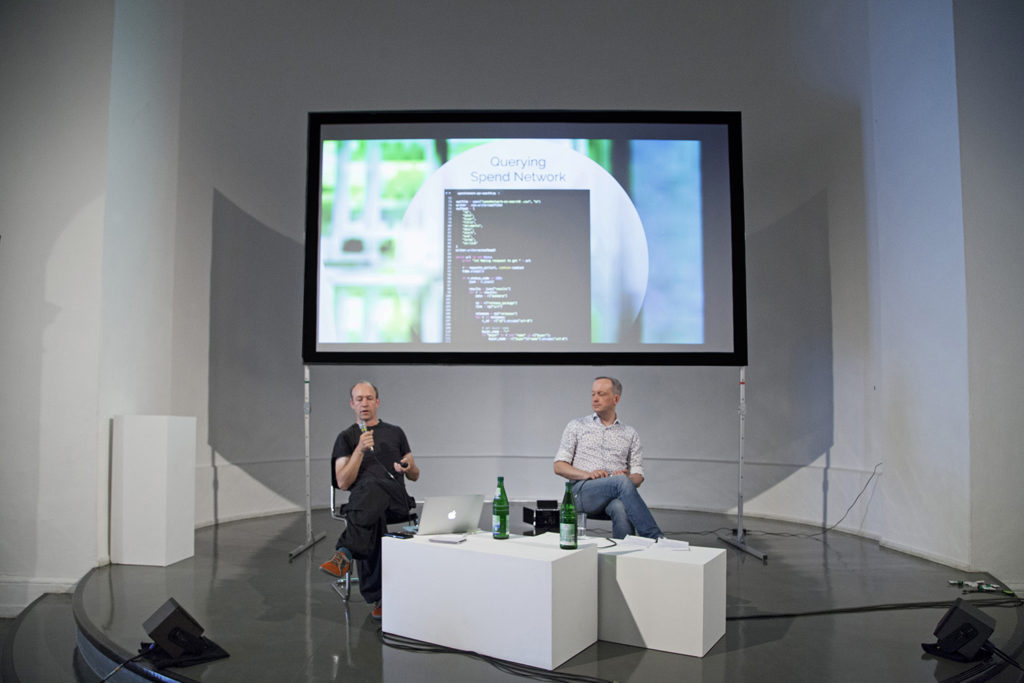
Maya Indira Ganesh opened the panel “AI FOR THE PEOPLE: AI Bias, Ethics & the Common Good” questioning how tech and research have historically been almost always developed and conducted on prejudiced parameters, falsifying results and distorting reality. For instance, data about women’s heart attacks hadn´t been taken in consideration for decades, until doctors and scientists determined that ECG-machines calibrated on the data collected from early ´60s could neither predict heart attacks in women, nor give reliable data for therapeutic purposes, because they were trained only on male population. Just from 2007 ECG-machines were recalibrated on parameters based on data collected from female individuals. It is not possible to calculate the impact this gender inequality had on the development of modern cardiovascular medicine and on the lives of millions of women.
As the issue of algorithmic bias in tech and specifically in AI grows, all big tech firms and research institutions are writing ethics charters and establishing ethics boards sponsoring research in these topics. Detractors often refer to it as ethics-washing, which Ganesh finds a trick to mask ethics and morality as something definable in universal terms or scale: though it cannot be computed by machines, corporations need us to believe that ethics is something measurable. The researcher suggested that in such a way the abstraction and the complexity of the machine get easy to process as ethics becomes the interface used to obfuscate what is going on inside the black box and represent its abstractions. “But these abstractions are us and our way to build relations” she objected.
Ganesh wonders consequently according to what principle it shall be acceptable to train a facial recognition system, basing it on video of transgender people, as it happened in the alarming “Robust transgender face recognition” research, based on data from people undergoing hormone replacement therapy, Youtube videos, diaries and time-lapse documentation of the transition process. The HRT Transgender Dataset used to train AI to recognize transgender people worsens the harassment and the targeting that trans-people already experience daily, targeting and harming them as a group. However, it was partly financed by FBI and US-Army, confirming that law enforcement and national security agencies appear to be very interested in these kinds of datasets and look for private companies and researchers able to provide it.
In this same panel professor of Data Science and Public Policy Slava Jankin reflected on how machine learning can be used for common good in the public sector. As it was objected during the discussion moderated by Nicole Shephard, Researcher on Gender, Technology and Politics of Data, the “common good” isn’t easy to define, and like ethics it is not universally given. It could be identified with those goods that are relevant to guarantee and determine the respect of human rights and their practice. The project that Jankin presented was developed inside the Essex Centre for Data analytics in a synergic effort of developers, researches, universities and local authorities. Together, they tried to build an AI able to predict within reliability where children lacking school readiness are more likely to be found geographically, to support them in their transition and gaining competencies, considering social, economic and environmental conditions.
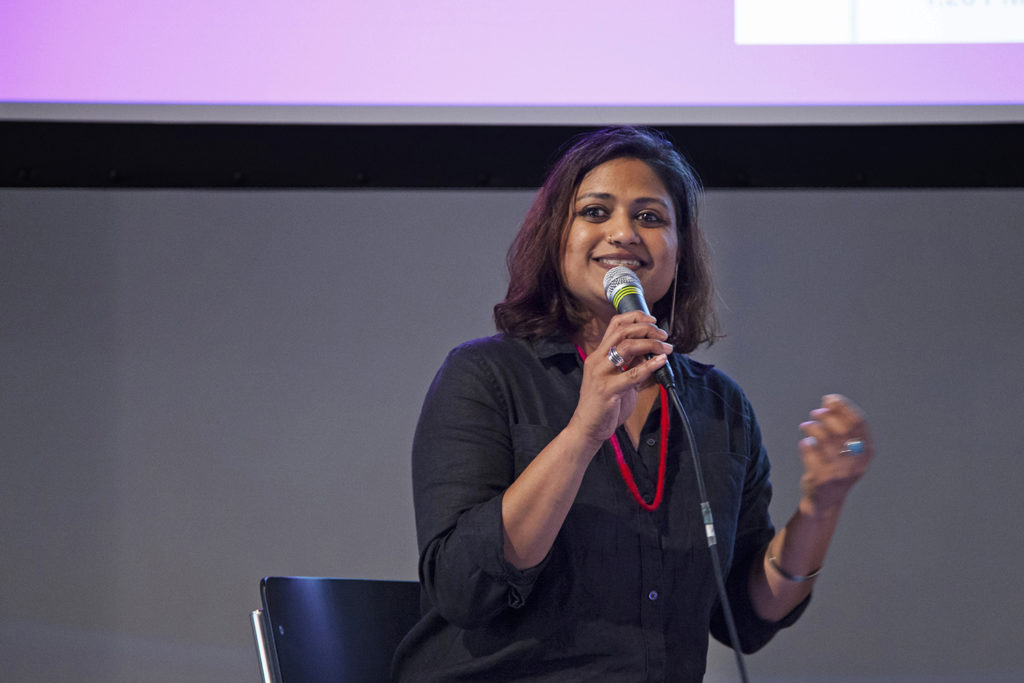
The first keynote of the conference was the researcher and activist Charlotte Webb, who presented her project Feminist Internet in the talk “WHAT IS A FEMINIST AI?”
<<There is not just one possible internet and there is not just one possible feminism, but only possible feminisms and possible internets>>. Starting from this assumption Webb talked about Feminist Human Computer Interaction, a discipline born to improve understandings about how gender identities and relations shape the design and use of interactive technologies. Her Feminist Internet is a no profit organisation funded to make internet a more equal space for women and other marginalized groups. Its approach combines art, design, critical thinking, creative technology development and feminism, seeking to build more responsible and bias-free AI able to empower people considering the causes of marginalization and discrimination. In her words, a feminist AI is not an algorithm and is not a system built to evangelize about a certain political or ideological cause. It is a tool that aims at recognizing differences without minimizing them for the sake of universality, meeting human needs with the awareness of the entire ecosystem in which it sits.
Tech adapts plastically to pre-existing discriminations and gender stereotypes. In a recent UN report, the ‘female’ obsequiousness and the servility expressed by digital assistants like Alexa, the Google Assistant, are defined as example of gender biases coded into tech products, since they are often projected as young women. They are programmed to be submissive and accept abuses. As stated by Feldman (2016) by encouraging consumers to understand the objects that serve them as women, technologists abet the prejudice by which women are considered objects. With her projects, Webb pushes to create alternatives that educate to shift this systemic problem – rather than complying with market demands – first considering that there is a diversity crisis in the AI sector and in the Silicon Valley. Between 2.5 and 4% of Google, Facebook and Microsoft employees are black, whilst there are no public data on transgender workers within these companies. Moreover, as Webb pointed out, just 22% of the people building AI right now are female, only 18% of authors at major AI-conferences are women, whilst over 80% of AI-professors are men. Considering companies with decisive impact on society women comprise only 15% of AI research staff at Facebook and 10% in Google.
Women, people of colour, minorities, LGBTQ and marginalized groups are substantially not deciding about designing and implementing AI and algorithms. They are excluded from the processes of coding and programming. As a result the work of engineers and designers is not inherently neutral and the automated systems that they build reflect their perspectives, preferences, priorities and eventually their bias.

Washington Tech Policy Advisor Mutale Nkonde focused on this issue in her keynote “RACIAL DISCRIMINATION IN THE AGE OF AI.” She opened her dissertation reporting that Google´s facial intelligence team is composed by 893 people, and just one is a black woman, an intern. Questions, answers and predictions in their technological work will always reflect a political and socioeconomic point of view, consciously or unconsciously. A lot of the tech-people confronted with this wide-ranging problem seem to undermine it, showing colour-blindness tendencies about what impacts their tech have on minorities and specifically black people. Historically credit scores are correlated with racist segregated neighbourhoods and risk analyses and predictive policing data are corrupted by racist prejudice, leading to biased data collection reinforcing privileges. Without a conscious effort to address racism in technology, new technologies will replicate old divisions and conflicts. By instituting policies like facial recognition we just replicate rooted behaviours based on racial lines and gender stereotypes mediated by algorithms. Nkonde warns that civil liberties need an update for the era of AI, advancing racial literacy in Tech.
In a talk with the moderator, the writer Rhianna Ilube, the keynote Nkonde recalled that in New York´s poor and black neighbourhood with historically high crime and violence rates, Brownsville, a private landlord in social housing wanted to exchange keys for facial recognition software, so that either people accept surveillance, or they lose their homes. The finding echoes wider concerns about the lack of awareness of racism. Nkonde thinks that white people must be able to cope with the inconvenience of talking about race, with the countervailing pressures and their lack of cultural preparation, or simply the risk to get it wrong. Acting ethically isn´t easy if you do not work on it and many big tech companies just like to crow about their diversity and inclusion efforts, disclosing diversity goals and offering courses that reduce bias. However, there is a high level of racial discrimination in tech sector and specifically in the Silicon Valley, at best colour-blindness – said Nkonde – since many believe that racial classification does not limit a person’s opportunities within the society, ignoring that there are instead economic and social obstacles that prevent full individual development and participation, limiting freedom and equality, excluding marginalized and disadvantaged groups from the political, economic, and social organization. Nkonde concluded her keynote stressing that we need to empower minorities, providing tools that allow overcoming autonomously socio-economic obstacles, to fully participate in society. It is about sharing power, taking in consideration the unconscious biases of people, for example starting from those designing the technology.
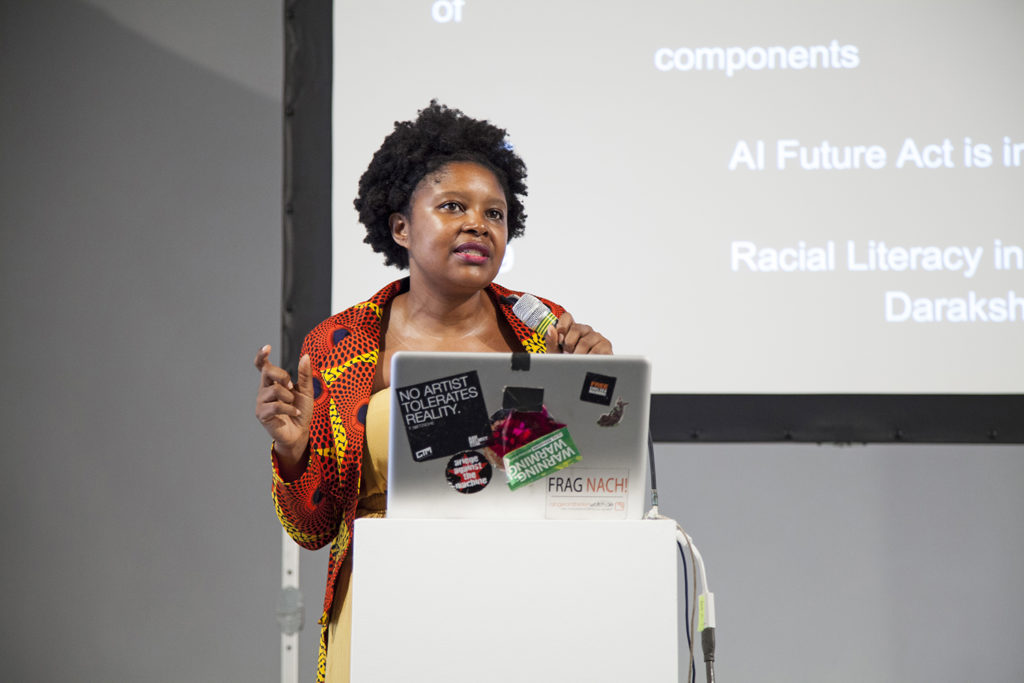
The closing panel “ON THE POLITICS OF AI: Fighting Injustice & Automatic Supremacism” discussed the effect of a tool shown to be not neutral, but just the product of the prevailing social economical model.
Dia Kayyali, Leader of the Tech and Advocacy program at WITNESS, described how AI is facilitating white supremacy, nationalism, racism and transphobia, recalling the dramatic case of the Rohingya persecution in Myanmar and the oppressive Chinese social score and surveillance systems. Pointing out critical aspects the researcher reported the case of the Youtube anti-extremism-algorithm, which removed thousands of videos documenting atrocities in Syria in an effort to purge hate speech and propaganda from its platform. The algorithm was trained to automatically flag and eliminate content that potentially breached its guidelines and ended up cancelling documents relevant to prosecute war crimes. Once again, the absence of the ability to contextualize leads to severe risks in the way machines operate and make decisions. Likewise, applying general parameters without considering specificities and the complex concept of identity, Facebook imposed in 2015 new policies and arbitrarily exposed drag queens, trans people and other users at risk, who were not using their legal names for safety and privacy reasons, including domestic violence and stalking.
Researcher on gender, tech and (counter) power Os Keyes considered that AI is not the problem, but the symptom. The problem are the structures creating AI. We live in an environment where few highly wealthy people and companies are ruling all. We have bias in AI and tech because their development is driven by exactly those same individuals. To fix AI we have to change requirements and expectations around it; we can fight to have AI based on explainability and transparency, but eventually if we strive to fix AI and do not look at the wider picture, in 10 years the same debate over another technology will arise. Keyes considered that since its very beginning AI-tech was discriminatory, racialized and gendered, because society is capitalist, racist, homo-transphobic and misogynistic. The question to pose is how we start building spaces that are prefigurative and constructed on values that we want a wider society to embrace.
As the funder and curator of the Disruption Network Lab Tatiana Bazzichelli pointed out during the moderation of this panel, the problem of bias in algorithms is related to several major “bias traps” that algorithm-based prediction systems fail to win. The fact that AI is political – not just because of the question of what is to be done with it, but because of the political tendencies of the technology itself – is the real aspect to discuss.
In his analysis of the political effects of AI, Dan McQuillan, Lecturer in Creative and Social Computing from the London University, underlined that while the reform of AI is endlessly discussed, there seems to be no attempt to seriously question whether we should be using it at all. We need to think collectively about ways out, learning from and with each other rather than relying on machine learning. Countering thoughtlessness of AI with practices of solidarity, self-management and collective care is what he suggests because bringing the perspective of marginalised groups at the core of AI practice, it is possible to build a new society within the old, based on social autonomy.
What McQuillan calls the AI realism appears to be close to the far-right perspective, as it trivialises complexity and naturalises inequalities. The character of learning through AI implicates indeed reductive simplifications, and simplifying social problems to matters of exclusion is the politics of populist and Fascist right. McQuillan suggests taking some guidance from the feminist and decolonial technology studies that have cast doubt on our ideas about objectivity and neutrality. An antifascist AI, he explains, shall involve some kinds of people’s councils, to put the perspective of marginalised groups at the core of AI practice and to transform machine learning into a form of critical pedagogy.
Pic 7: Dia Kayyali, Os Keyes, Dan McQuillan and Tatiana Bazzichelli during the panel “ON THE POLITICS OF AI: Fighting Injustice & Automatic Supremacism”
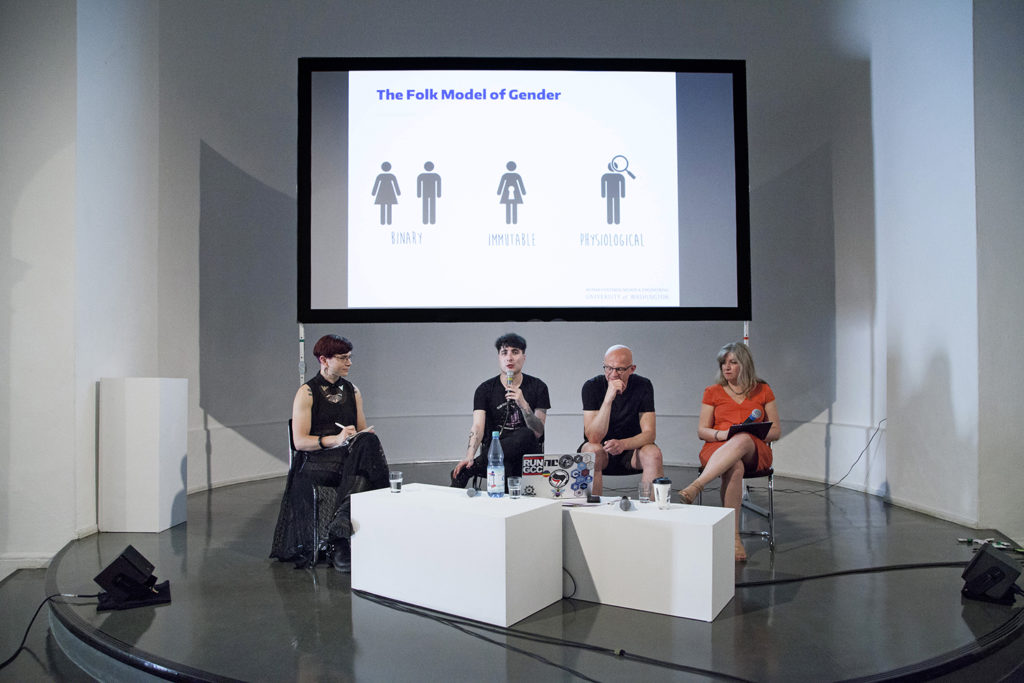
We see increasing investment on AI, machine learning and robots. Automated decision-making informed by algorithms is already a predominant reality, whose range of applications has broadened to almost all aspects of life. Current ethical debates about the consequences of automation focus on the rights of individuals and marginalized groups. However, algorithmic processes generate a collective impact too, that can only be addressed partially at the level of individual rights, as it is the result of a collective cultural legacy. A society that is soaked in racial and sexual discriminations will replicate them inside technology.
Moreover, when referring to surveillance technology and face recognition software, existing ethical and legal criteria appear to be ineffective and a lack of standards around their use and sharing just benefit its intrusive and discriminatory nature.
Whilst building alternatives we need to consider inclusion and diversity: If more brown and black people would be involved in the building and making of these systems, there would be less bias. But this is not enough. Automated systems are mostly trying to identify and predict risk, and risk is defined according to cultural parameters that reflect the historical, social and political milieu, to give answers able to fit a certain point of view and make decisions. What we are and where we are as a collective, what we have achieved and what we still lack culturally is what is put in software to make those same decisions in the future. In such a context a diverse team within a discriminatory conflictual society might find ways to flash the problem of bias away, but it will get somewhere else.
The truth is that automated discrimination, racism and sexism are integrated in tech-infrastructures. New generation of start-ups are fulfilling authoritarian needs, commercialising AI-technologies, automating biases based on skin colour and ethnicity, sexual orientation and identity. They develop censored search engine and platforms for authoritarian governments and dictators, refine high-tech military weapons training them using facial recognition on millions of people without their knowledge. Governments and corporations are developing technology in ways that threaten civil liberties and human rights. It is not hard to imagine the impact of the implementation of tools for robotic gender recognition, within countries were non-white, non-male and non-binary individuals are discriminated. Bathrooms and changing rooms that open just by AI gender-detection, or cars that start the engine just if a man is driving, are to be expected. Those not gender conforming, who do not fit traditional gender structures, will end up being systematically blocked and discriminated.
Open source, transparency and diversity alone will not defeat colour-blinded attitudes, reactionary backlashes, monopolies, other-directed homologation and cultural oppression by design. As it was discussed in the conference, using algorithms to label people based on sexual identity or ethnicity has become easy and common. If you build a technology able to catalogue people by ethnicity or sexual identity, someone will exploit it to repress genders or ethnicities, China shows.
In this sense, no better facial recognition is possible, no mass-surveillance tech is safe and attempts at building good tech will continue to fail. To tackle bias, discrimination and harm in AI we have to integrate research on and development of technology with all of the humanities and social sciences, deciding to consciously create a society where everybody could participate to the organisation of our common future.
Curated by Tatiana Bazzichelli and developed in cooperation with Transparency International, this Disruption Network Lab-conference was the second of the 2019 series The Art of Exposing Injustice.
More info, all its speakers and thematic could be found here: https://www.disruptionlab.org/ai-traps
The videos of the conference are on Youtube and the Disruption Network Lab is also on Twitter and Facebook.
To follow the Disruption Network Lab sign up for its Newsletter and get informed about its conferences, ongoing researches and projects. The next Disruption Network Lab event “Citizen of evidence” is planned for September 20-21 in Kunstquartier Bethanien Berlin. Make sure you don´t miss it!
Photocredits: Maria Silvano for Disruption Network Lab
This family-friendly ‘Albion’ style fair for Finsbury Park’s 150th anniversary forms part of our 3-year programme Citizen Sci-Fi – crowdsourcing creative and technological visions of our communities and public spaces, together.
Music, storytelling, costumes, food, and all kinds of activities for exploring the future of the park and beyond!
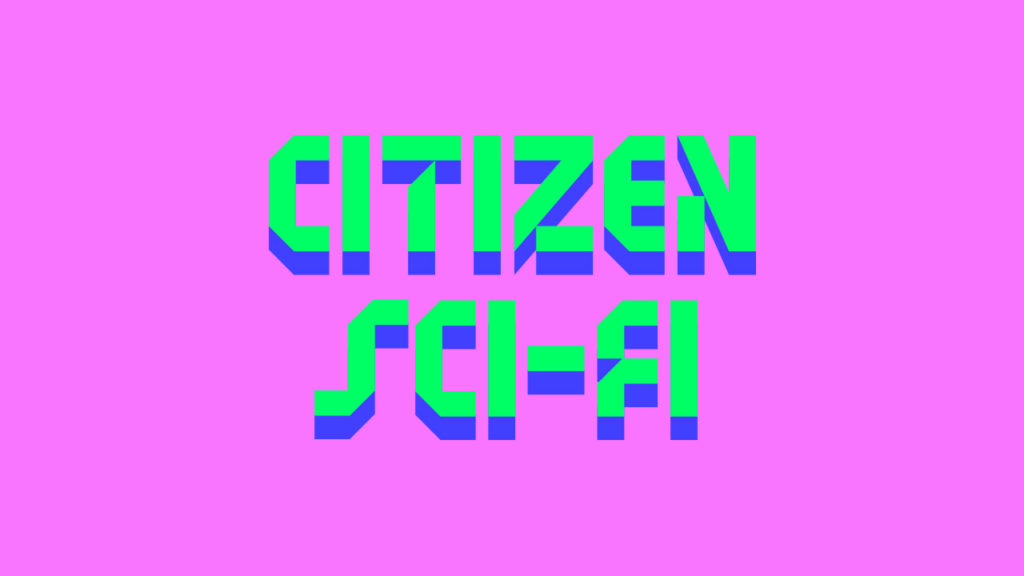
Activities Include:
Martin Zeilinger
Should a cashless society leave us quaking in our boots? Come play our game imagining the future of money – and how we’ll get by if there’s no cash to pay for things. You’ll get given a scenario and asked to design a way to make exchanges in the future. Are you a ‘Barter Bender’ or ‘Sharey Carey’? Or will you sink the system and start again? Find out!
Times: 10.00-5.00

Mud Howard and Stephen Oram
Gather round and listen to two short stories emerging from the heady mix of sci-fi authors, scientists and the folk of Finsbury Park. Come and decide if these are the futures you want for your park?
Times: 11.30, 2.30
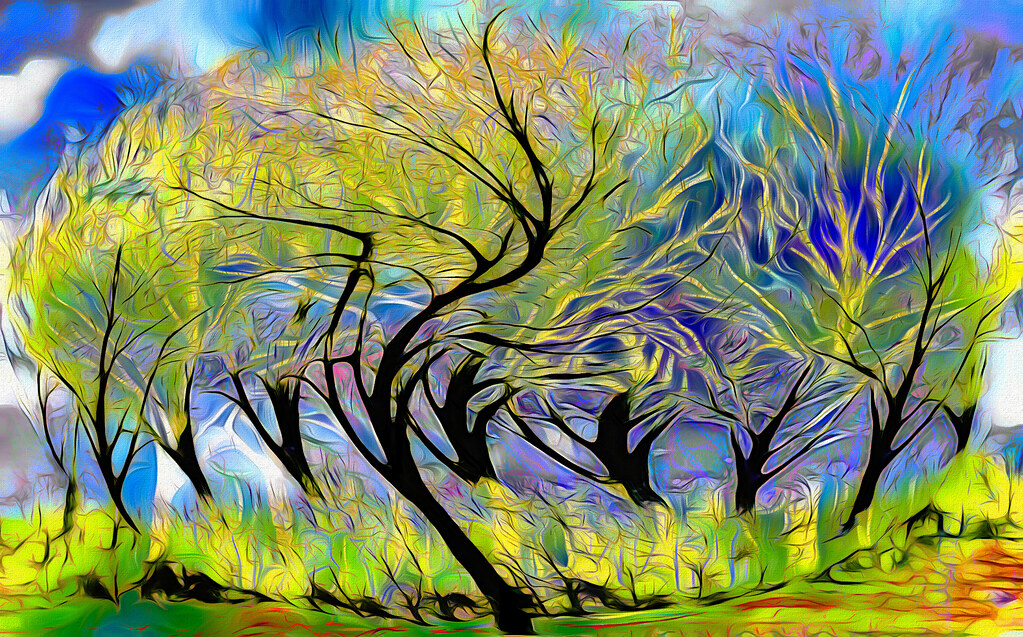
Idit Nathan and Helen Stratford
Take part in the launch of an entirely new app that leads you on a walk of the park that’s like no park walk you’ve ever been on before! This app was designed with local people through similarly silly strolls and we need YOU to bring it to life! Drop by and we’ll show you how to download the app (it’s very easy!) and collect a map that will help you ‘catch’ prompts all around the park. We’ll also have colourful badges for you to take home.
Times: 10.00-5.00
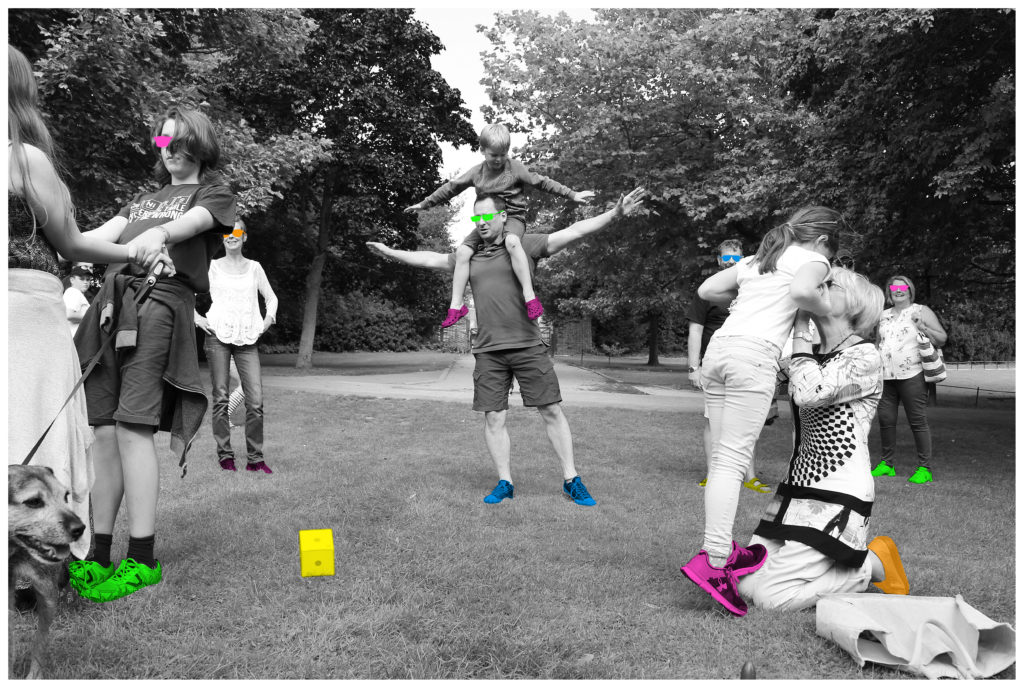
Jason Wilsher-Mills
Pedal Power, come meet Jason and the Argonauts – a set of wild and wacky AR-enabled characters who have come to visit you. Jason will show you how he made them and how you can help him make new ones all about the Pedal Power community. (this activity is especially for Pedal Power, but all welcome)
Times: 10.00-5.00
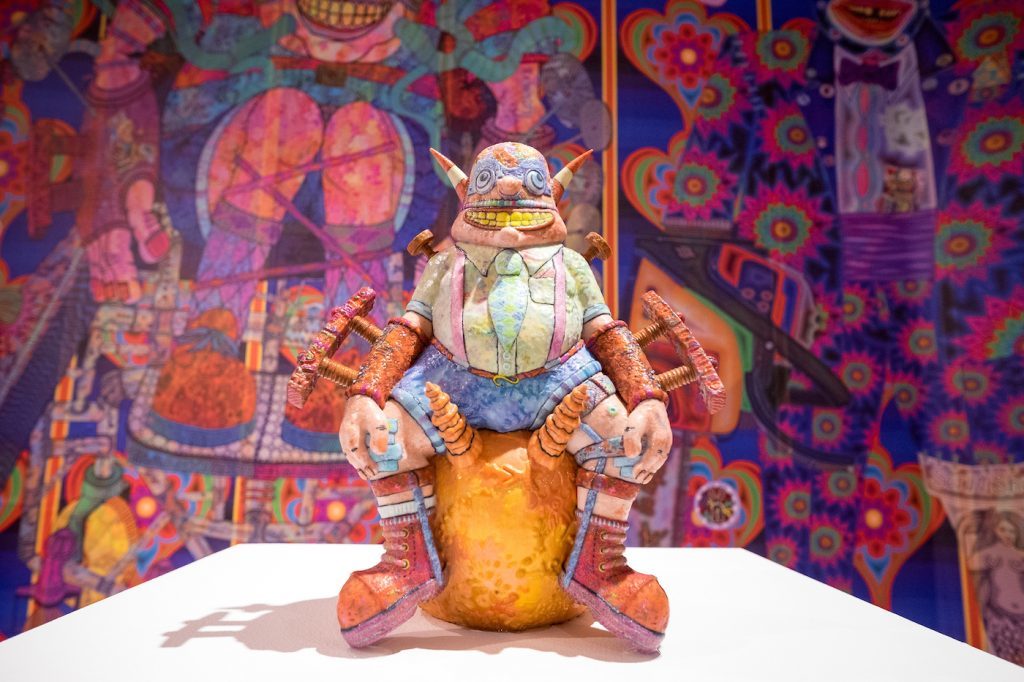
Alex Dayo
Drop by and join in a family-friendly Community Drumming workshop led by Alex Dayo, master drummer from Burkina Faso (West Africa), find your inner rhythm and let it out!
Times: 10.30, 4.00
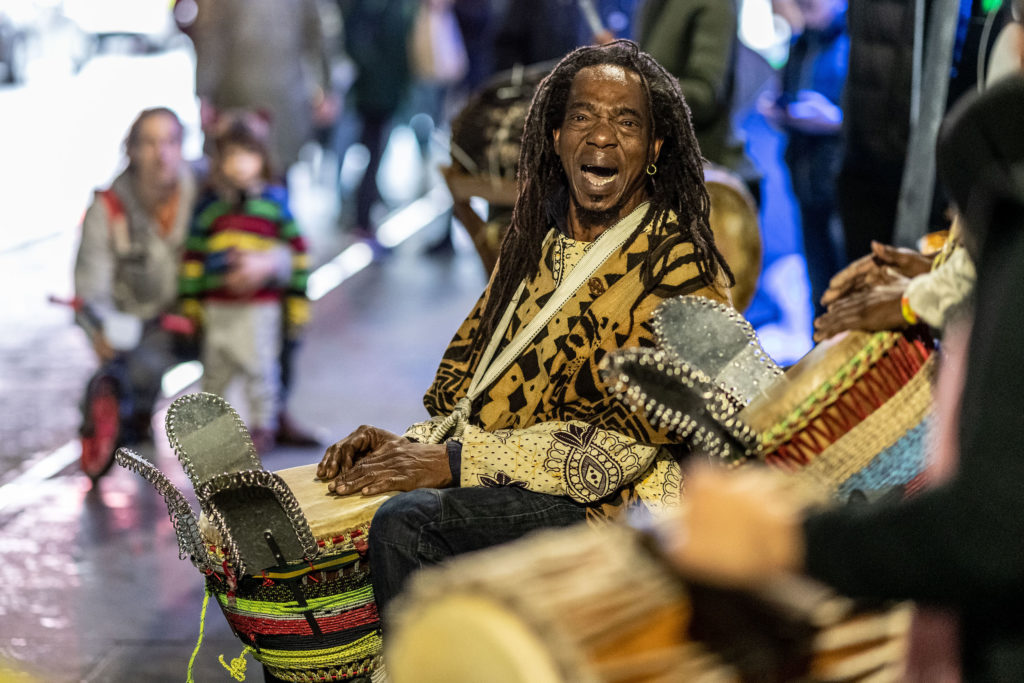
Possible Bodies: The Underground Division – Helen Pritchard, Jara Rocha, Femke Snelting
Join a research session with Possible Bodies: The Underground Division, a team of fiction writers, geo-techno-scientists and trans*feminist device problematizers. A hands-on collective investigation into the micro, meso and macro political consequences of earth scanning practices. Together we’ll look at what undergrounds are rendered when using techniques such as Terrestrial Light Detection and Ranging, magnetic resonance, UltraSound, and Computer Tomography.
Times: All day but limited places, book now

Feminist Internet
What have parks done for their communities? What role do they play in our lives both socially and politically? What kind of spaces could they be for us in the future? Feminist Internet launch a special episode of their podcast series and an accompanying zine for the Albion fair that unearths the history of Finsbury Park, examining the role urban parks play within their communities and speculates about their potential futures.
Times: 10.00-5.00
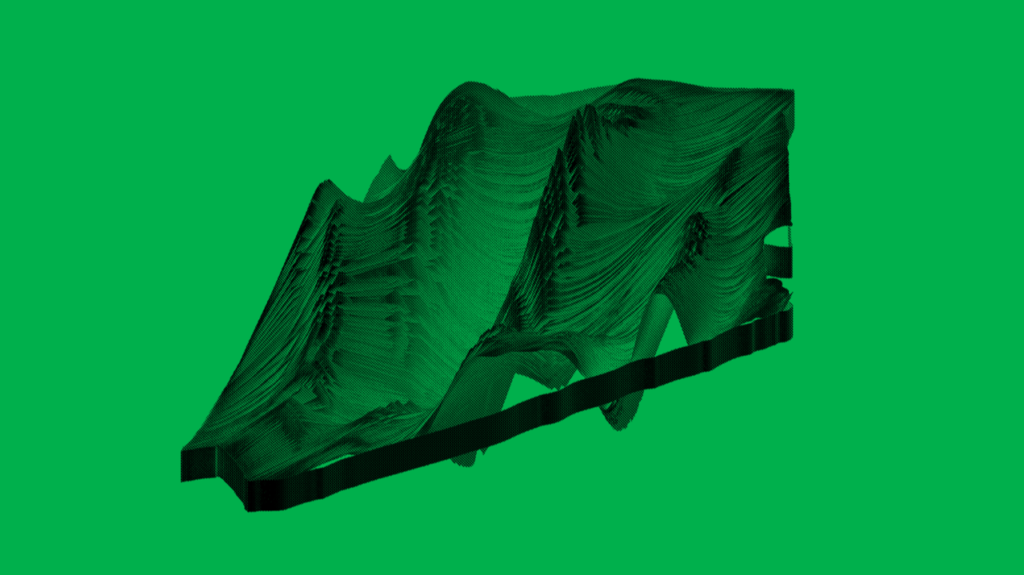
Larisa Blazic
It’s time to call this meeting to order! Join a special Theatre of the Oppressed inspired performance by reading aloud meeting minutes published by Finsbury Park’s many organisations and community hubs.
Times: 12.00-2.30
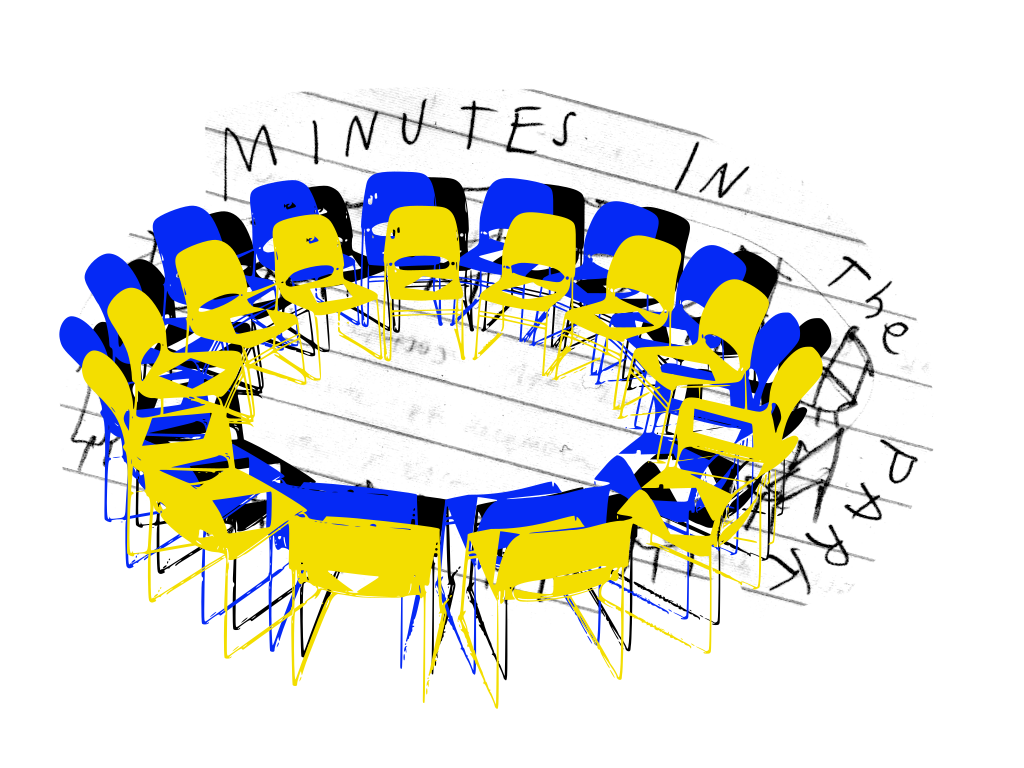
Sunara Begum
The ‘Who Am I?’ workshop is about reversing technology and reflecting on history through creativity. Design and create your own special crest and emblem to signify who you are. Investigate the world of sound through percussion-led music making and immerse yourself in the art of expression through movement. The workshop looks at understanding who we are, tapping into our inner self, asking questions, seeking answers and sharing personal and collective journeys.
Times: 10.00-5.00
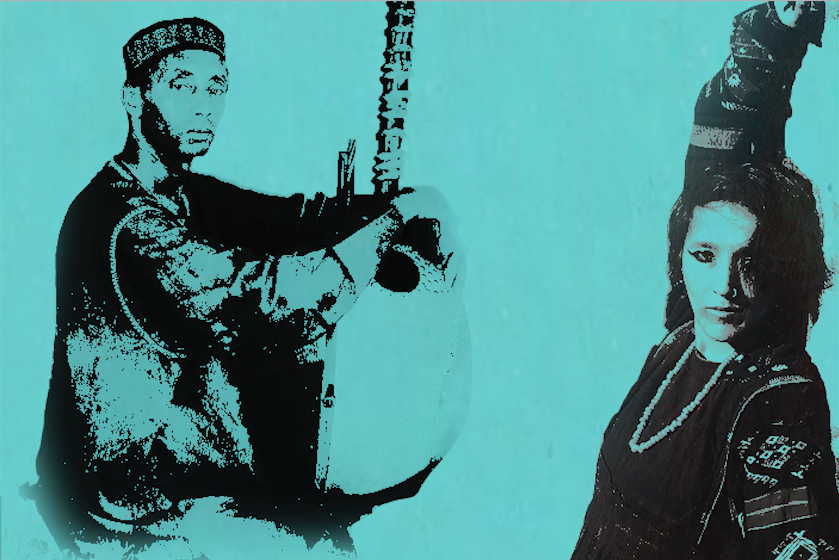
Artist: Alistair Gentry. Curators: Hannah Redler Hawes and Julie Freeman.
Just how trusting are you? Meet the hot-pink puppet-robot who wants to tell you all about your life online! How much will you reveal and how much does the trustbot know already?
Times: 10.00-11.30, 12.00-2.00, 3.00-5.00
This work was produced as part of an ODI R&D project funded by Innovate UK.

Rachel Jacobs
How will you dress fancy for the Future Machine? Rachel Jacobs needs your help to create a stylish parade for the unveiling of the Future Machine this autumn. What will you wear?
Times: 10.00-5.00
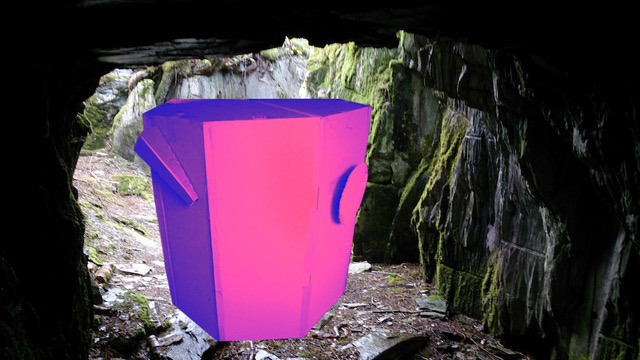
They Are Here
There will be a vegetarian and Halal barbeque on the go, with servings inspired by recipes from the refugees They Are Here have been collaborating with. Food will be offered in exchange for a sketch reimagining the transformation of the garden, this will inform the changes taking place in the Autumn.
Times: DJ 12.00-4.30. BBQ 1.00-4.30
Kathryn Davis, Dhelia Snoussi and Zey Kussan, Museum of London
What might future archaeologist say about us in the park? How right (or wrong!) could they be? Discover the left objects found in park through the Everything project, and see what connections you can make to you, the park and 2019.
Times: 11.00-1.00
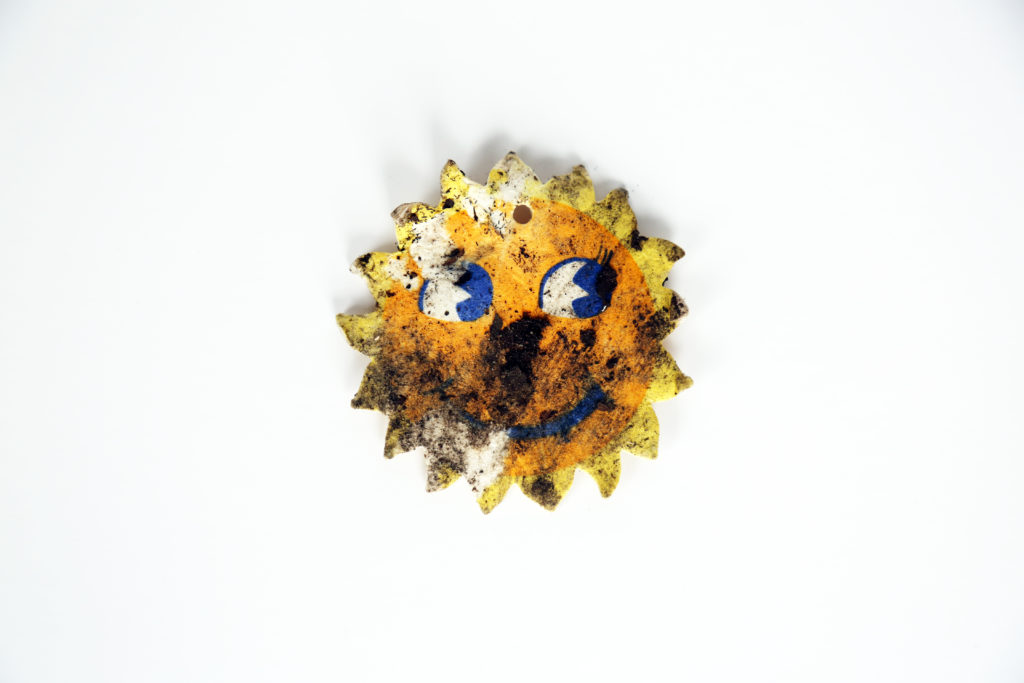
Andrew Smith, Goran Vodicka
Come and map your experiences of Finsbury Park and feed into research about urban parks and festivals.
Times: 10.00-5.00
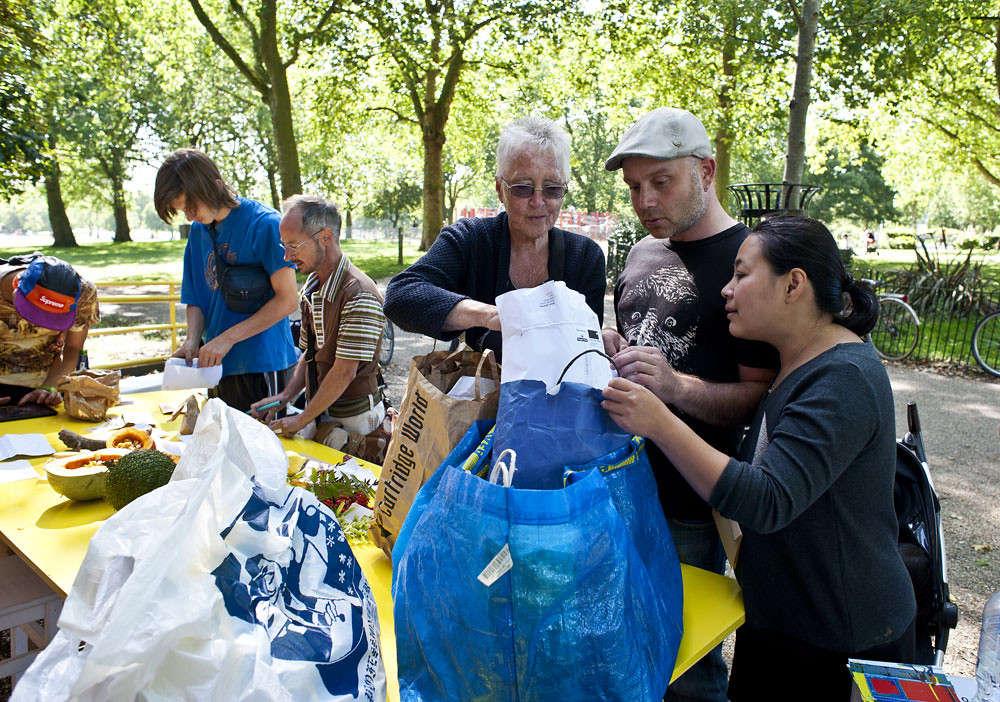
Featured image: Image by Studio Hyte, artwork in image by Jason Wilsher-Mills
Alex Dayo
Alex Dayo is a versatile composer, arranger and musician (he primarily plays percussion instruments), who was born in Burkina Faso, West Africa. Alex recalls growing up to the sound of drumbeats all around him – music has been part of his everyday life from birth, with instruments replacing childhood toys. His professional musical career started in the 1980s, accompanying the National Ballet Kouledafourou on tour as well as playing for African Royalty and globally-recognised dignitaries at private and public events and the Ensemble des Radios and Televisions of Burkina Faso, based in Bobo-Dioulasso. In 1985, Alex founded Fusion band Wountey, and, for fifteen years, toured with his band and the Ballet across Africa and Europe, spreading Burkina Faso’s cultural fusion to a wider audience. His musical collaborations include Ali Farka Toure, Femi Kuti and Salif Keita from Africa and traditional Master Griots from Burkina Faso/Mali/Guinea/Gambia. An accomplished arranger, Alex modifies his style according to the need, incorporating African traditional, Fusion, Jazz, Rock, Latin and Caribbean influences. A highlight of Alex’s career was being chosen to play at the Opening and Closing ceremonies at the London 2012 Olympics. As well as gaining British community music teaching qualifications, Alex developed his teaching skills working throughout Europe (Switzerland, Italy, Germany, Austria, Luxembourg, Belgium, France and Holland) and Africa and has played at numerous festivals and events, including Notting Hill and Hackney Carnivals, where he has performed for the past ten years.
Alistair Gentry
Alistair Gentry is a science fiction artist. He likes silly costumes, museums, absurdity, visiting the uncanny valley, the Oxford comma, and making machines do things their manufacturers wouldn’t approve of. DoxBox trustbot was developed during his embedded research residency at The Open Data Institute. Other recent projects include an imaginary tourist information agency and a technological ritual with televisions and credit card shredders.
Andrew Smith
Andrew Smith is a Reader in the School of Architecture and Cities at the University of Westminster. His background is in urban geography and one of his main research interests is the significance of organised events in post-industrial and entrepreneurial cities.
Goran Vodicka is a Research Fellow in the School of Architecture and Cities at the University of Westminster. He is an architect/urbanist and his research is broadly focused on diversity and inclusion in public spaces.
Feminist Internet
Feminist Internet is a group of artists and designers working to advance online and offline equalities for women and other marginalised groups through creative and critical practice.
Hannah Redler Hawes
Hannah is the director of the Data as Culture art programme at the ODI and an idneoendent curator. She specialises in art and technology, art and science and emerging artistic practice with an interest in participatory process. She develops interdisciplinary projects for galleries, museums, digital space and non-art contexts. Alongside her work with ODI she curates exhibitions, events and art interventions. Past projects have been with Science Gallery London, Tate Modern, Natural History Museum, FACT Liverpool, the Digital Catapult and the Institute of Physics. As an artist, Julie’s focus is the investigation of data as an art material, using it to create work that reflects the human condition through the analysis and representation of data. As a computer scientist and artist, Julie oftens works collaboratively and experimentally with scientists. Her work has been shown widely in the UK and internationally, and she has won awards from the Wellcome Trust, the Arts Council and Nesta. She holds a PhD in Media & Arts Technology from QMUL and is the founder of the Data as Culture art programme at the ODI.
http://culture.theodi.org/about/
Helen Stratford and Idit Nathan
Helen Stratford and Idit Nathan – Working collaboratively as Play Anywhere Now or Never! and combining backgrounds in theatre and architecture, Idit and Helen have worked in partnership with Wysing Arts Centre, Kettles Yard, Cambridge and METAL and in locations across the UK (Bristol, Sunderland, Peterborough, Southend and London). In 2015 they formulated Play The City Now or Never! (PCNN) working with METAL Peterborough and Southend to develop the PCNN App, a site-specific geo-locative App for mobile devices positioned at the intersection of art, play and technology. The PCNN App, like other low-tech resources they have developed, such as a compilation of games and scores as well as DIY die, solicits playful engagement with spaces and sites. Other recent and ongoing collaborative projects include developing a mobile artwork for Yorkshire Sculpture Park as well as walkshops for Cambridge Junction, Festival of Ideas Cambridge, CounterPlay ’16 Aarhus, Wellcome Trust, Live Art Development Agency and the National Theatre.
www.playanywherenowornever.com
Jason Wilsher-Mills
Jason Wilsher-Mills is a disabled digital artist who is based in the East Midlands, using iPads to create paintings which detail his disability, childhood memories, popular culture, social history/heritage, creating new biographical narratives, through theatrical artifice and humour. He initially painted traditionally, with oils, but since becoming disabled has found the iPad screen more manageable – affording him the opportunity to create large pieces of artwork, through high-resolution files, modern Giclée printing methods & projection methods. It has also given him the chance to work collaboratively, due to its connectivity and accessibility. The primary themes of his work include memory, childhood, disability and illness. In parallel to his own artistic practice Wilsher-Mills conducts public art commissions and residencies working primarily with learning disabled collaborators on wild and wacky interactive sculptures.
Larisa Blazic
Larisa Blazic is a London based digital artisan, educator and feminist hacker with practice ranging from net.art to FLOSS art and design. In her most recent work, Data Union Fork, part of Vertigo STARTS Residency, she explores collective response to personal data abuses by state and corporate sector and creates experiments based on technologies developed within the DECODE project and investigates local governance in Local&&Ledger project.
Martin Zeilinger
Martin Zeilinger is a London-based interdisciplinary researcher, curator, and media practitioner. Currently he works as Senior Lecturer in Media at Anglia Ruskin University (Cambridge/UK), and also serves as curator of the Vector Festival (Toronto/CAN). His research interests include digital art, appropriation-based art practices, experimental uses of financial technologies in contemporary art, theories of cultural ownership and intellectual property, political economies of new media, live coding and creative computing, videogame culture, and experimental game art.
Mud Howard
Mud Howard (they/them) is a gender non-conforming poet, performer and activist from the states. mud creates work that explores the intimacy and isolation between queer and trans bodies. mud is a Pushcart Prize nominee. they are currently working on their first full-length novel: a queer and trans memoir full of lies and magic. they were the first annual youth writing fellow for Transfaith in the summer of 2017. their poem “clearing” was selected by Eduardo C. Corral for Sundress Publication’s the Best of the Net 2017. mud is a graduate of the low-res MFA Poetry Program at the IPRC in Portland, OR and holds a Masters in Creative Writing from the University of Westminster. you can find their work in THEM, The Lifted Brow, Foglifter, and Cleaver Magazine. they spend a lot of time scheming both how to survive and not perpetuate toxic masculinity. they love to lip sync, show up to the dance party early and paint their mustache turquoise and gold.
Possible Bodies – Femke Snelting
Femke Snelting works as artist and designer, developing undisciplined research at the intersection of feminisms and free software. In various constellations she explores how digital tools and cultural practices might co-construct each other. She is member of Constant, a non-profit, artist-run association for art and media based in Brussels.
www.snelting.domainepublic.net
Possible Bodies – Helen Pritchard
Helen Pritchard is an artist and researcher, whose interdisciplinary work brings together the fields of Computational Aesthetics, Geography and Feminist TechnoScience. Helen’s practice is both one of writing and making and these two modes mutually inform each other in order to consider the impact of computational practices on our engagement with environments. Helen is the head of Digital Art and a lecturer in Computational Art at Goldsmiths, University of London.
Possible Bodies – Jara Rocha
Jara Rocha is an independent researcher/mediator who tends to attend to the semiotic-material urgencies of present cultures with a trans*feminist sensibility. Works with infrastructural politics and aesthetics, text logistics, body inscriptions and tests non-formal ways of learning in collective situations like Euraca Seminar, Las promesas de los algos, Relearn Summerschool, or The Darmstadt Delegation.
Rachel Jacobs
Rachel Jacobs is an artist, researcher and games designer. She co-founded the artist-led collective Active Ingredient in 1996 and the commercial games company Mudlark Production Company in 2007. She completed a Doctorate in Computer Science in 2014. Rachel is a practising artist exhibiting nationally and internationally, and a Research Associate at the Horizon Digital Economy Institute, University of Nottingham. Her artworks include the award winning ‘Heartlands (Ere Be Dragons)’ one of the first mobile games that took place on city streets in Sao Paulo, Yokhama, Berlin, Paris, Cambridge, Bristol and Nottingham; ‘A Conversation Between Trees’, a touring artwork and schools exchange using environmental sensors to connect forests in the UK and Brazil; and ‘The Prediction Machine’, an interactive installation that predicts the future impacted by climate change. Rachel is currently developing a series of artists interventions ‘Creating Rituals for When The Future Comes’, alongside a mobile interactive artwork the ‘Future Machine’.
Stephen Oram
Stephen Oram writes thought provoking stories that mix science fiction with social comment, mainly in a recognisable near-future. He is one of the writers for SciFutures and, as 2016 Author in Residence at Virtual Futures – described by the Guardian as “the Glastonbury of cyberculture” – he was one of the masterminds behind the new Near-Future Fiction series and continues to be a lead curator. Oram is a member of the Clockhouse London Writers and a member of the Alliance of Independent Authors. He has two published novels: Fluence and Quantum Confessions, and a collection of sci-fi shorts, Eating Robots and Other Stories. As the Author in Residence for Virtual Futures Salons he wrote stories on the new and exciting worlds of neurostimulation, bionic prosthetics and bio-art. These Salons bring together artists, philosophers, cultural theorists, technologists and fiction writers to consider the future of humanity and technology. Recently, his focus has been on collaborating with experts to understand the work that’s going on in neuroscience, artificial intelligence and deep machine learning. From this Oram writes short pieces of near-future science fiction as thought experiments and use them as a starting point for discussion between himself, scientists and the public. Oram is always interested in creating and contributing to debate about potential futures.
Sunara Begum
Originally from Bangladesh, Sunara Begum studied film and fine art in the UK and Yoga and Ayurveda in India. She lives between London and Lagos where she is the co-founder of several international arts initiatives including Chand Aftara, an artist’s collective dedicated to the exhibition and production of experimental cinema, New Horizons Africa, an annual music and arts festival and Living Legacies, Gambia’s first traditional music archive. Begum’s work has been widely exhibited in film festivals, museums, galleries and cinematheques worldwide. In 2017, her film Meditation on Stillness was selected as the Best Experimental Short at the Art Africa Film Festival and the Jury Grand Prize at the 21st Media City Film Festival. Her films are in the permanent collections of Dimbola Museum & Galleries (UK), Lionel Wendt Gallery (Sri Lanka), Centre for Contemporary Art (Nigeria), Drik Gallery (Bangladesh) as well as Central Saint Martins College of Art & Design. Sunara’s work is a highly personal expression of themes including gender, memory and migration with powerful imagery that evokes deep-rooted feelings of reflection, contemplation and stillness. Sunara has developed a visual language that is distinctly her own drawn from her unique lived experience, straddling the dialectics of east and west, cultural identity, femininity and the immutable polarities of displacement.
They Are Here
They Are Here (f. 2006) is a collaborative practice steered by Helen Walker and Harun Morrison. They are currently based in London and on the River Lea. Their work can be read as a series of context specific games. The entry, invitation or participation can be as significant as the game’s conditions and structure. Through these games, they seek to create ephemeral systems and temporary, micro-communities that offer an alternate means of engaging with a situation, history or ideology. In parallel, they initiate multiyear socially engaged projects that become generative spaces for further works. They Are Here work across media and types of site, particularly civic spaces.
Museum of London
Curating London will change how the museum collects 21st century London. It also seeks to recruit staff from a broader range of backgrounds and professional experience and puts Londoners at the heart of our collecting practice by working in partnership with local communities. From physical objects to interviewing Londoners about their own histories and memories, Curating London will capture, collect and record contemporary London.
The project started in April 2018 and runs until March 2022.
Each year the museum will begin four projects: three area studies of particular areas and one themed study that spans the whole of London.
https://www.museumoflondon.org.uk/discover/curating-london-collecting-community-contemporary-city
A list of Furtherfield recommendations, reflecting the dynamic culture we are part of, straddling the fields of art, technology and social change.
Events & Exhibitions
Paloma Polo: The earth of the Revolution | Arts Catalyst | Thu 11 July 2019 – Sat 3 August 2019 | The second phase in the Towards the Planetary Commons exhibition programme will see artist Paloma Polo’s The earth of the Revolution (2019) premiered for the first time. Emerging from Polo’s research in the Philippines, cultivated over three years, and during which time the artist located herself at the heart of the ongoing democratic struggles in the region – a struggle in which marginalised countryside communities are actively fighting for democratic and progressive transformations, emancipation and the common good – this new work offers viewers a glimpse into the political practices that underlie the revolution – http://tiny.cc/gaofaz
Algorave | Herbert Art Gallery & Museum, Coventry, UK| 16 August 2019 | Organised by Antonio Roberts | An evening of futuristic electronic rhythms, brought to you by some of the leading lights of the Algorave movement. Experience the exciting and unpredictable phenomenon of algorithms brought to life as music and visuals. Featuring Maria Witek, Innocent, Rosa Francesca and Carol Breen. Tickets only £5! Book here – http://tiny.cc/d2nfaz
Europa Endlos | In collaboration with CPH:DOX | 21 mar – 11 aug 2019 | In 2019 Kunsthal Charlottenborg puts Europe and the EU on the agenda with a group exhibition presented in collaboration with CPH:DOX, one of the world’s most important documentary film festivals | The exhibition presents installation, sculpture, film and photography by the international artists Monica Bonvicini (1965, Italy), Jeremy Deller (1966, Great Britain), Daniil Galkin (1985, Ukraine), Sara Jordenö (1974, Sweden), Šejla Kamerić (1976, Bosnia-Hercegovina), Bouchra Khalili (1975, Morocco), and some older exponents such as Jimmie Durham (1940, USA), the artist duo Fischli Weiss with Peter Fischli (1952, Switzerland) and David Weiss (1946 – 2012, Switzerland) as well as the pioneers Olafur Eliasson (1967, Iceland/Denmark) and Wolfgang Tillmans (1968, Germany). All the selected art works deal with current topics regarding Europe today and EU’s role in the future, some with an activist approach, others in a more documentary style – http://tiny.cc/q2kfaz
At the 58th International Art Exhibition – La Biennale di Venezia, the Danish-Palestinian artist Larissa Sansour presents Heirloom, an otherworldly rumination on memory, history and identity. Comprising of a two-channel science-fiction film, a sculptural installation and an architectural intervention, the exhibition invites the viewer into a dark universe. “The film, entitled ‘In Vitro’, is staged in the town of Bethlehem decades after an eco-disaster. The dying founder of a subterranean orchard is engaged in a dialogue with her young successor, who is born underground and has never seen the town she’s destined to replant and repopulate. Inherited trauma, exile and collective memory are central themes.” – https://www.danishpavilion.org/
Trying out divinatory strategies for Making | Hosted by Access Space, Heffield | 6-9.30, Friday 2nd August | Access Space Artist in Residence, Hestia Peppe, is holding a residency event and all are welcome. Hestia is a doctoral candidate at Sheffield Hallam University. Her research concerns divinatory methodologies for arts practice. Book on FB – http://tiny.cc/6gqfaz
Faith Ringgold exhibition at Serpentine Galleries | London, United Kingdom, 6 Jun 2019 – 8 Sep 2019 | Focusing on different series that she has created over the past 50 years, this Serpentine survey will include paintings, story quilts, tankas and political posters. It will be the first solo exhibition of Ringgold’s work in a European public institution – http://tiny.cc/9ckfaz
Books
This is Not Propaganda: Adventures in the War Against | By Peter Pomerantsev | ‘The world’s most powerful people are lying like never before, and no one understands the art of their lies like Peter Pomerantsev.’ Oliver Bullough, author of Moneyland: The Inside Story of the Crooks and Kleptocrats Who Rule the World. As Pomerantsev seeks to make sense of the disinformation age, he meets Twitter revolutionaries and pop-up populists, ‘behavioural change’ salesmen, Jihadi fan-boys, Identitarians, truth cops, and much more. Forty years after his dissident parents were pursued by the KGB, he finds the Kremlin re-emerging as a great propaganda power. His research takes him back to Russia – but the answers he finds there are surprising – http://tiny.cc/lopfaz
Cult of the Dead Cow: How the Original Hacking Supergroup Might Just Save the World | by Joseph Menn | The shocking untold story of the elite secret society of hackers fighting to protect our privacy, our freedom — even democracy itself Cult of the Dead Cow is the tale of the oldest, most respected, and most famous American hacking group of all time. Though until now it has remained mostly anonymous, its members invented the concept of hacktivism, released the top tool for testing password security […] Today, the group and its followers are battling electoral misinformation, making personal data safer, and battling to keep technology a force for good instead of for surveillance and oppression. Cult of the Dead Cow shows how governments, corporations, and criminals came to hold immense power over individuals and how we can fight back against them – http://tiny.cc/07ofaz
Nationalism on the Internet: Critical Theory and Ideology in the Age of Social Media and Fake News | By Christian Fuchs | In this timely book, critical theorist Christian Fuchs asks: What is nationalism and what is the role of social media in the communication of nationalist ideology? Advancing an applied Marxist theory of nationalism, Fuchs explores nationalist discourse in the world of contemporary digital capitalism that is shaped by social media, big data, fake news, targeted advertising, bots, algorithmic politics, and a high-speed online attention economy – http://tiny.cc/dujfaz
Articles & Interviews
Nonument symposium part 2: How artists deal with old monuments that polarize opinions | By Regine Debatty | Second part of an overview of the Nonument Symposium dedicated to hidden, abandoned and forgotten monuments of the 20th century which took place last June at CAMP, Prague’s Centre for Architecture and Metropolitan Planning. http://tiny.cc/zyhfaz
Digital design and time on device; how aesthetic experience can help to illuminate the psychological impact of living in a digital culture | By Vanessa Bartlett | Aesthetic techniques are increasingly used by marketeers to create enticing digital products. In this paper, I work with the aesthetic experiences of one audience group to consider the psychological impact of living in a culture where digital devices are deliberately designed to influence behaviour. I argue that aesthetic encounters can help with understanding the impact of the interplay between visual stimulus, affect and digital culture, in ways that may support situated understandings of mental distress in a digital age. I show how audiences respond to the artist-led research project (and exhibition) Are We All Addicts Now? – http://tiny.cc/9gjfaz
Downloads preparations for two talks on PDF | By artist Annie, Abraham’s | The first #PEAE (Participatif Ethology in Artificial Environments) is about her relation to electronic literature and struggles defining artworks. In the second Diffractive Reading in the Reading Club, Abraham’s describes how she became to consider the Reading Club as an example of a diffractive reading practice – https://aabrahams.wordpress.com/2019/07/29/elocork/
“Inter Alia: Aliens and AI” 2019 | By Rita Raley and Russell Samolsky. The premise of this paper is that the disquieting sense that AI possesses, or is possessed of, an external intelligence, one that operates autonomously, unpredictably, and, in our deepest fears, mutinously, is projectively displaced onto extra-planetary aliens. Our paper offers an analysis of Trevor Paglen’s satellite work, The Last Pictures, as well as Eduardo Kac’s Inner Telescope and Lagoogleglyph series. We conclude with a speculative imagining of an AI-archaeologist encountering in the distant future the orbital ring of dead satellites, one of which contains Paglen’s curated image archive. Free PDF Download here – https://escholarship.org/uc/item/8453532n
Daniel Rourke via Twitter, offers three decolonising reading lists, made by others, he has saved over the years (big thanks to Daniel):
Human, Social, and Political Sciences Tripos (2018-2019) at Cambridge | What follows is a general list of important decolonial texts, a brief history of decolonization of HSPS at Cambridge, some advice on how to tackle the course, and most importantly, a set of decolonial reading lists for POL1, POL2, SOC1, and SAN1 based on the 2018-2019 reading lists. Compiled by recent graduates and current students, the lists aim to provide a set of critical perspectives with which incoming first year students can re-situate the canonical (“set”) – http://tiny.cc/9hifaz
Decolonizing technology: A reading list | By Beatrice Martini | Western culture has long been defining how the world came to existence, its history, and how it works from a perspective which is centred on a Western and white point of view. While this specific paradigm has been the dominant position of power, others have been hegemonized by it, their cultures and experiences dismissed and excluded – http://tiny.cc/trifaz
Decolonising Science Reading List: It’s The End of Science As You Know It | By Chanda Prescod-Weinstein | You’ll find texts that range from personal testimony to Indigenous cosmology to anthropology, to history to sociology to education research. All are key to the process of decolonising science, which is a pedagogical, cultural, and intellectual set of interlocking structures, ideas, and practices. This reading list functions on the premise that there is value in considering the ways in which science and society co-construct. It is stuff that I have read all or part of and saw some value in sharing with others – http://tiny.cc/q4ifaz
Extra Squeezed (Jobs other opportunities & extra stuff)
Art+Feminism has recently become a 501(c)3 non-profit, and is hiring an Executive Director to help further the vision we’ve developed over the past six years. FT, with salary range 60-75k. Job description below. Application review will begin immediately. Apply by the August 13th deadline for full consideration. Please post widely and forward the description onto anyone you think would be interested in the role: http://www.artandfeminism.org/executive-director/
Main image from – Daniil Galkin, Tourniqet, 2013. Šejla Kamerić, EU / Others, 2000. Installation view, Europa Endlos, Kunsthal Charlottenborg, 2019. Photo by Anders Sune Berg.
A list of Furtherfield recommendations, reflecting the dynamic culture we are part of, straddling the fields of art, technology and social change.
Kiss My Genders | A group exhibition at the Hayward Gallery celebrating more than 30 international artists whose work explores and engages with gender fluidity, as well as non-binary, trans and intersex identities | features works from the late 1960s and early 1970s through to the present moment, and focuses on artists who draw on their own experiences to create content and forms that challenge accepted or stable definitions of gender | 12 Jun 2019 – 8 Sep 2019 – https://tinyurl.com/y3txhcl7
Rafael Lozano-Hemmer’s Atmospheric Memory opens this Saturday for its World Premiere at MIF19, 6-21 July | An array of ‘Atmospheric Machines’ mine the air for turbulence caused by speech, then transform it into trails of vapour, ripples on water, epic 360-degree projections. These artworks are presented alongside a section of a Babbage Analytical Engine, a rare object in the prehistory of computing from the Science Museum Group’s collection – https://tinyurl.com/yxt2kk6c
Event Two | An exhibition by the Computer Arts Society and FLUX Events in collaboration with the Royal College of Art, the Electronic Visualisation and the Arts conference (EVA), Interact Digital Arts and Lumen Art Projects. Featuring talks by Lumen Art Projects and FLUX Events. 12th – 17th July 2019 Royal College of Art, Kensington Campus, London – https://tinyurl.com/yxd379g9
Peripheries: Electronic literature and new media art | A week-long exhibition of cutting-edge expression in electronic literature and media art as part of University College Cork’s hosting of the internationalElectronic Literature Organization conference and festival in Cork. Featuring artists: Betül Aksu, Graham Allen, John F. Barber & Greg Philbrook, Natasha Boškić / Mohamad Kebbewar / Mary McDonald, Mez Breeze & Andy Campbell, Richard A. Carter, John Cayley & Joanna Howard, Qianxun Chen, Hilda Daniel, Tina Escaja, Brenda Grell, Chris Hales, Brian James, Alinta Krauth, Paul O’Neill, Sabrina Rubakovic, Anastasia Salter, Colm Scully, Lyle Skains, Joel Swanson, Daniel Temkin, Pip Thornton, Theadora Walsh, Marcelina Wellmer | 11 – 17 July 2019 – https://tinyurl.com/yyvd8trc
Birth Rites Collection Summer School | A unique 5-day programme of lectures, workshops and exchange. It is generated through engaging directly with the artworks in the collection which are installed across the historic Guy’s campus, King’s College London, and hosted by the Department of Midwifery. If you are a midwife, academic, artist, medic, health professional, art historian or policy advisor, you will arrive on the course with your skill set and leave with a bespoke multi-media pack of visual, textual, auditory and filmic material, to be used thereafter in your own future work | 15-19th July 2019 Guy’s Campus, Kings College London, UK – https://tinyurl.com/y32cfbkq
A Strange Weave of Time and Space | Exhibition at Site Gallery | Sheffield UK, 12 Jul 2019 – 28 Jul 2019 | An exhibition and research project exploring notions of aura and authenticity in the post-digital context | The works selected circle the complex relations between the auratic, (Walter Benjamin’s term for the authentic, original artefact, singular in space and time) and the technologically reproduced, dispersed and viewed art object prevalent in the current post-digital period. Including moving image, sculpture, drawing, audio and 3D printed objects. Curated by Jeanine Griffin. https://tinyurl.com/y5cnncfv
Vector Festival 2019 Toronto, July 11-14, 2019 | InterAccess is thrilled to announce the theme of Vector Festival 2019, Speculative Ecologies: Media Art at the Anthropocenic Precipice. Curated by Katie Micak and Martin Zeilinger, this year’s festival explores the ways in which contemporary media art reflects—and reflects on—mass-scale environmental shifts. The 2019 festival program will include works by over 30 local and international artists in more than 8 locations across Toronto and online – http://vectorfestival.org/
Radical Networks Deadline Extended | A conference that celebrates a free and open internet, with hands-on workshops, speakers, and a gallery exhibiting artworks centered around radio and networking technology. What: We invite anyone interested in presenting a workshop, lunchtime meetup, talk, panel, performance or film screening, tour / field trips or artwork to be exhibited | The deadline for submitting your proposal is now July 9, 2019 – https://radicalnetworks.org/
Symposium: “The sculptural in the (post-) digital age” | 1 July 2020 (Central Institute for Art History, Munich) | Submission deadline: 21 July 2019 | A number of theoretical approaches discuss the implications of so-called ‘Aesthetics of the Digital’, referring above all to screen-based phenomena. Art history, however, continues to pay little attention to sculptural works that are conceived and ‘materialized’ using digital technologies – https://tinyurl.com/yyomlbxa
UFO-Urban Flying Opera Swarms of Painting Drones | Following the success of write&erase robot Scribit, CRA unveils the world’s first crowdsourced graffiti, designed by thousands of people and painted by a swarm of drones in the city of Torino, Italy. The UFO-Urban Flying Opera project is promoted by Compagnia di San Paolo, ideated and curated by CRA, and coordinated and produced by Fondazione LINKS, in collaboration with Tsuru Robotics | Visited Youtube Video – https://tinyurl.com/y6y7almm
Digital Conversations: Celebrating Ten Years of the New Media Writing Prize | As part of their Digital Conversations series and the season of events accompanying the Library’s Writing: Making Your Mark exhibition, in partnership with Bournemouth University, if:book uk, and sponsored by the Eccles Centre for American Studies at the British Library; they are celebrating ten years of the New Media Writing Prize, by hosting a panel consisting of writers, Christine Wilks, Kayt Lackie and Amira Hanafi, on Thursday 18 July in the British Library Knowledge Centre – https://tinyurl.com/y574l5a5
Rage Inside the Machine: The Prejudice of Algorithms, and How to Stop the Internet Making Bigots of Us All | By Robert Elliott Smith | Having worked in the field of artificial intelligence for over 30 years, Smith reveals the mounting evidence that the mechanical actors in our lives do indeed have, or at least express, morals: they’re just not the morals of the progressive modern society that we imagined we were moving towards. Instead, as we are just beginning to see – in the US elections and Brexit to name but a few – there are increasing incidences of machine bigotry, greed and the crass manipulation of our basest instincts – Bloomsbury Business (27 Jun. 2019) – https://tinyurl.com/y5oct3xg
Insurgent Empire: Anticolonial Resistance and British Dissent | By Priyamvada Gopal | Insurgent Empire shows how Britain’s enslaved and colonial subjects were not merely victims of empire and subsequent beneficiaries of its crises of conscience but also agents whose resistance both contributed to their own liberation and shaped British ideas about freedom and who could be free. This book examines dissent over the question of empire in Britain and shows how it was influenced by rebellions and resistance in the colonies from the West Indies and East Africa to Egypt and India. It also shows how a pivotal role in fomenting dissent was played by anti-colonial campaigners based in London at the heart of the empire. Publisher: Verso Books 2019 – https://tinyurl.com/y579t24y
Vital Forms: Biological Art, Architecture, and the Dependencies of Life | By Jennifer Johung | Shows how the intersection of biotech, art, and architecture are transforming the world we live in. Examining cutting-edge developments in biotechnological research—including tissue-engineering, stem cell science, regenerative medicine, and more—Vital Forms brings biological art and architecture into critical dialogue | The University of Minnesota Press 2019 – https://bit.ly/2KK5nCl
Harriet Bart: Abracadabra and Other Forms of Protection | A comprehensive look at the prolific and dynamic career of this international feminist conceptual artist. The book, which accompanies the first retrospective exhibition of her work at the Weisman Art Museum in 2020, features poetry and prose contributions by significant writers, artists, and curators who have been influenced by her art. Laura Wertheim Joseph, Editor. Foreword by Lyndel King 2019 | University of Minnesota Press – https://tinyurl.com/y4edoy7q
Ledger – Human Centric Values Technology Enterprises, Youtube video | LedgerProject VentureBuilder | The Builder Programme LEDGER chose the 16 most human-centric and innovative projects among a pool of 291 applicants. LEDGER, a European Commission funded project looking for people working on decentralized technologies to give back citizens control over their data, held its Jury Day on Tuesday 28 May in Amsterdam | A must watch for those who to build better relations with technology, community & the climate – https://tinyurl.com/y6eduxbf
Situationism Now – Understanding Guy Debord in a Contemporary Political Context | by Caitríona Devery, 2017 Should we still be reading Guy Debord or encouraging others to read him politically for the first time in a contemporary context? In popular culture parlance, Debord’s name will always be associated with the political moment of May ’68, the general strike and the student riots which spread from the campus of Nanterre (led by philosophy and sociology lecturers Jean Francois Lyotard and Henri Lefebvre) – http://politicalscience.ie/?p=1065
Rec, Barcelona’s social currency – Description / Objectives | Barcelona Digital City | Economic resource to create a citizen exchange system that is complementary or equal to the euro | This social currency acts as a complementary form of payment, but does not replace the national currency. It gives us the opportunity to measure the impact of consumption on the city. It is estimated that 5,000 people are now using one of the 70 social currencies in Spain – https://tinyurl.com/y2y8oh8t
Augmented Reality Art Commission, NEoN Digital Arts Festival: REACT | Deadline for submissions: 31 July 2019, For exhibition beginning: 4 November 2019 | Artist Fee £2000 (inclusive of research and production costs and any licensing fees) From 4 – 10 November 2019 the NEoN Digital Arts Festival in Dundee, Scotland will be focused on the theme “REACT”, exploring how artists use digital systems to effect change within our social and political realities. We are now seeking proposals for a commissioned project utilising AR and mobile technologies inspired by NEoN’s theme – https://tinyurl.com/y5n6kote
Image by John.F.Barber and Greg Philbrook, Sound Spheres, still 2018 web based interactive installation. Exhibited at Peripheries: Electronic literature and new media art 2019.S
A list of Furtherfield recommendations, reflecting the dynamic culture we are part of, straddling the fields of art, technology and social change.
Events & Exhibitions
POSTCENTRAL | Group show | NOME is pleased to present POSTCENTRAL, a group show curated by Navine G. Khan-Dossos, featuring works by Zach Blas, Jesse Darling, Marjolijn Dijkman, Antye Guenther, Lynn Hershman Leeson, Kirsten Stolle, Addie Wagenknecht, and Xiyadie | The work of the artists assembled in POSTCENTRAL touches on the question of where “the body” can be found and where it might be heading, with a focus on non-naturalist ideas of women’s and queer bodies as spaces of futurity and potential. As Donna Haraway foretold in 1985, the exhibition stands “for pleasure in the confusion of boundaries and for responsibility in their construction | June 22 – July 26, 2019 – https://bit.ly/2Iu7r01
Satellite Devotion, a new installation by Tabita Rezaire | Hosted by arebyte 2 July – 24 August 2019 | The Center for Moon Studies and Practices is an ever-evolving anchor for Moon knowledge to understand and experience the vastness of her influence and nourish our relationship with the Earth’s sole* natural satellite. In a quest to share Moon wisdoms across time and space, a 12 video-channel dome presents a constellation of Moon teachings from astrophysics to cosmology, astrology, agriculture, healing, history, magic, meditation, theology and spatial politics – https://bit.ly/2Zom8Y2
Toggler | A new website feature allowing commissioned artists to explore, demonstrate and celebrate the potential of creativity in website design. As websites become increasingly standardised to ensure familiarity and ease of use for online visitors, Toggler allows artists to champion the role of curiosity and creativity in exploring other possibilities for presenting content online. The first artists commissioned are Luke Harby, Violet Forest, Sam Francis Read, Antonio Roberts and Tobias Zehntner – https://bit.ly/2KWzTJB
New Writings: Re-Enter the Dragon with Stewart Home | The artist and cult author discusses his new book, with a look at the cinematic copy-cats of Bruce Lee and the Sleazy Joys of Lowbrow Cinema. Brucesploitation films riff on tropes associated with Bruce Lee, sometimes using actors who copy and clone the phenomenally successful kung-fu master’s name or look. Home will talk through the finer points of this sprawling sub-genre as he joins BFI curator William Fowler in conversation | Reuben Library at Bfi Southbank, SE1 8 London, UK – https://bit.ly/2ZxVmMM
AI TRAPS Meetup: Reshape the future – Revealing & transforming algorithmic inequality | Part of the DNL Activation programme | Following up on their upcoming Disruption Network Lab conference ‘AI Traps: Automating Discrimination’, with a closer look at how AI & algorithms reinforce prejudices and biases of its human creators and societies, in this meetup we focus on possible strategies for exposing and transforming algorithmic inequality | Wednesday 26 June, 19:00 at STATE Studio, Hauptstr 3, 10827 Berlin (U7 Kleistpark) – Entrance is free – https://bit.ly/2KpgOjB
High Weirdness: with Erik Davis, Jeremy Gilbert and Debra Shaw | Hosted by Culture, Power, Politics and 2 others | Since the 1990s, Erik Davis has been charting the multiple interfaces between consciousness-expansion, technological trickery, drug cultures and social change | Erik’s new book High Weirdness: Drugs, Esoterica and Visionary Experience in the Seventies is a study of the spiritual provocations to be found in the work of Philip K. Dick, Terence McKenna, and Robert Anton Wilson. High Weirdness charts the emergence of a new psychedelic spirituality that arose from the American counterculture of the 1970s – https://bit.ly/2ZDTORD
Platform Parasite: A Personal Voyage by Cosmos Carl | Hosted by Banner Repeater and Cosmos Carl – Platform Parasite | Platform Parasite: A Personal Voyage is a pilot episode of a new series by Cosmos Carl commissioned by Banner Repeater. Platform Parasite: A Personal Voyage includes contributions from Snorri Ásmundsson, Gnax Type, Art+Feminism, Alex Frost, Kate Mackeson, Angels Miralda, Joseph Ridgeon, Jorik Amit Galama, Emilia Bergmark, NX Panther, Harry Meadley, Styrmir Örn Guðmundsson, Laura Yuile featured on the parasitical online art platform Cosmos Carl. Opening: 26th April 6.30-9pm, exh: 26th April – 29th June – https://www.bannerrepeater.org/
Books
Vital Forms: Biological Art, Architecture, and the Dependencies of Life | By Jennifer Johung | Shows how the intersection of biotech, art, and architecture are transforming the world we live in. Examining cutting-edge developments in biotechnological research—including tissue-engineering, stem cell science, regenerative medicine, and more—Vital Forms brings biological art and architecture into critical dialogue | The University of Minnesota Press 2019 – https://bit.ly/2KK5nCl
Articles & interviews
The Bank of Facebook | By Rachel O’ Dwyer | A response to Facebook’s announcement that it’s releasing a digital currency and wallet | Marshall McLuhan argued that money is communication. This rings particularly true at a time when so many platforms are entering the payments space | Institute of Network Cultures Wed, 19 Jun 2019 – https://bit.ly/2x6KKs0
Regine Debatty reviews Digital Cash. The Unknown History of the Anarchists, Utopians and Technologists Who Created Cryptocurrency, by Finn Brunton, assistant professor in the Department of Media, Culture, and Communication at New York University. Brunton reveals how technological utopians & political radicals created experimental money to bring about their visions of the future: protecting privacy or bringing down governments, preparing for apocalypse or immortality – https://bit.ly/2MSqC7I
An AI Completes an Unfinished Composition 115 Years After Composers Death | By Suchi Rudra | It’s never too late to finish what you’ve started, even if AI does the job for you | This November, the Prague Philharmonic will perform the third and final movement of “From the Future World,” an AI-completed composition based on an unfinished piano piece by the famous composer Antonín Dvořák, 115 years after his death. Emmanuel Villaume will conduct – https://bit.ly/2XWnTva
How Ethical Is Facial Recognition Technology? By Yaroslav Kuflinski | In this article, we’ll explore the issues that surround facial recognition in depth and look at how these technologies can be made safer for everyone. Photo by Steinar Engeland on Unsplash The Potential of Facial Recognition Technology – https://bit.ly/2MNQAsX
What Happens When a US Border Protection Contractor Gets Hacked? The government wants all the data it can get from you at the border. But what happens when a hacker shows they can’t store it safely? A hacker known as “Boris the bullet dodger” hacked a license plate reader company called Perceptics. Now, less than a month later, CBP issued a statement confirming a data breach at one of its contractors – https://bit.ly/2Fhu1Xs
Environment reporters facing harassment and murder, study finds | By Juliette Garside and Jonathan Watts | Tally of deaths makes it one of most dangerous fields for journalists after war reporting | Thirteen journalists who were investigating damage to the environment have been killed in recent years and many more are suffering violence, harassment, intimidation and lawsuits, according to a study – https://bit.ly/2IOWMMa
Extra Squeezed
Superflux are looking for a freelance visual / graphic designer (print + digital) to come on board and work with them on a 🔥 worldbuilding project. Drop them a line with portfolios👇🏼⚡️📢 || Designers and strategic thinkers, researchers and artists; exploring, imagining and prototyping different possible futures – hello@superflux.in
Two Fully Funded PhD Scholarships to Study the Geographies of Homelessness, Veganism, Unschooling, or Heavy Metal Music at the University of Newcastle, in Australia. Two Domestic (Australia) or one International PhD scholarships will be awarded to study at the Centre for Urban and Regional Studies under the direction of Professor Simon Springer in the Discipline of Geography and Environmental Studies – https://bit.ly/2In3ZnK
Image from Satellite Devotion, a new installation by Tabita Rezaire at arebyte gallery | Opening Tuesday 2 July – 24 August 2019.
A weekly list of Furtherfield recommendations that we are sharing with others. It reflects the expansive and dynamic culture we enjoy, straddling the fields of art, technology and social change.
Events & Exhibitions
Solo show H4ppy D33p W3b (Happy Deep Web) by Systaime aka Michael Borras, at Watermans Arts centre, London. Systaime is the creator of The French Trash Touch movement, which mixes low and high culture and pop culture with internet folklore, like memes, emojis or GIFs. He offers an explosive mashup of internet aesthetics, where information, images and comments are remixed in an audiovisual spectacle that exposes the language of the internet | 12 June – 28 July 2019 – https://bit.ly/2KfGQWy
Antiuniversity Festival is back 15 Jun – 22 Jun 2019, for the fifth time with events across the UK and internationally. This year’s programme is absolutely bursting with radical education, militant feminism, anarchist tendencies, autonomous organising, shit hot politics, critical analysis and progressive discussions about care and culture and gender and class | Full programme – http://www.antiuniversity.org/
Aaron Bastani in conversation with Dr. Richard Barbrook on his new book ‘Fully Automated Luxury Communism: A Manifesto‘ 2019. This event is hosted by Newspeak House, the London College of Political Technologists. Tue, 25 June 2019 | Virtual Futures partners with Verso Books | Book here – https://bit.ly/31p7Xnv
Take the Money and Run: Power, Money and Counter-Power | Wednesday 19 June, 19.00 – 21.00 | The light recently shone on the sources of money that supports arts organisations – from fossil fuels to deadly pharmaceuticals – has illuminated some corners of the ‘hidden abode of production” (Marx) to valuable effect. Live Art Development Agency (LADA), London | Book here – https://bit.ly/2WBGkUk
West Den Haag – Summer School 2019 Spinoza: Passionate Action | Human Being is a Measure | With: Ewa Majewska (PL), Florence Freitag (DE) , Baruch Gottlieb (CA) and Cassie Thornton (US). In order to keep the discussions and experiences substantive and immersive, this Summer School is limited to 30 participants. There is a fee of € 175 per participant, which includes lunches as well as a reader. The program will be held in English. To apply, please e-mail theo@westdenhaag.nl before 26 June 2018 with a short introduction and a 100-word motivation. If successful, you will receive a confirmation of registration and instructions for payment within the week – https://bit.ly/2IHDg4l
About all things languages of all sorts | lingagens an online ReadingClub ***** session. Duration 20 min | Lai-TzeFan, Abdulmohsen Alonayq, Sören Pold and Andréa Catrópa will rearite a text originally written by Erika Fülöp. June 20, 8:15pm (UTC+01:00) – https://bit.ly/2WktGsM
Books
Vital Forms: Biological Art, Architecture, and the Dependencies of Life | By Jennifer Johung | Shows how the intersection of biotech, art, and architecture are transforming the world we live in. Examining cutting-edge developments in biotechnological research—including tissue-engineering, stem cell science, regenerative medicine, and more—Vital Forms brings biological art and architecture into critical dialogue | The University of Minnesota Press 2019 – https://bit.ly/2KK5nCl
Archives | Authors – Andrew Lison, Marcell Mars, Tomislav Medak, Rick Prelinger, Wendy Hui Kyong Chun, Götz Bachmann, Mercedes Bunz, and Timon Beyes | How digital networks and services bring the issues of archives out of the realm of institutions and into the lives of everyday users. Archives have become a nexus in the wake of the digital turn—electronic files, search engines, video sites, and media player libraries make the concepts of “archival” and “retrieval” practically synonymous with the experience of interconnected computing – The University of Minnesota Press, 2019 – https://bit.ly/2WBWjli
Fucking Law: The search for her sexual ethics | By Victoria Brooks | An urgent call for everyone, not just academics and researchers, to find inventive ways to question the ethics of sexuality. Since a sex life is full of so many diverse moments of joy and suffering, for each and everybody, the book attempts to bridge a gap between philosophical and non-philosophical questioning | Zero Books, 2019 – https://bit.ly/31CMxDs
Articles & interviews
Gadgets, Power and the New Modes of Political Consciousness | By Joss Hands | What impact does our relentless fixation on gadgets have on the struggle for new kinds of solidarity, political articulation and intelligence? Joss Hands, author of Gadget Consciousness: Collective Thought, Will and Action in the Age of Social Media, explores the new political and social forces that are emerging in the age of social media – https://bit.ly/2KJp4Kx
Physical Tactics for Digital Colonialism | Video documentation of artist Morehshin Allahyari and her performance-lecture from February 28th 2019. Commissioned and co-presented by New Museum affiliate Rhizome, presenting her concept of digital colonialism in relation to the technologies of 3-D scanning and 3-D printing. https://vimeo.com/337394969
Allahyari also talks to Hrag Vartanian via Hyperallergic on the subjects of ownership of data, forgotten stories, issues surrounding digital colonialism and her scifi project on a podcast – https://bit.ly/2ZnBJa3
The Data Sublime | Giles Lane, writes about his experience at Act Otherwise as a participant at Blast Theory’s annual two day seminar, ‘Act Otherwise – The Invisible Hand: On Profiling and Personalisation.’ He dscusses issues around the generation and use of “Big Data” in artworks and by artists as well as more generally in culture and society – https://bit.ly/2IbjTS3
Forgiven Not Forgotten? A long and detailed challenge to the modern cult of memory | Book review by Christopher Hale on History Today, of ‘Reckonings: Legacies of Nazi Persecution and the Quest for Justice’ by Mary Fulbrook, recent winner of the Wolfson History Prize 2019, Oxford University press – https://bit.ly/2wOgulR
Doctored video of sinister Mark Zuckerberg puts Facebook to the test | Last month Facebook declined to remove a manipulated video of Nancy Pelosi even after it was viewed millions of times, and now a doctored video of Mark Zuckerberg delivering a foreboding speech has been posted to Instagram, in a stunt that put Facebook’s content moderation policies to the test | Guardian – https://bit.ly/2F72doC
The Past, Present, and Future of AI Art | AI art has a long history that is often overlooked | By Fabian Offert & Andrey Kurenkov | “AI art”, or more precisely art created with neural networks, has recently started to receive broad media coverage in newspapers (New York Times), magazines (The Atlantic), and countless blogs. It has also led to the popularization of an ever-growing list of philosophical questions surrounding the use of computers for the creation of art – https://bit.ly/2wKD7Y3
Waves to Waveforms: Performing the Thresholds of Sensors and Sense-Making in the Anthropocene | By Richard Carter | This paper details the technical and conceptual background for the developing art project Waveform, a creative-critical meditation on the role of digital sensors in monitoring and representing environmental change. It explores the origins and functioning of the global sensory architectures used to detect and assess these changes, deconstructing the connotations of omniscience, abstraction, and control associated with the ‘top-down’, data-driven mappings they generate – https://bit.ly/2MHs8K4
Extra Squeezed
Looking for a MoneyLab intern | The Institute of Network Cultures is looking for an intern with production and research skills for the organisation of MoneyLab #7: Feminist Finance and overall project management support of the MoneyLab project, NL | Internship period: September 1 until December 15 2019 – https://bit.ly/2WJhKWv
transmediale | Work with us! For the preparations of #transmediale2020 we are looking for interns who would like to gain experience in the administration, communication, and production of the festival. https://bit.ly/2MpGv5k
Main image by Michael Borras aka Systaime | NETICONES 2019.
A weekly list of Furtherfield recommendations that we are sharing with others. It reflects the expansive and dynamic culture we enjoy, straddling the fields of art, technology and social change.
Events & Exhibitions
Larry Achiampong & David Blandy: The Grid | Copperfield: Exhibition opens 5 June, 6 – 9pm / Runs until 20 July & Seventeen: Exhibition opens: 27 June, 6 – 9pm/ Runs until 3 August. The Grid is a single exhibition over two sites in London simultaneously; Copperfield and Seventeen – http://bit.do/eTVUX
About all things languages of all sorts | lingagens an online ReadingClub ***** session. Duration 20 min | Lai-TzeFan, Abdulmohsen Alonayq, Sören Pold and Andréa Catrópa will rearite a text originally written by Erika Fülöp. June 20, 8:15pm (UTC+01:00) – https://bit.ly/2WktGsM
I, I, I, I, I, I, I, Kathy Acker | The first UK exhibition dedicated to the American writer Kathy Acker (1947–1997), and her written, spoken and performed work. ICA 1 May – 4 August 2019 – https://bit.ly/2UGEqpv
End of the World Trade: On the Speculative Economies of Art and Extraction | Mute contributors Josephine Berry and Marina Vishmidt are organising and/or presenting at the following conference: End of the World Trade: On the Speculative Economies of Art and Extraction, 21 Jun 2019 – 22 Jun 2019 – https://bit.ly/2wF9Vle
Upcoming Sessions – Culture, Power and Politics — Spring / Summer 2019 Series | All Seminars 18:30 -20:30 (These are all Tuesdays except June 19th, which is a Wednesday) | Ridley Road Market Bar, 49 Ridley Road, Dalston, London, E8 2NP | All free, all welcome, no advance booking – http://bit.do/eTVTX
Plastic-Free Hackney will be talking all things waste-reduction at the Council’s Zero Waste event (times tbc). Please come and meet us with your questions and ideas as to how we can help cut the dependence on single-use plastics in the borough. http://bit.do/eTVVL
Books
Energies in the Arts | Edited by Douglas Kahn | Investigating the concepts and material realities of energy coursing through the arts: a foundational text | (MIT Press) – http://bit.do/eTLh8
Gadget Consciousness : Collective Thought, Will and Action in the Age of Social Media | By Joss Hands | What impact does our relentless fixation on gadgets have on the struggle for new kinds of solidarity, political articulation and intelligence? In this groundbreaking study, Joss Hands explores the new political and social forces that are emerging in the age of social media – https://bit.ly/2wAtDi4
Entry Points | Resonating Punk, Performance, and Art | Stevphen Shukaitis (Contributor); Penny Rimbaud (Contributor); Dharma (Contributor); Awk Wah (Contributor) | An Art-media project exploring resonances between punk and performance in the UK and Southeast Asia. Apr 2, 2019 – https://bit.ly/2WGkYte
Articles & interviews
To Exist is to Resist | Exploring Black feminist politics beyond national boundaries | By Lynsey May | New essay collection reveals the particularities of experiences and understandings of Black feminism in Europe – https://bit.ly/2ERvtzK
What do we do when everything online is fake? | James Ball on the threat posed by the generation of fake news through artificial intelligence and how it risks undermining our trust in everything – https://bit.ly/2W9rt3x
Making Public | Memes as Means | By Sepp Eckenhaussen | Institute of Network Cultures | What kind of meaning is implied in means-being of memes? How meaningful is it to decipher their ever-changing meanings and to partake in the land-grabbing of symbols? – http://bit.do/eTVWE
Towards an anti-fascist AI | By Dan McQuillan | We already know the destructive consequences on the individual and collective psyche of poverty, racism and systemic neglect. We don’t need AI as targeting but as something that helps raise up whole populations. https://bit.ly/2WrSILv
Unraveling the JPEG | By Omar Shehata | “JPEG images are everywhere in our digital lives, but behind the veil of familiarity lie algorithms that remove details that are imperceptible to the human eye. This produces the highest visual quality with the smallest file size—but what does that look like? Let’s see what our eyes can’t see!” – https://parametric.press/issue-01/unraveling-the-jpeg/
Uneven Distribution: An Interview with Ned Rossiter | On logistics and mediated environments | Ned Rossiter and Kenneth Tay — May 31, 2019 | This conversation with Ned Rossiter marks the second in a series of dialogues on the subject of logistics. – https://bit.ly/2HRYAE
The anarchic arts and politics magazine for prisoners and homeless people | Life & Culture Q+A on dazed & Confused | DOPE is now four issues in, with contributions from anarchist writers including Cindy Milstein and Lisa McKenzie, a piece by writer and dub poet Benjamin Zephaniah, as well as work by British Iraqi rapper and activist Lowkey and Sleaford Mods’ Jason Williamson – https://bit.ly/2QHW3zZ
The European Far Right’s Environmental Turn | By Kate Aronoff ▪ May 31, 2019 | As climate change becomes a central concern for voters across the continent, right-wing parties are beginning to incorporate green politics into their ethno-nationalist vision – https://bit.ly/2Mo7Ipb
Extra Squeezed
transmediale, Work with us! | For the preparations of #transmediale2020 we are looking for interns who would like to gain experience in the administration, communication, and production of the festival. https://bit.ly/2MpGv5k
Main Image: Finding Fanon Part 3, 2016-17, 4K UHD Single Channel Video Colour With Stereo Sound. Photo by Claire Barrett.